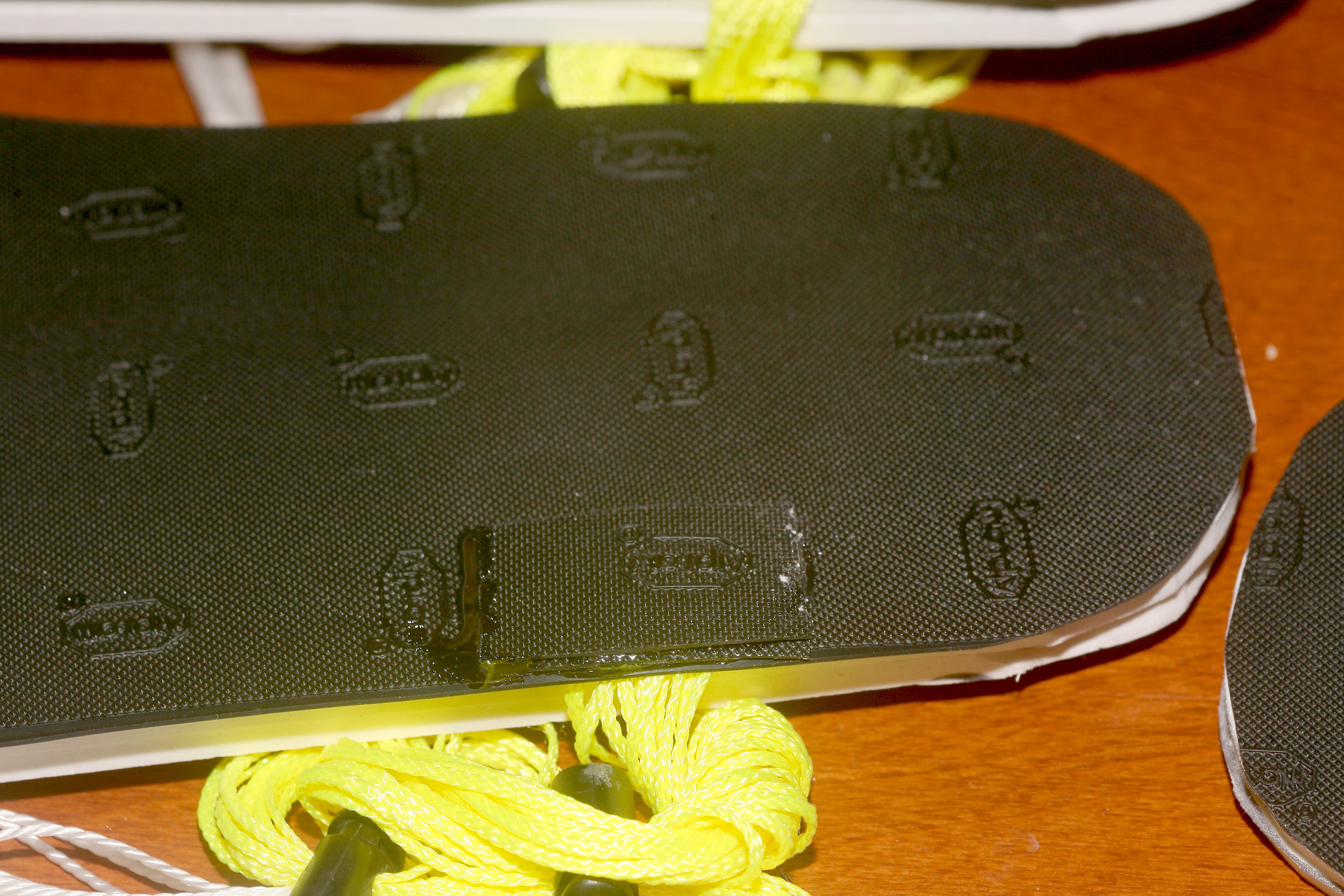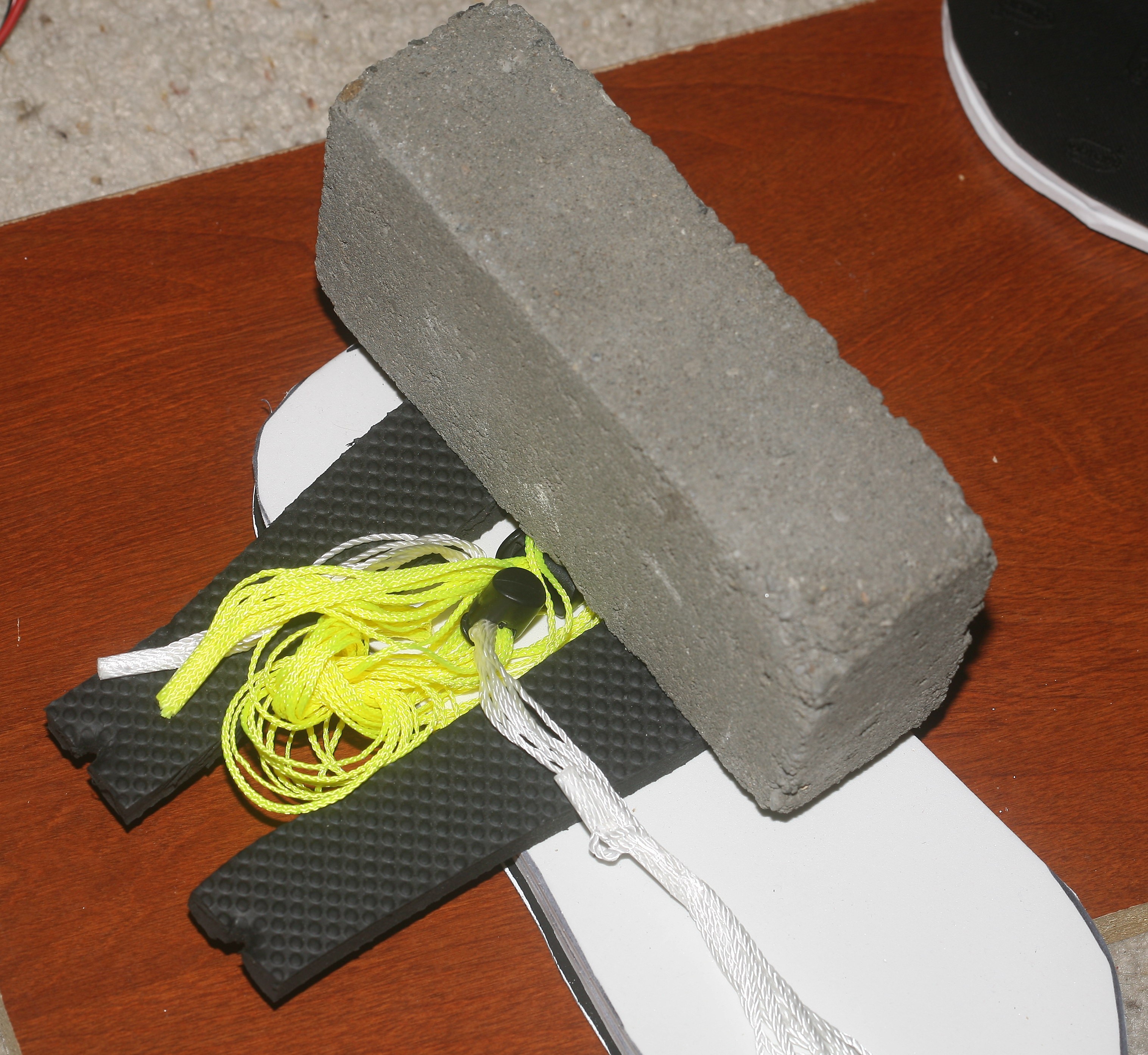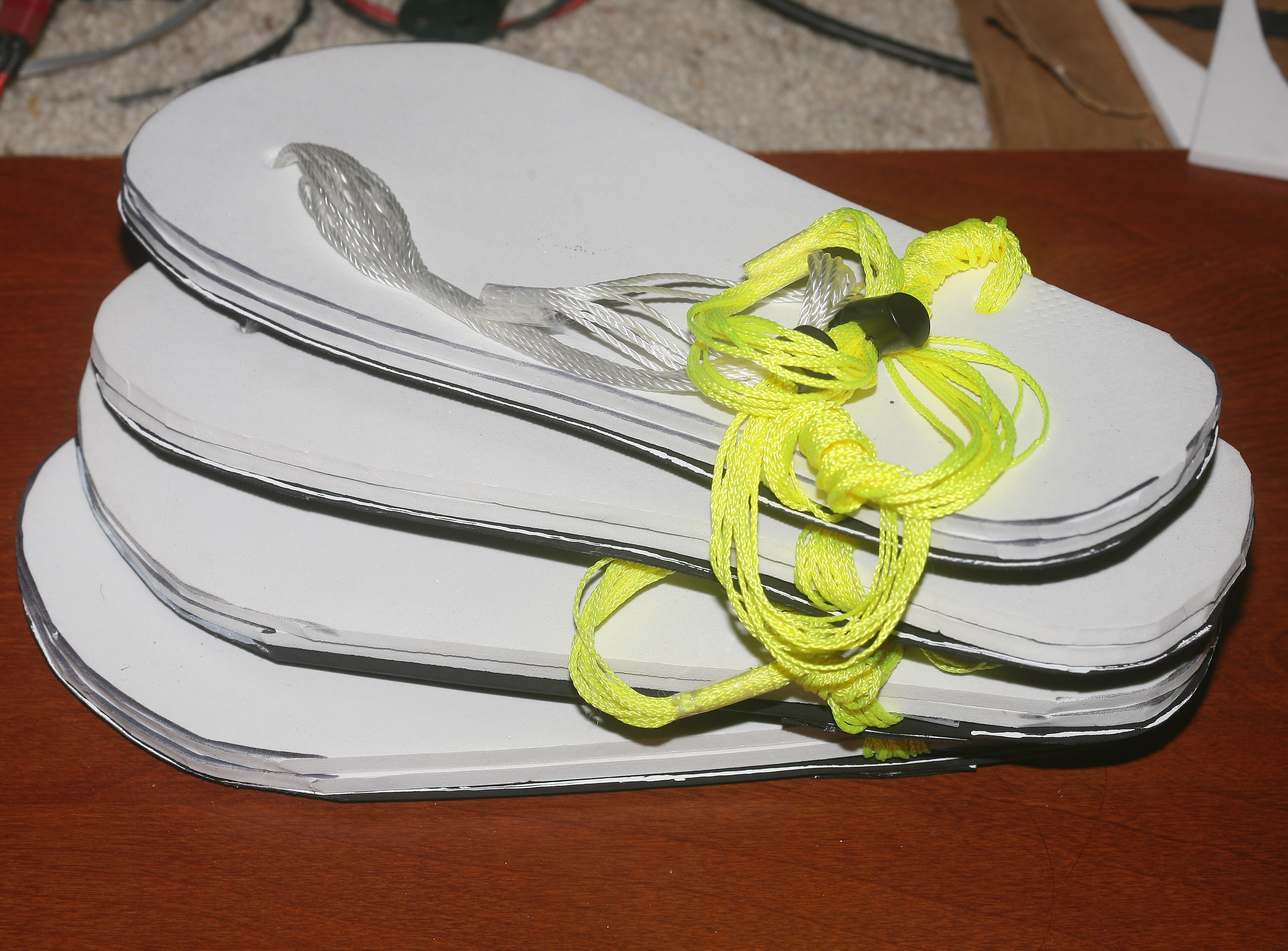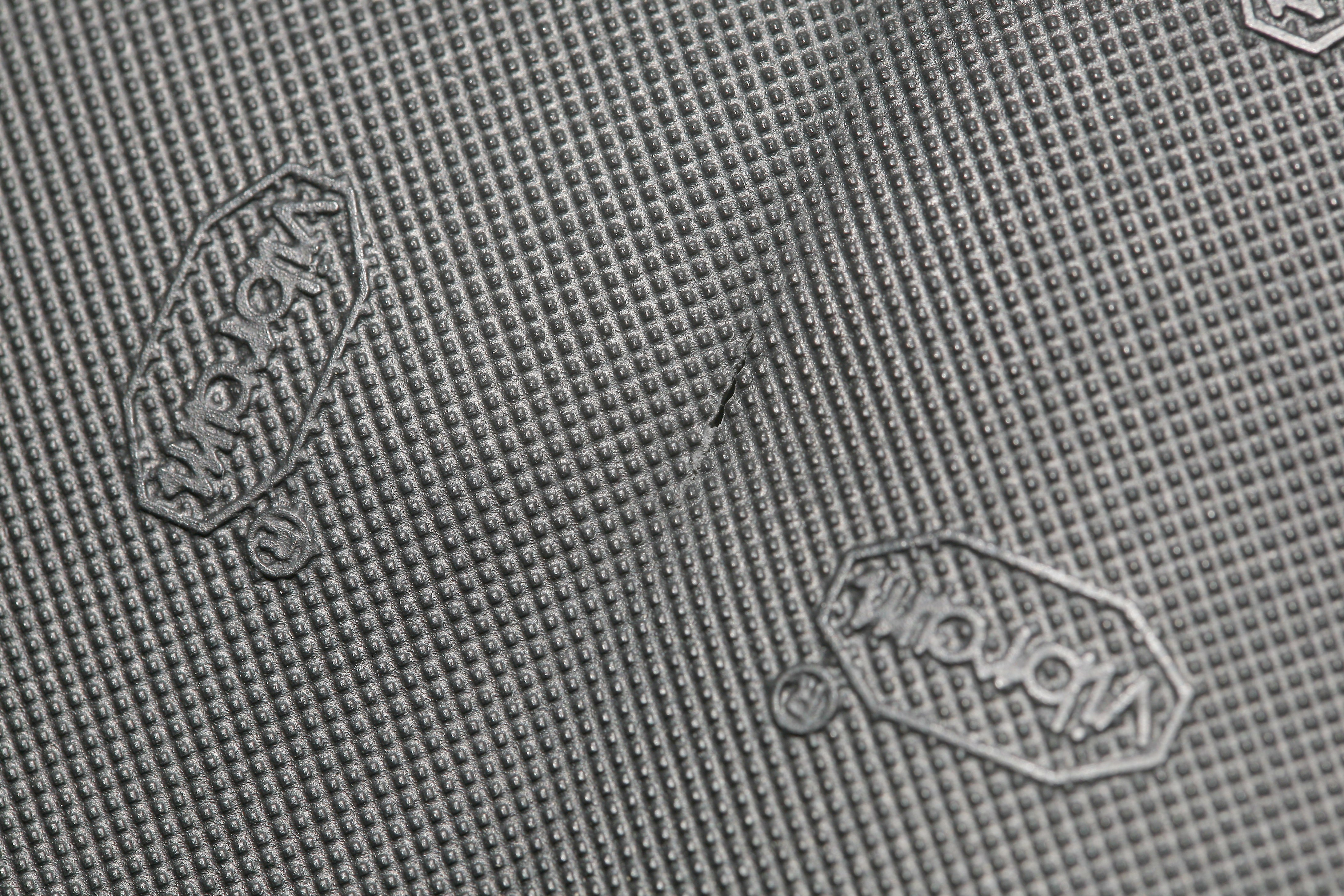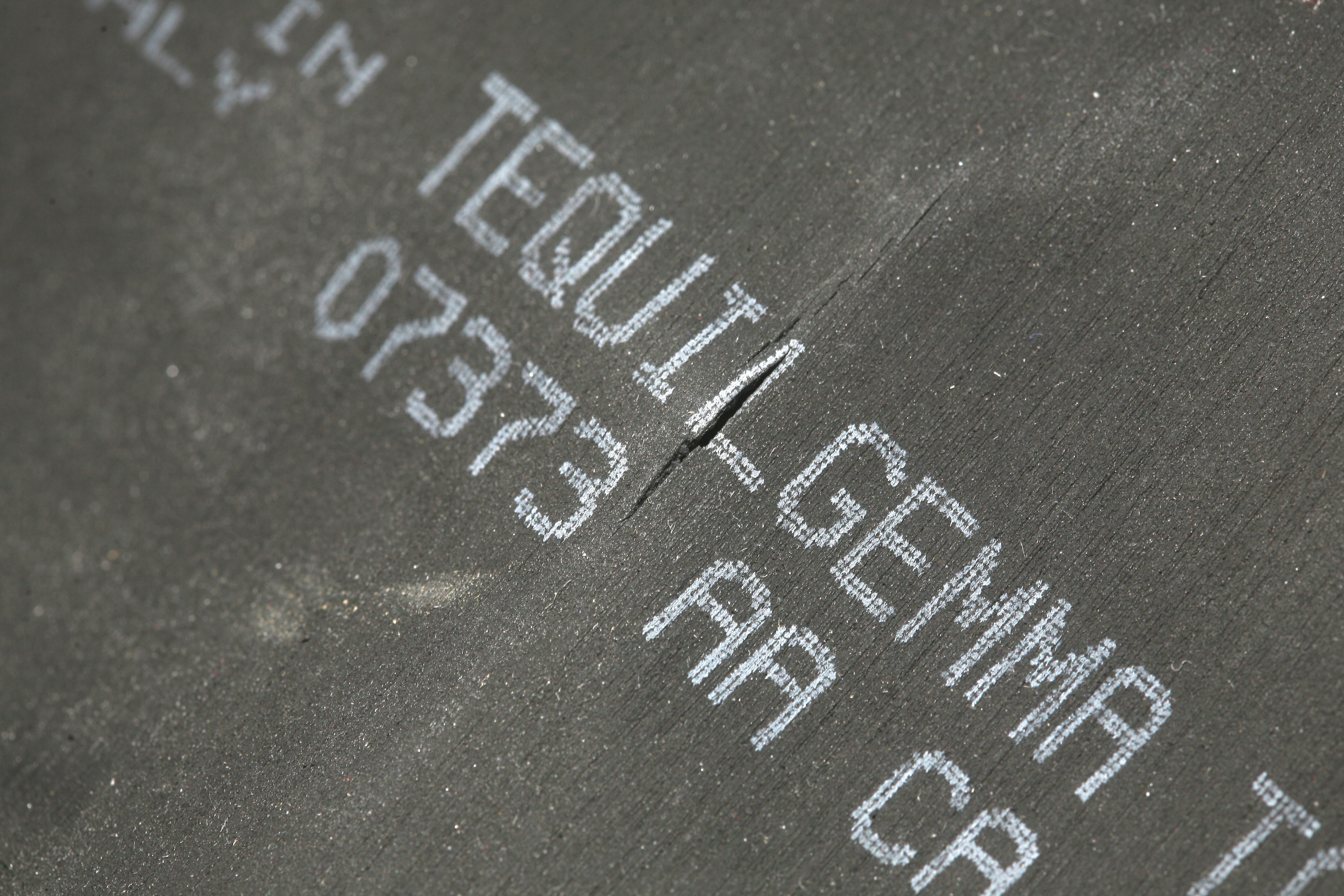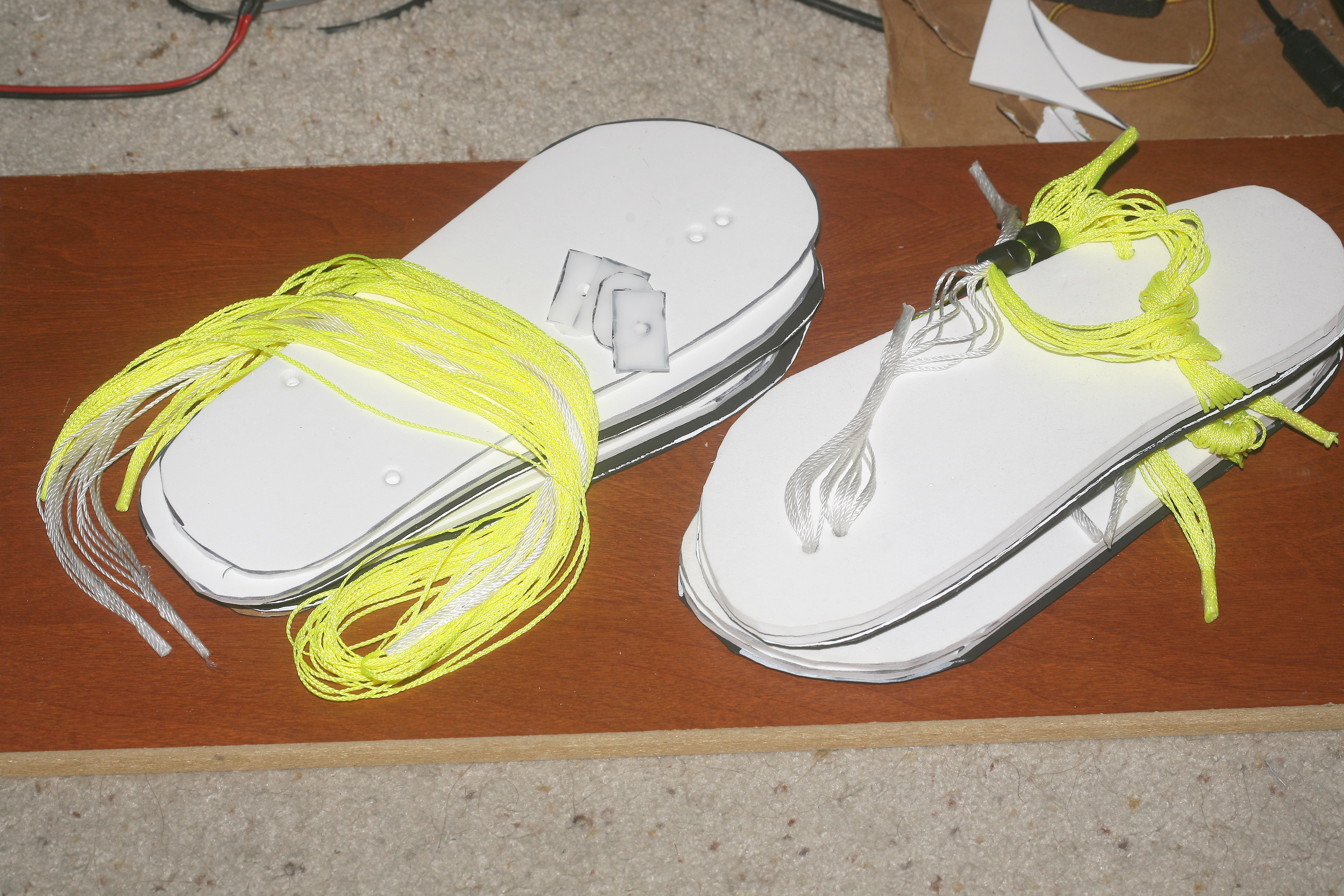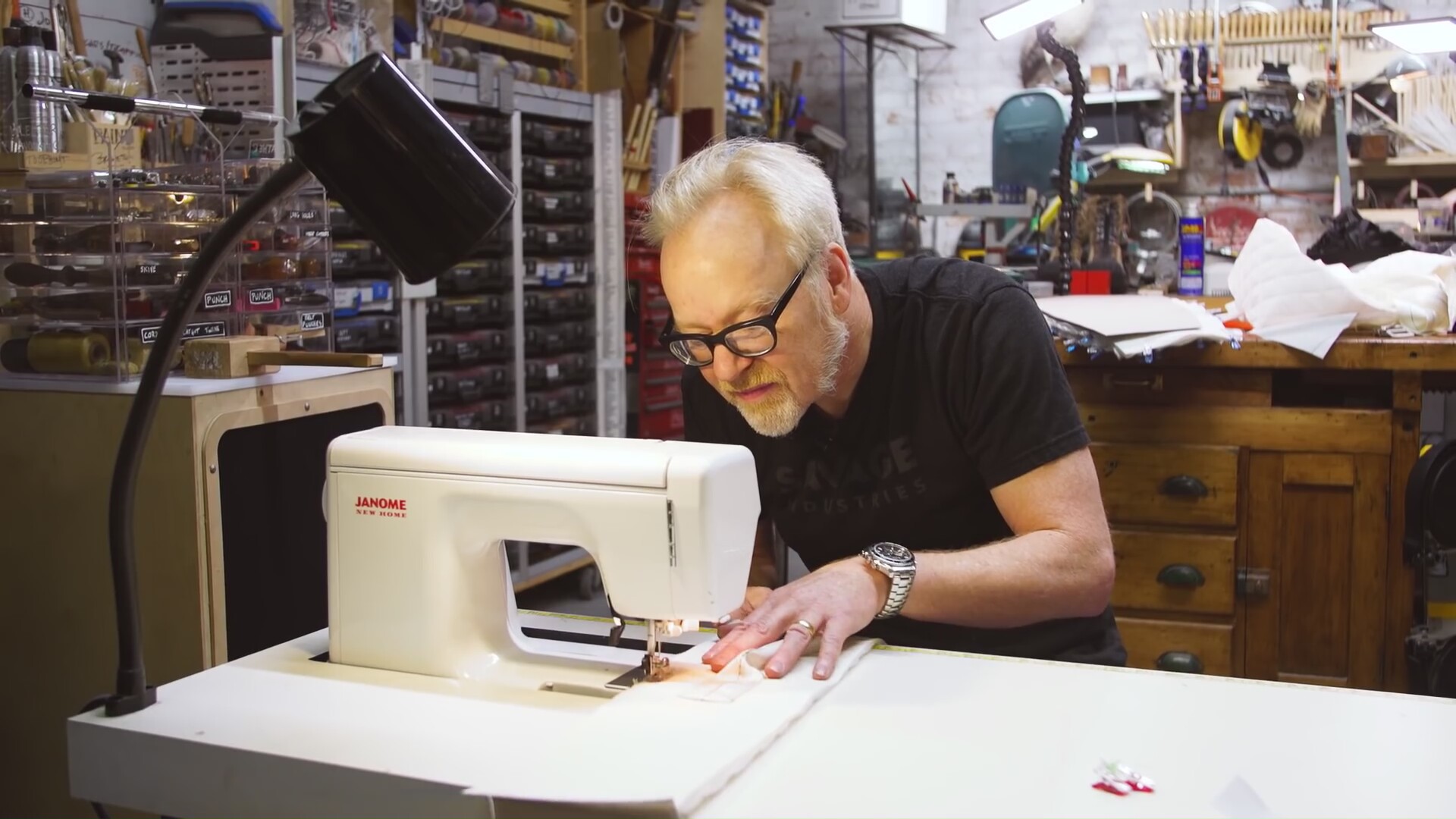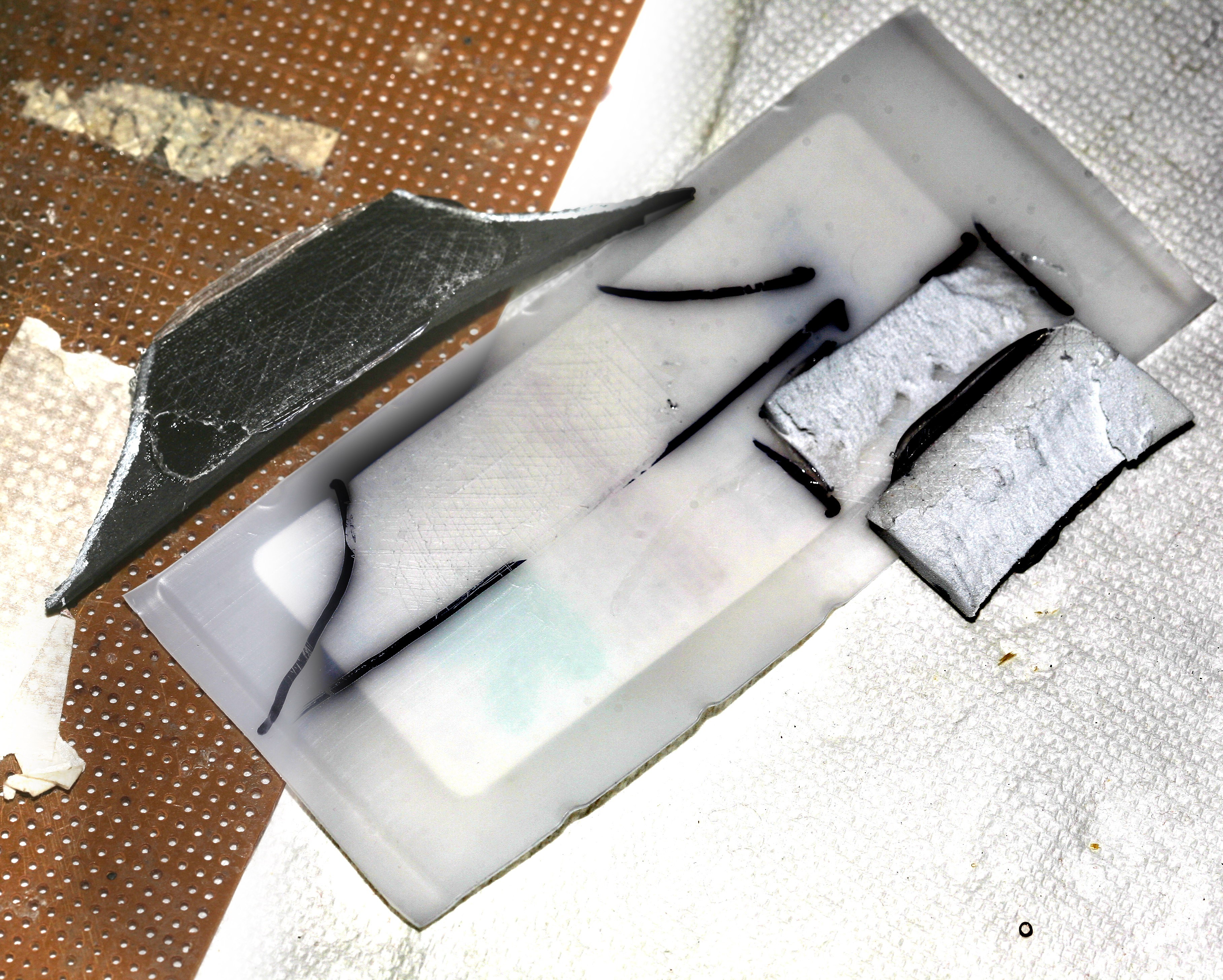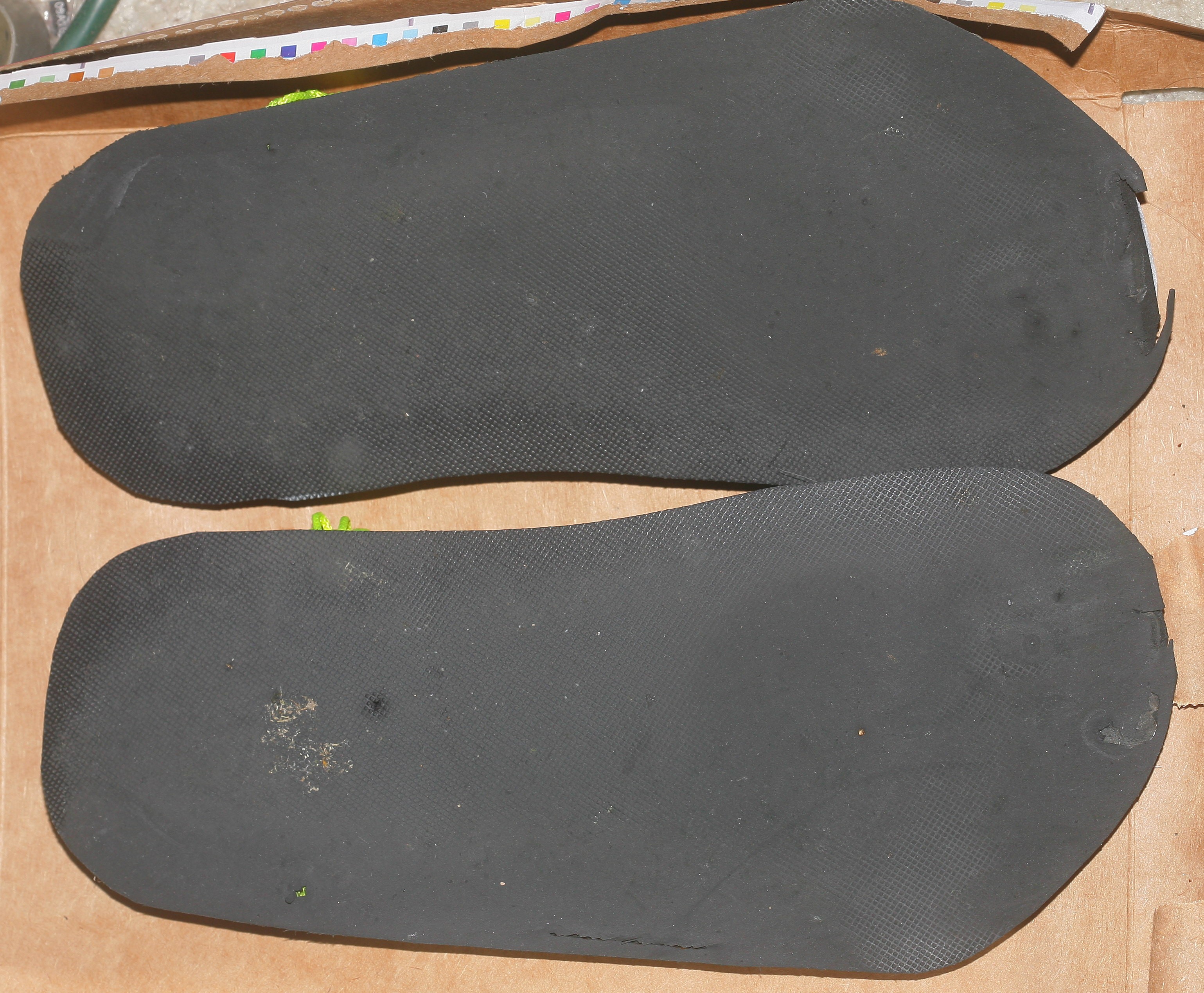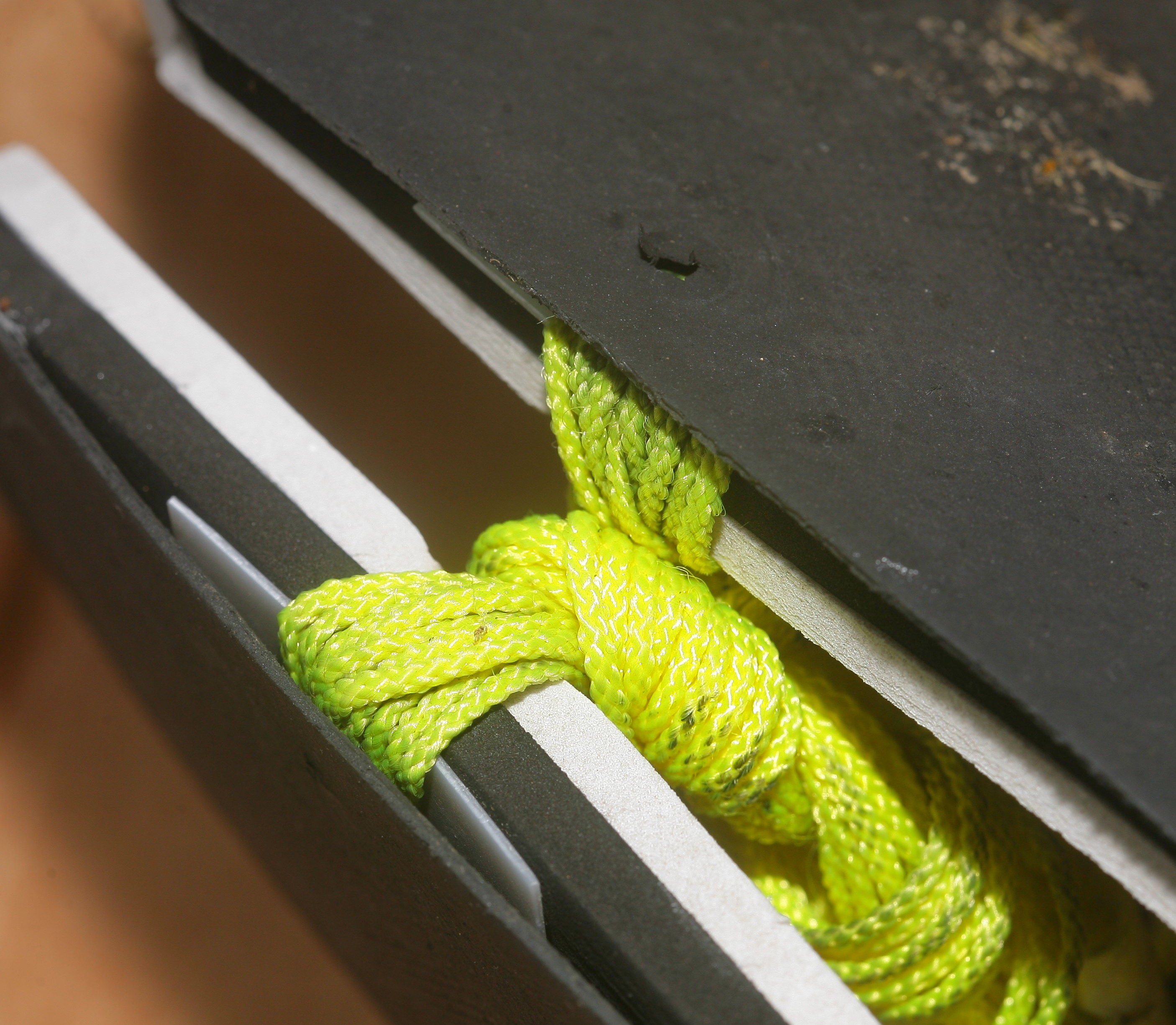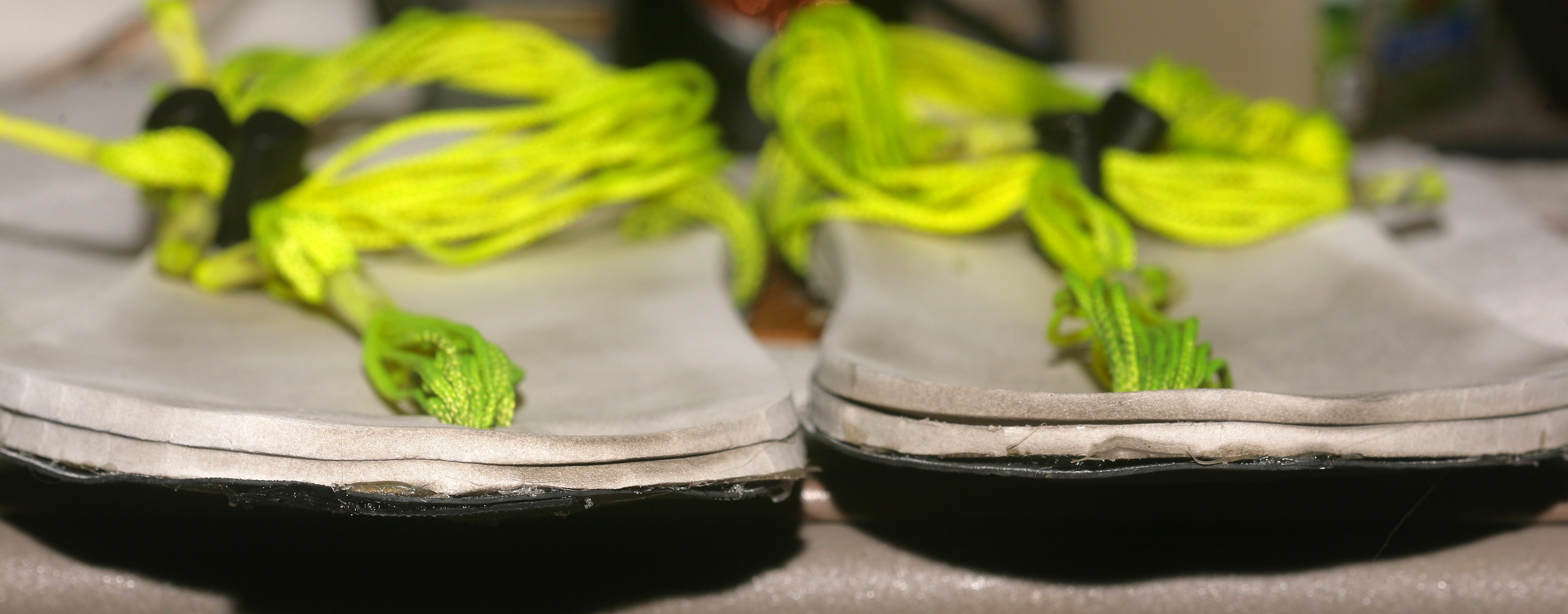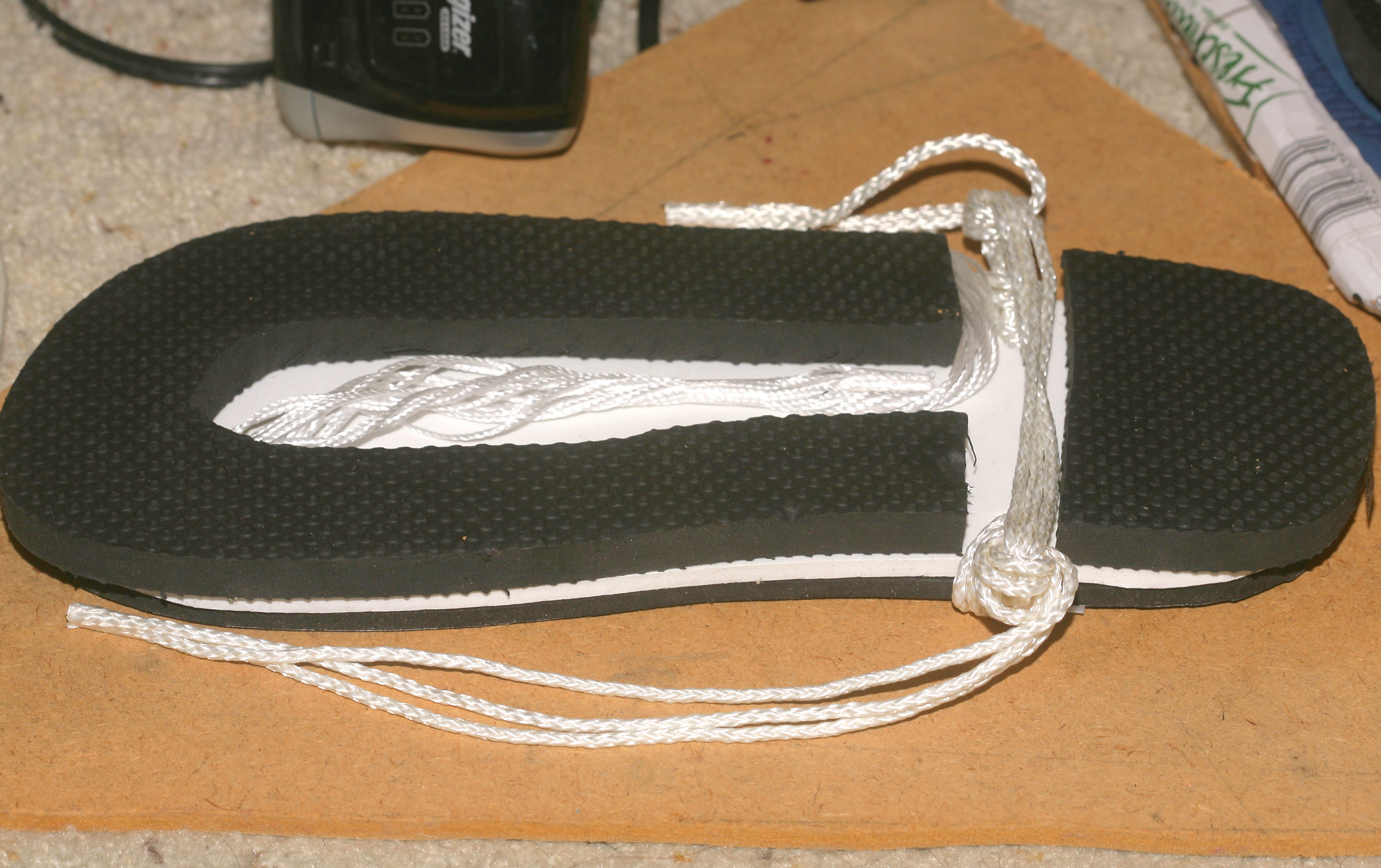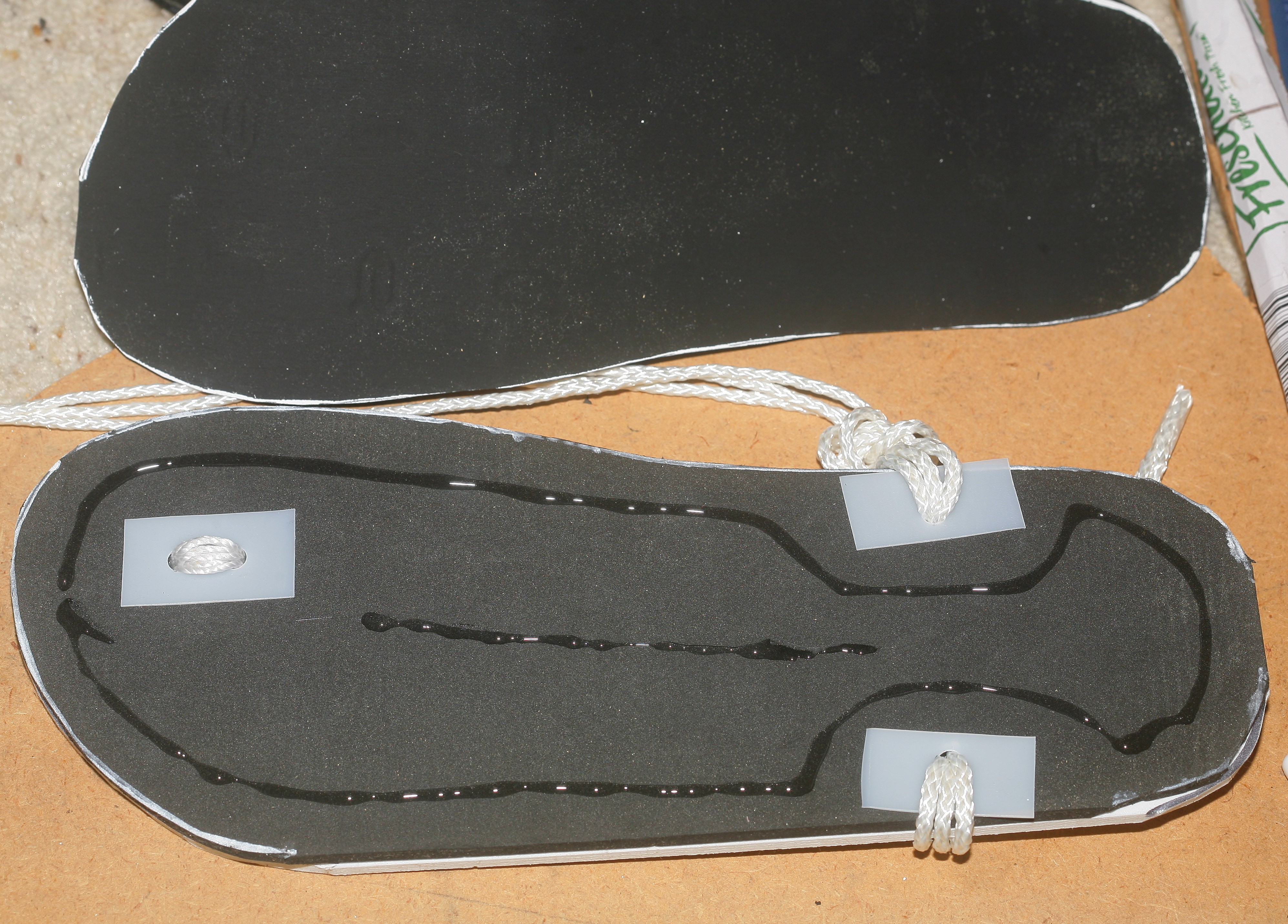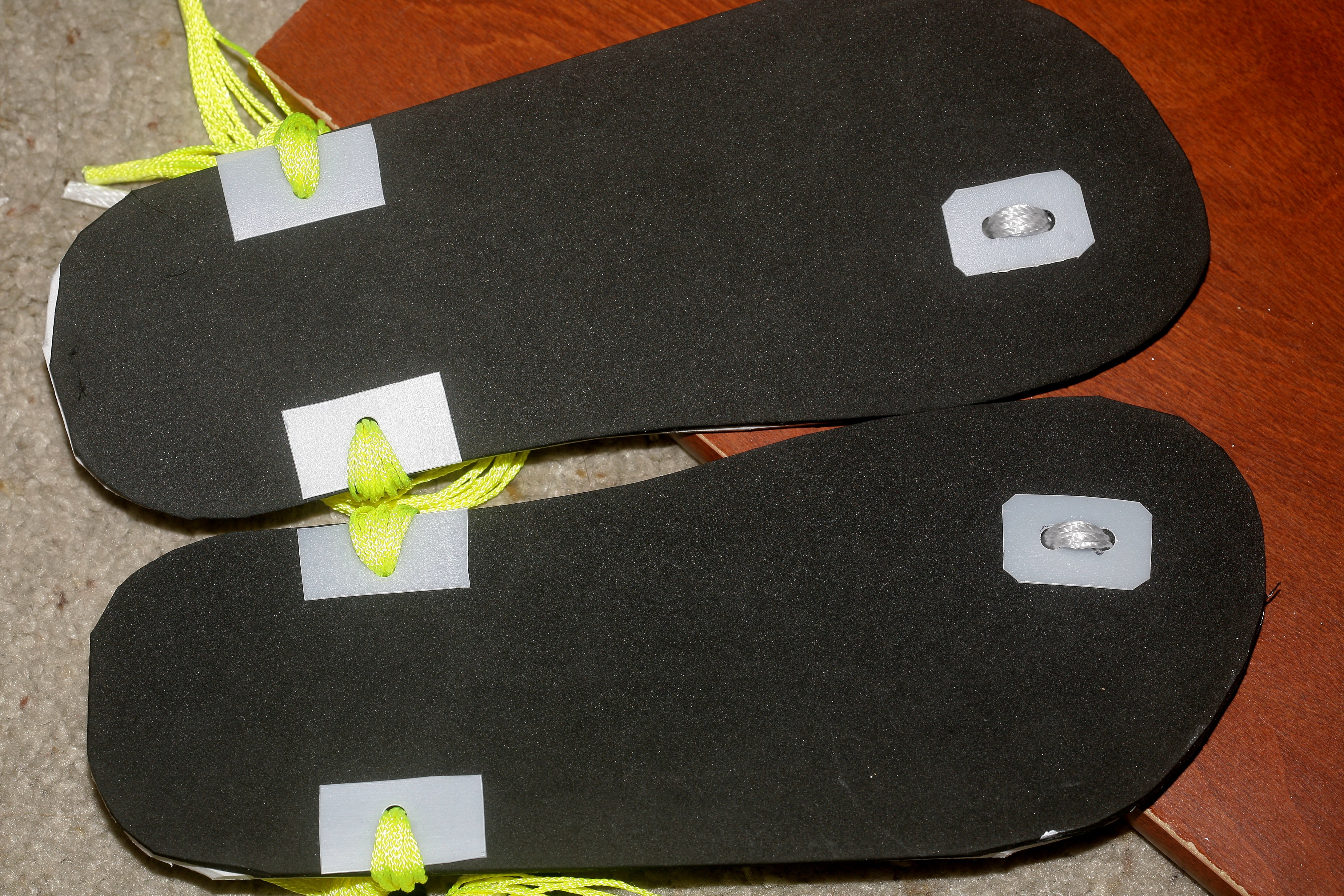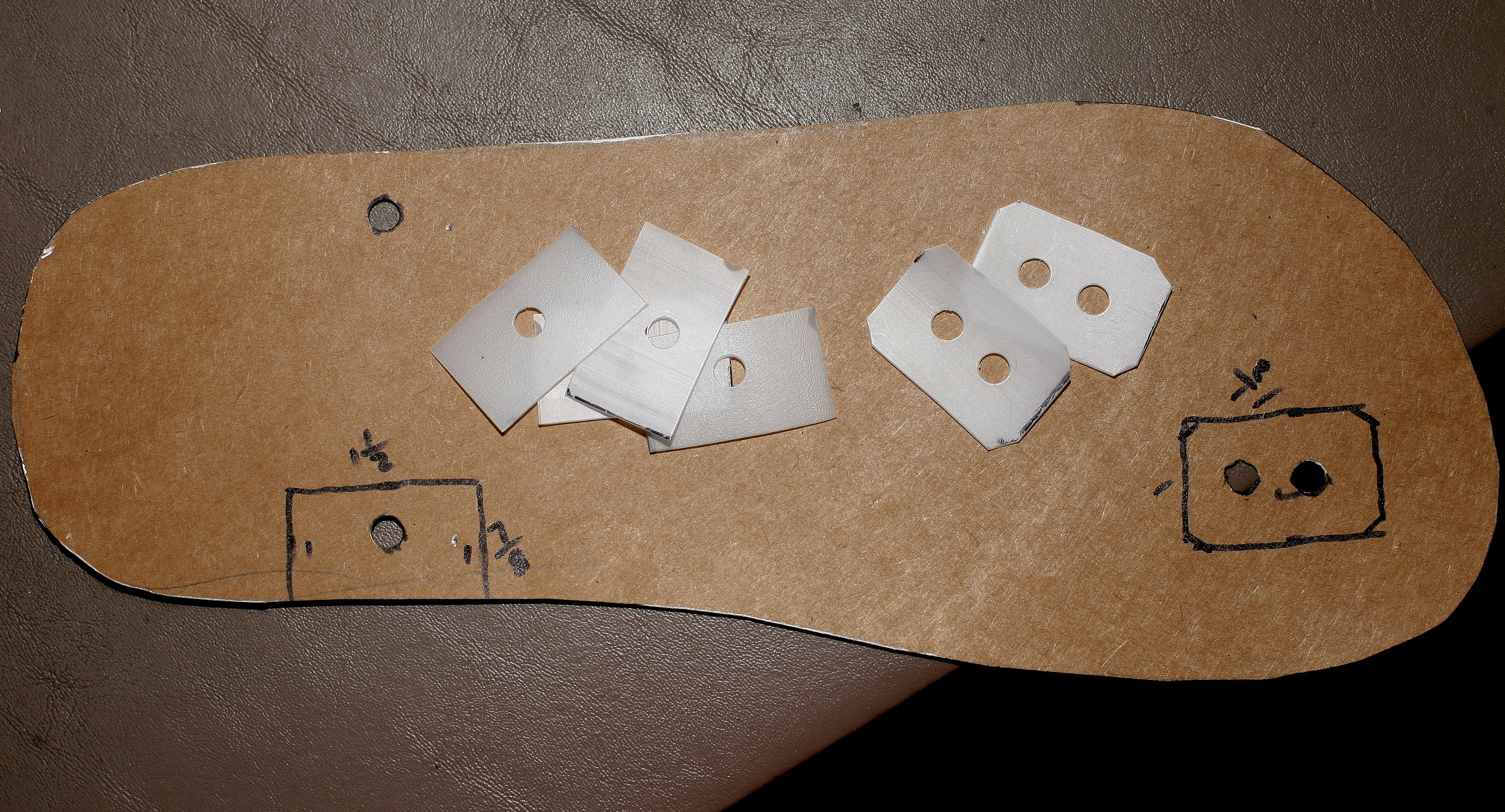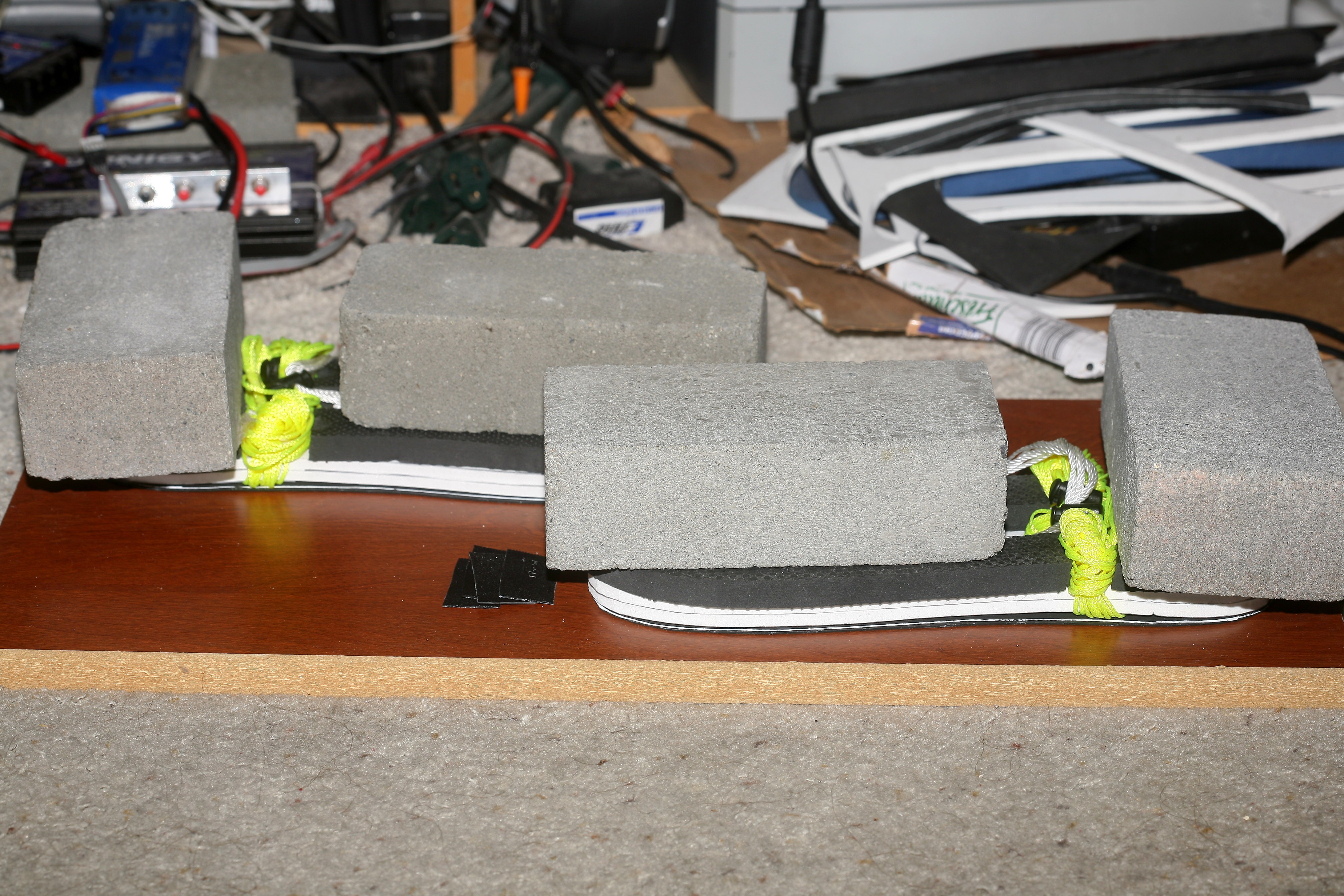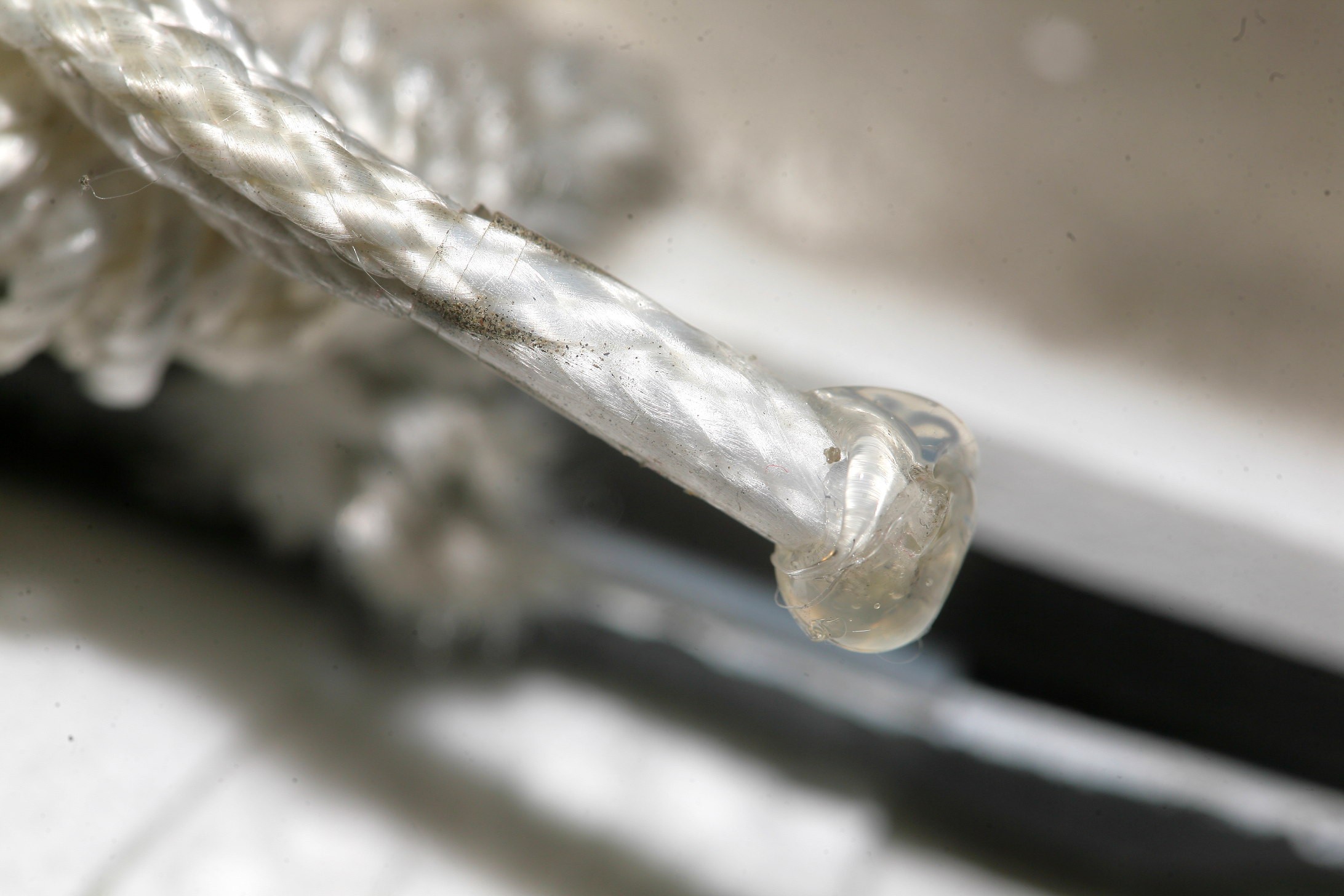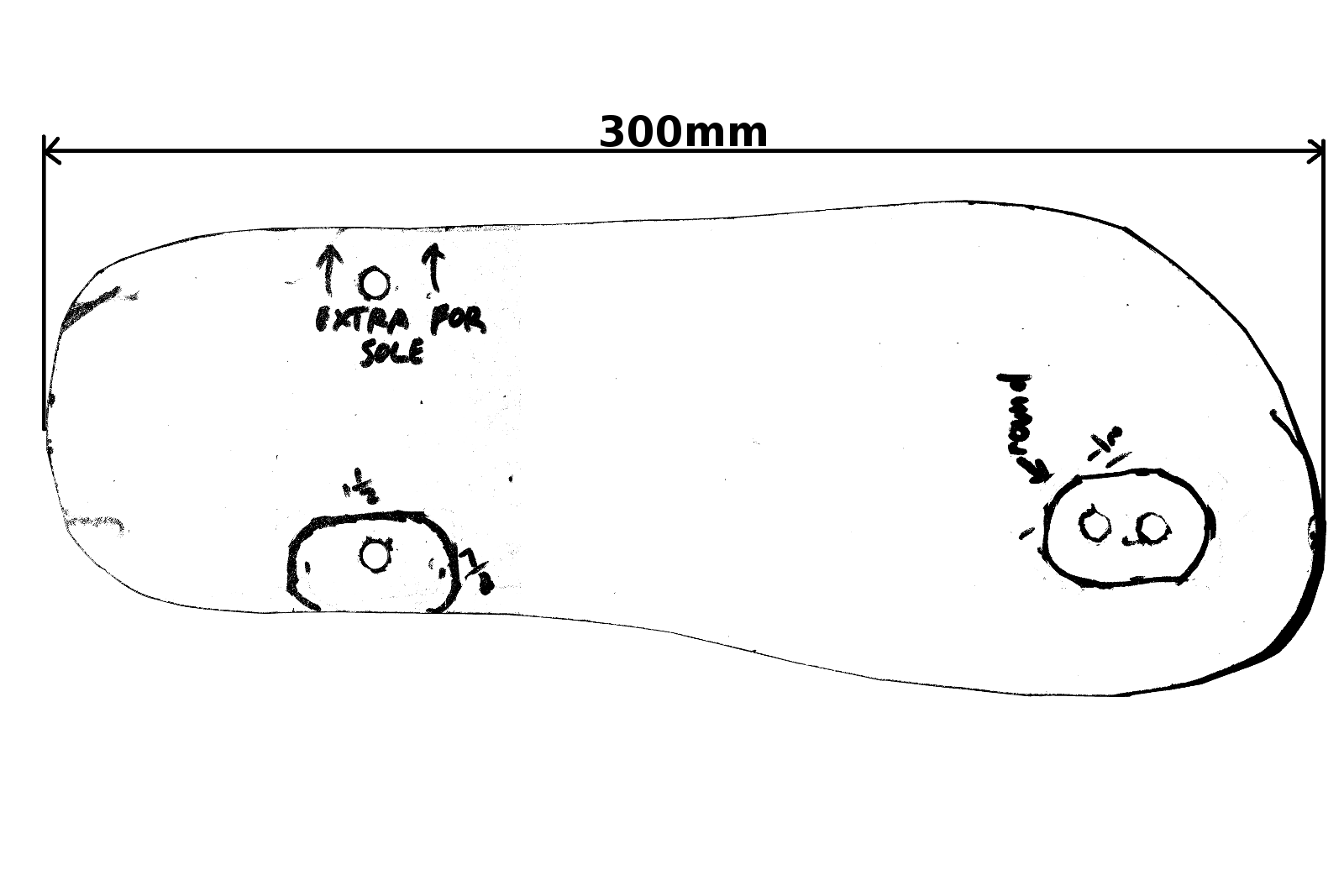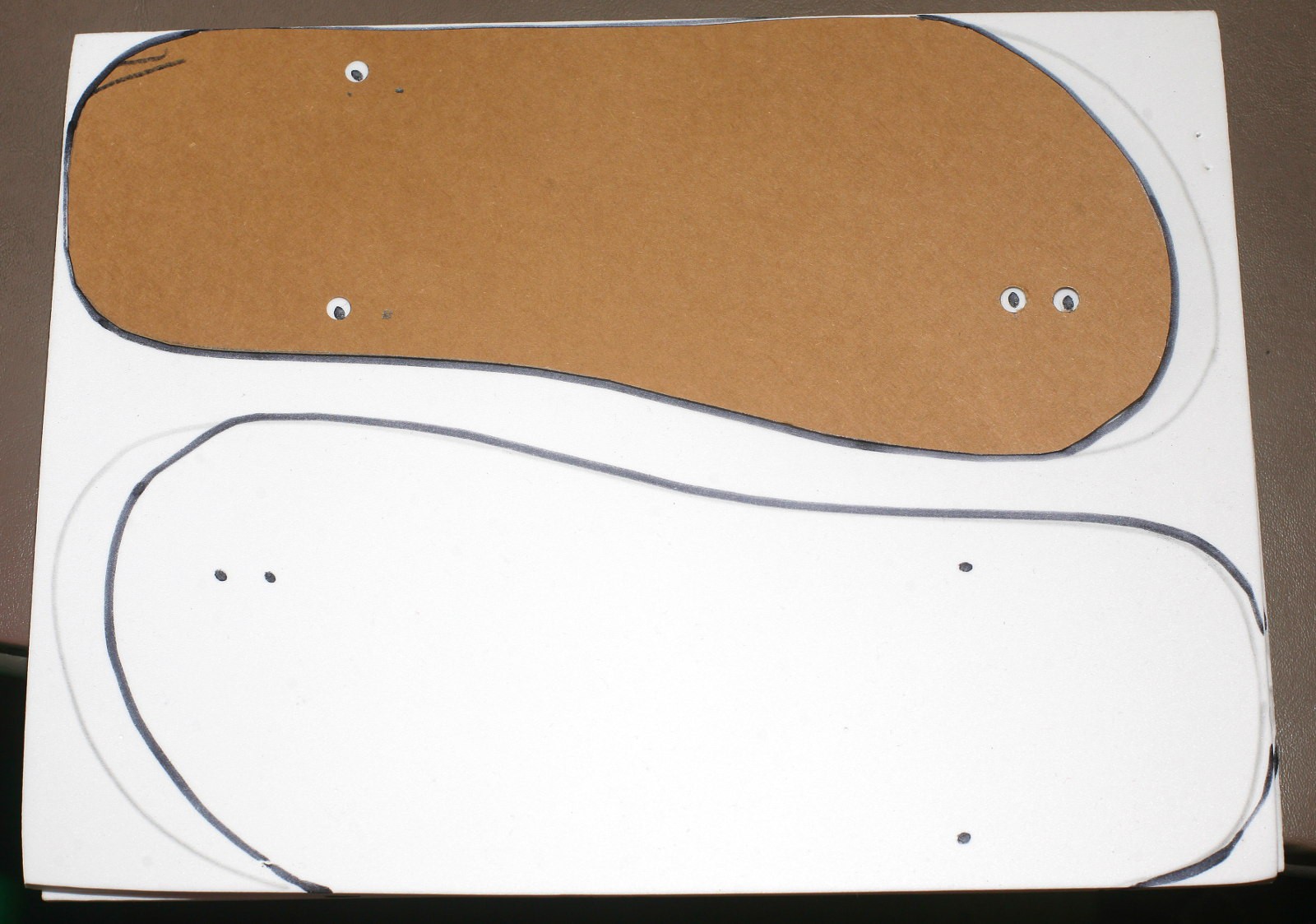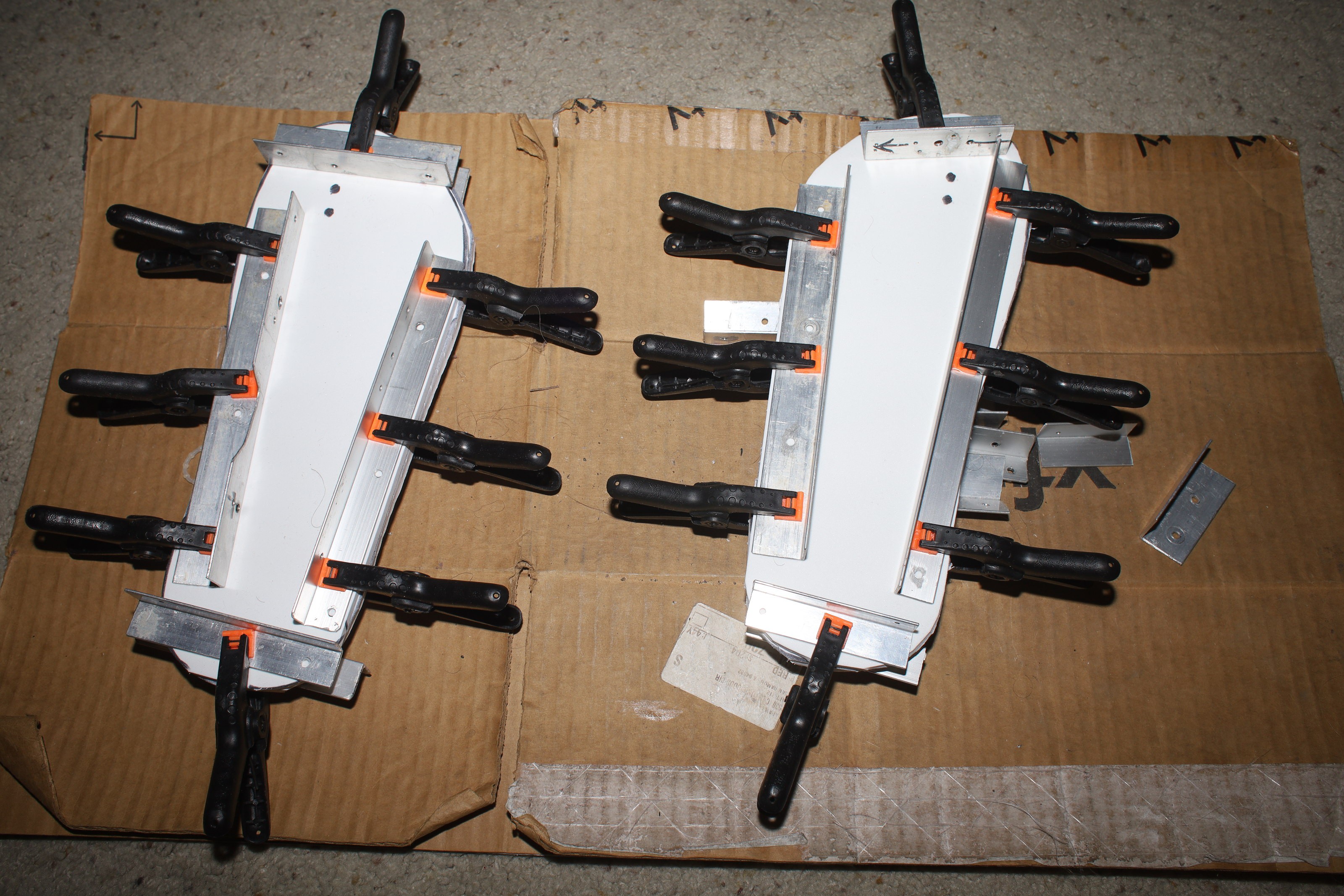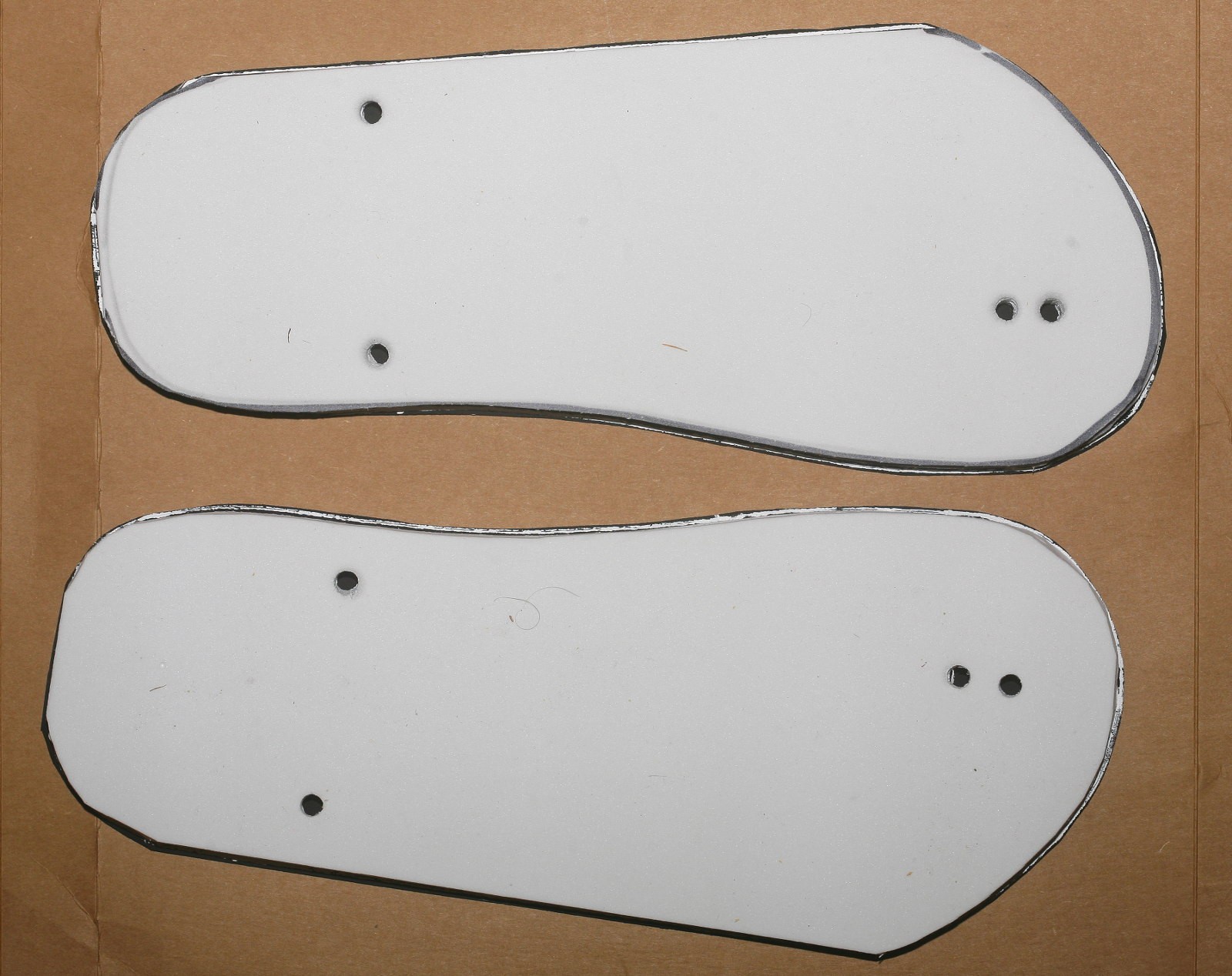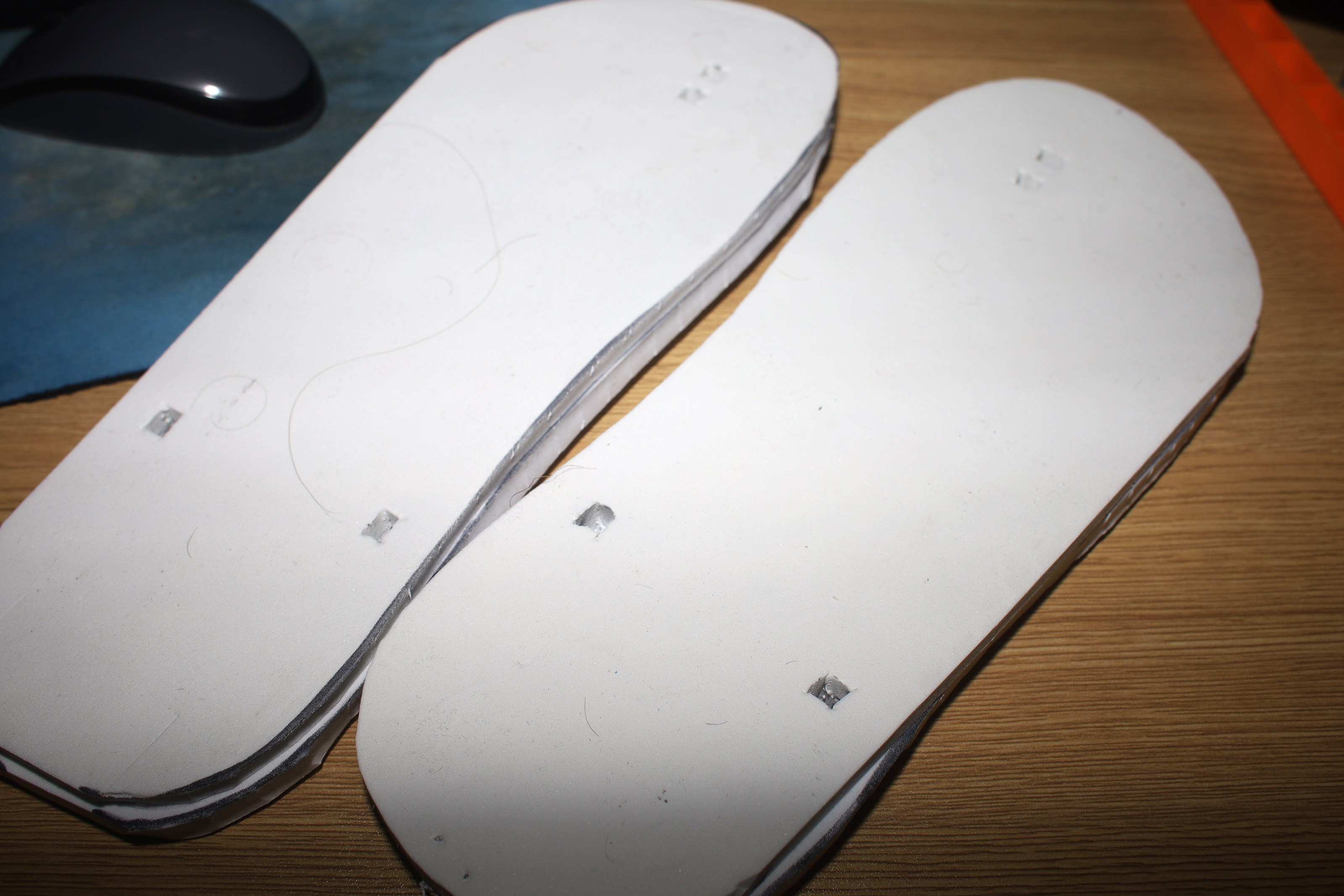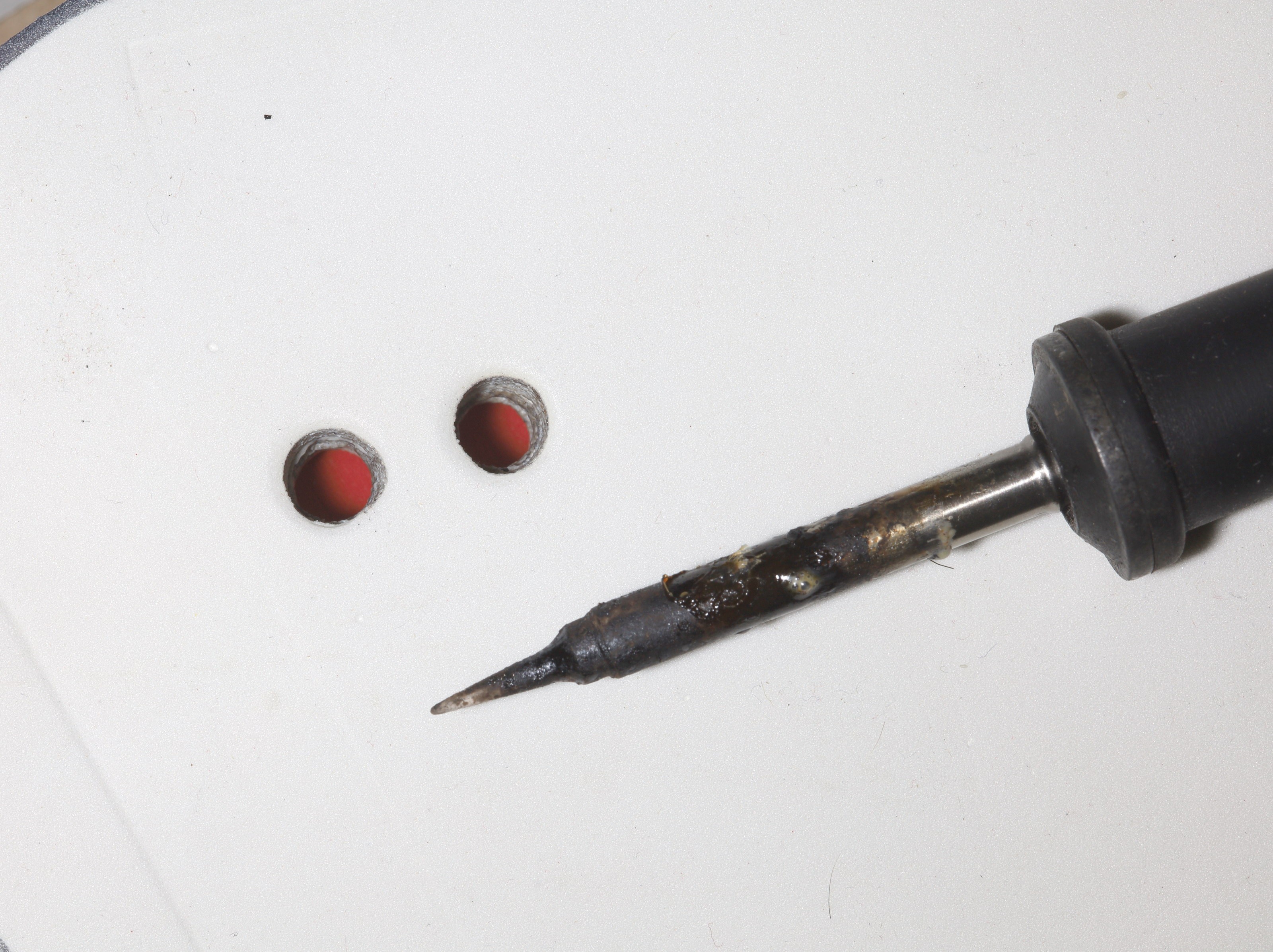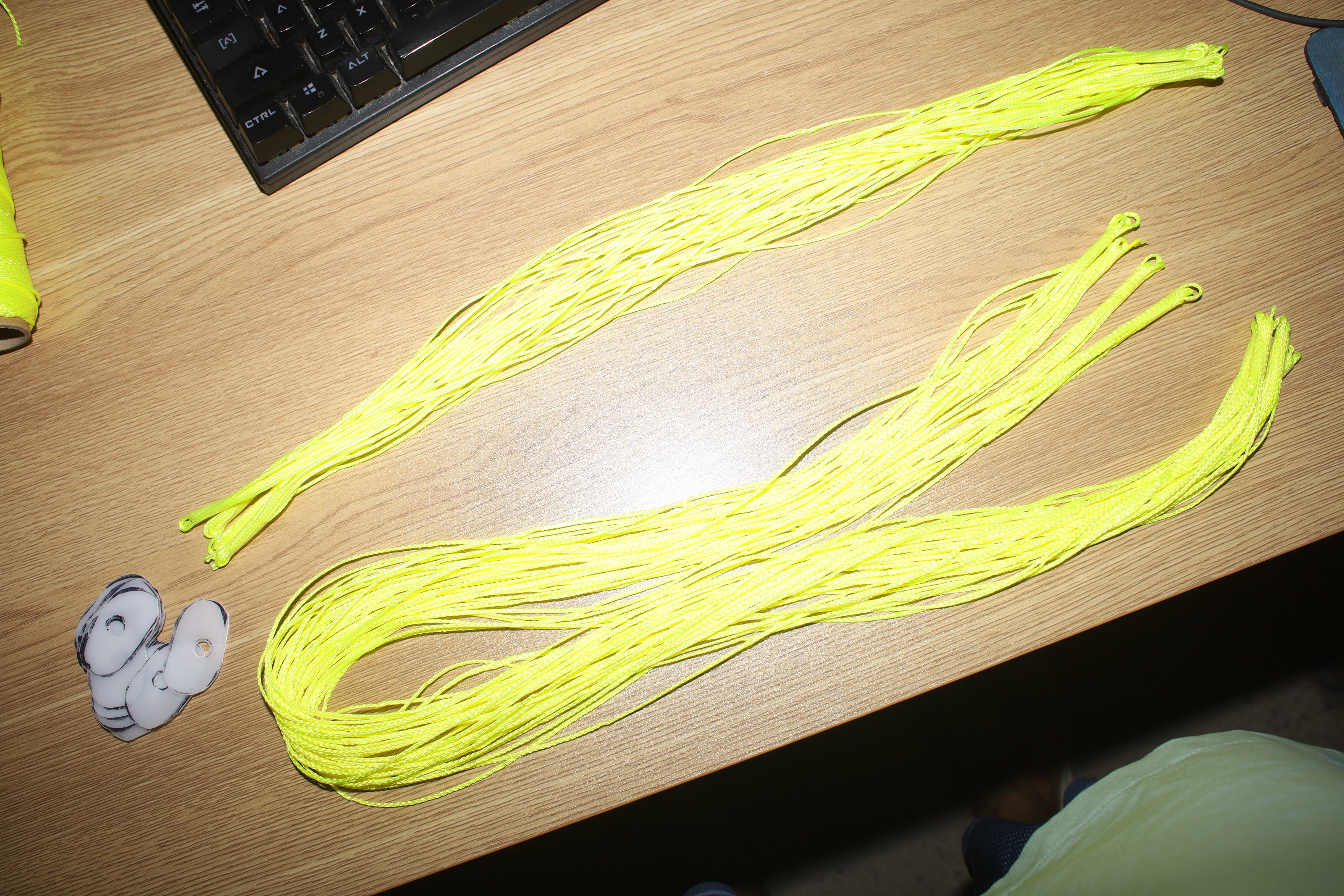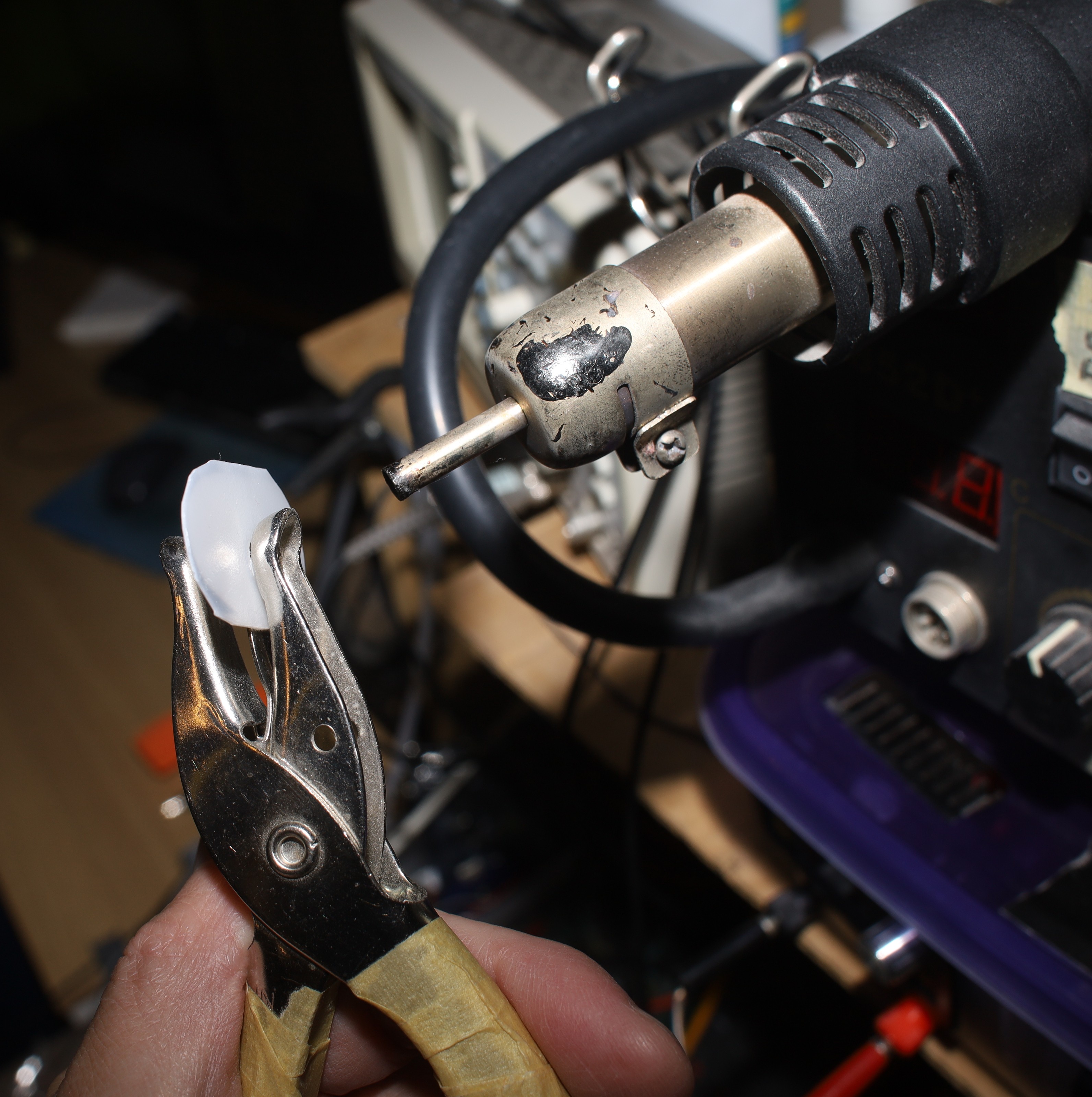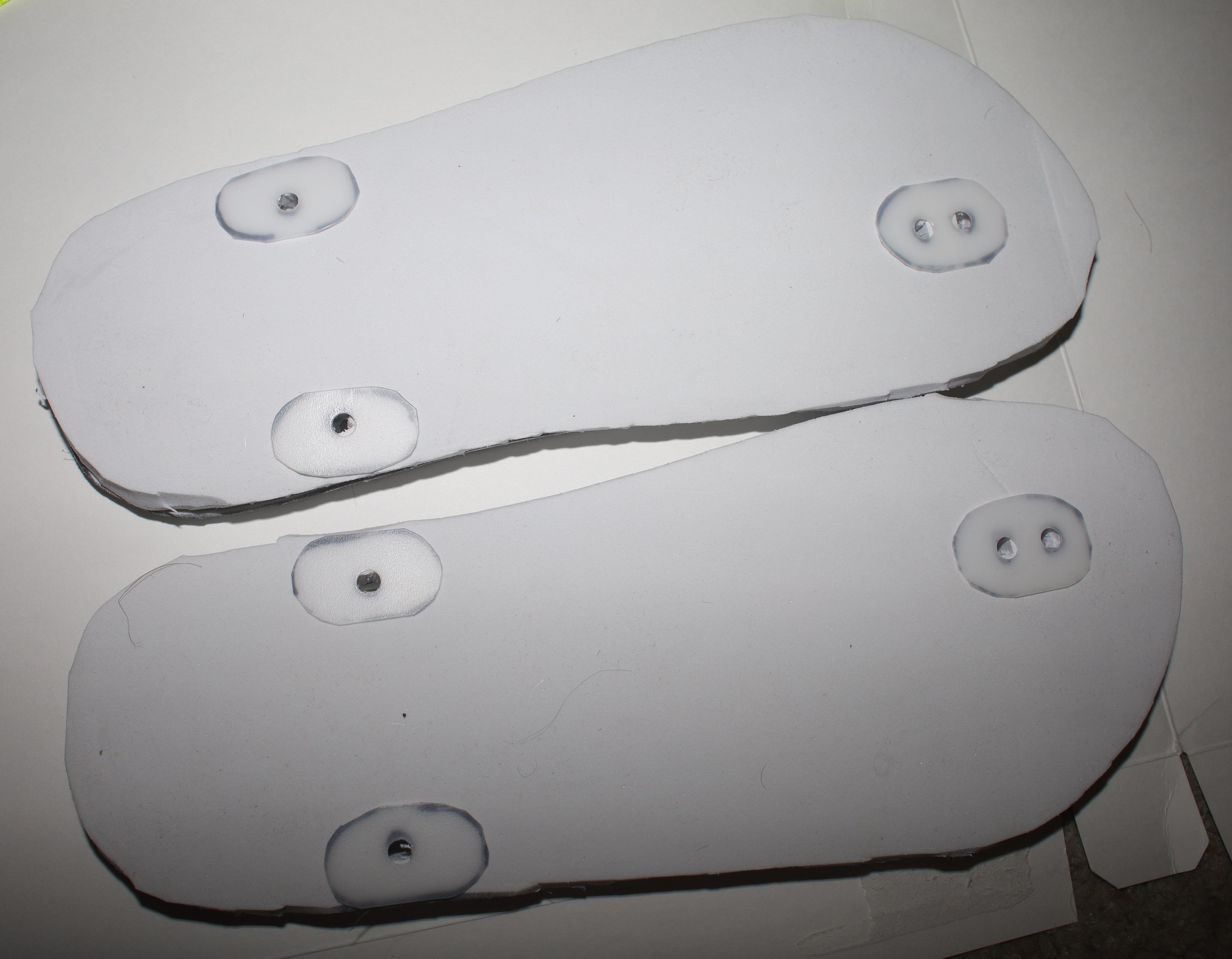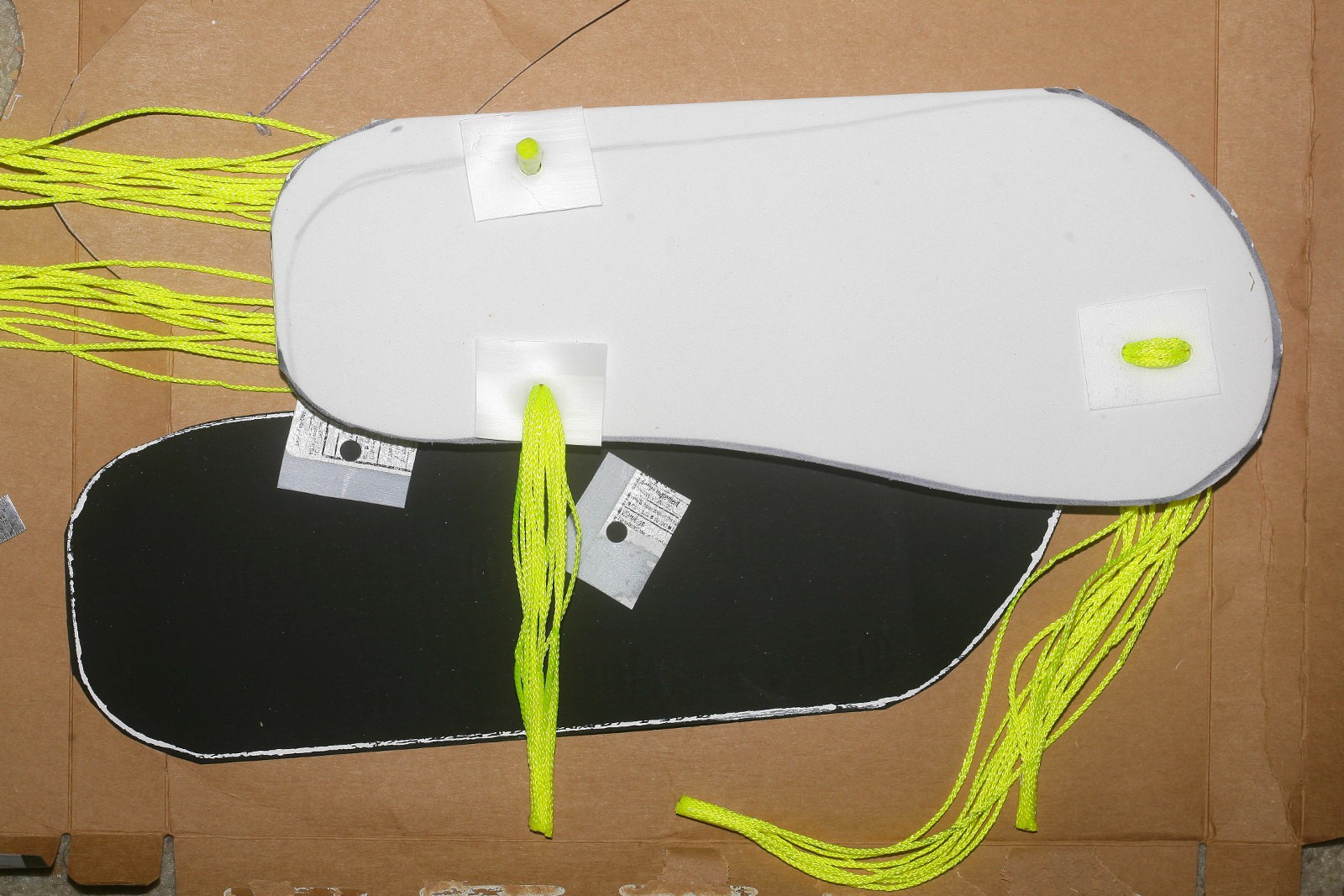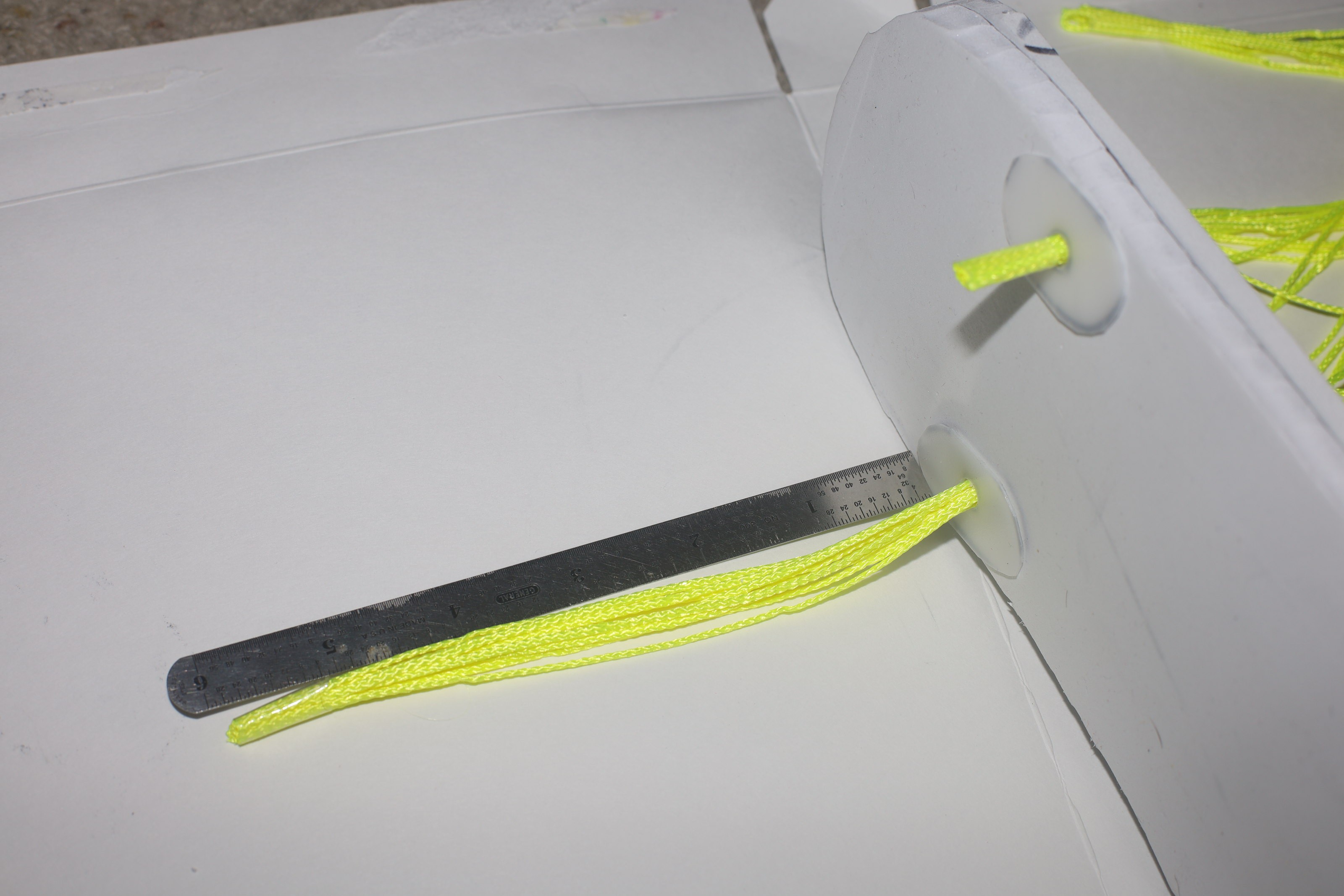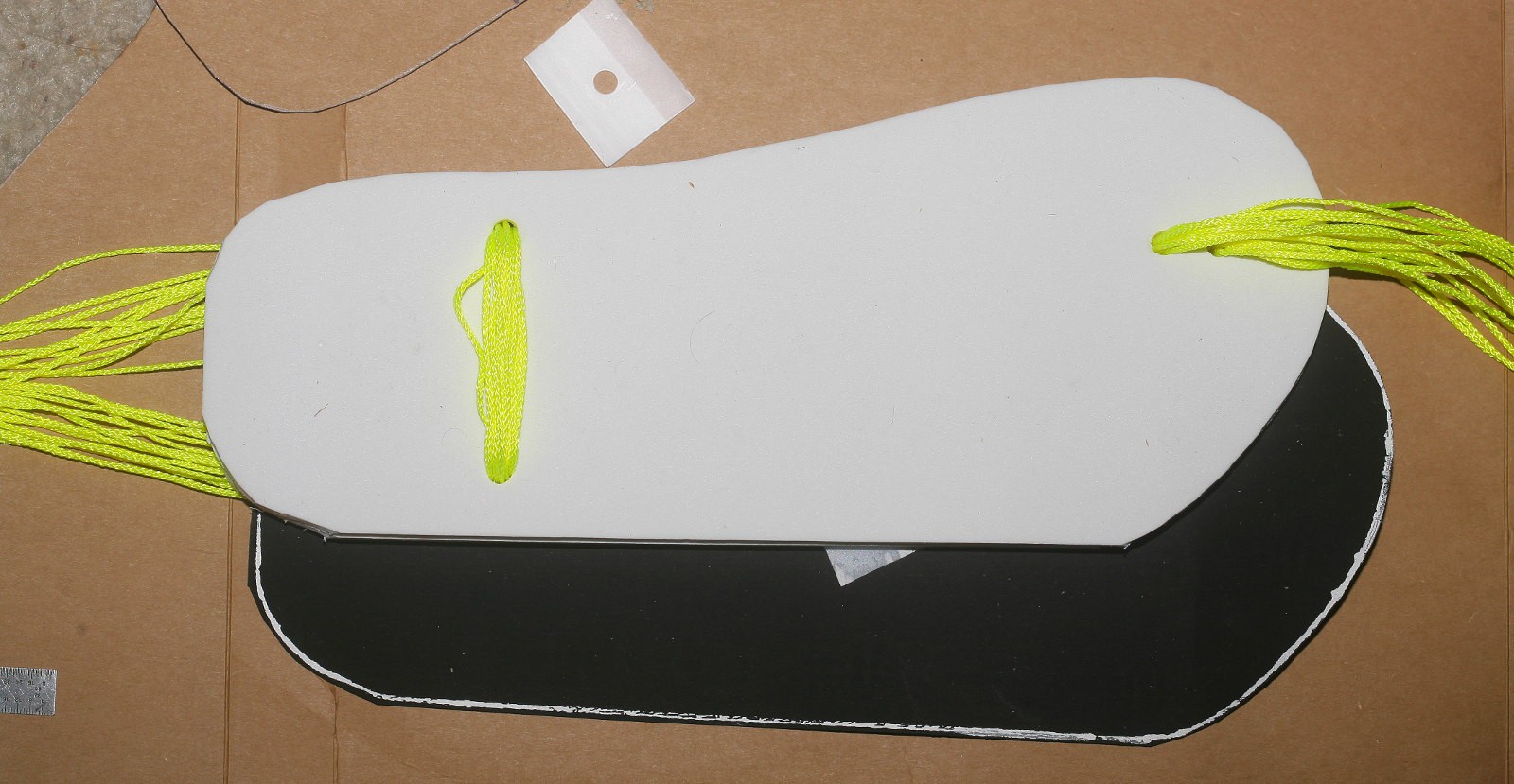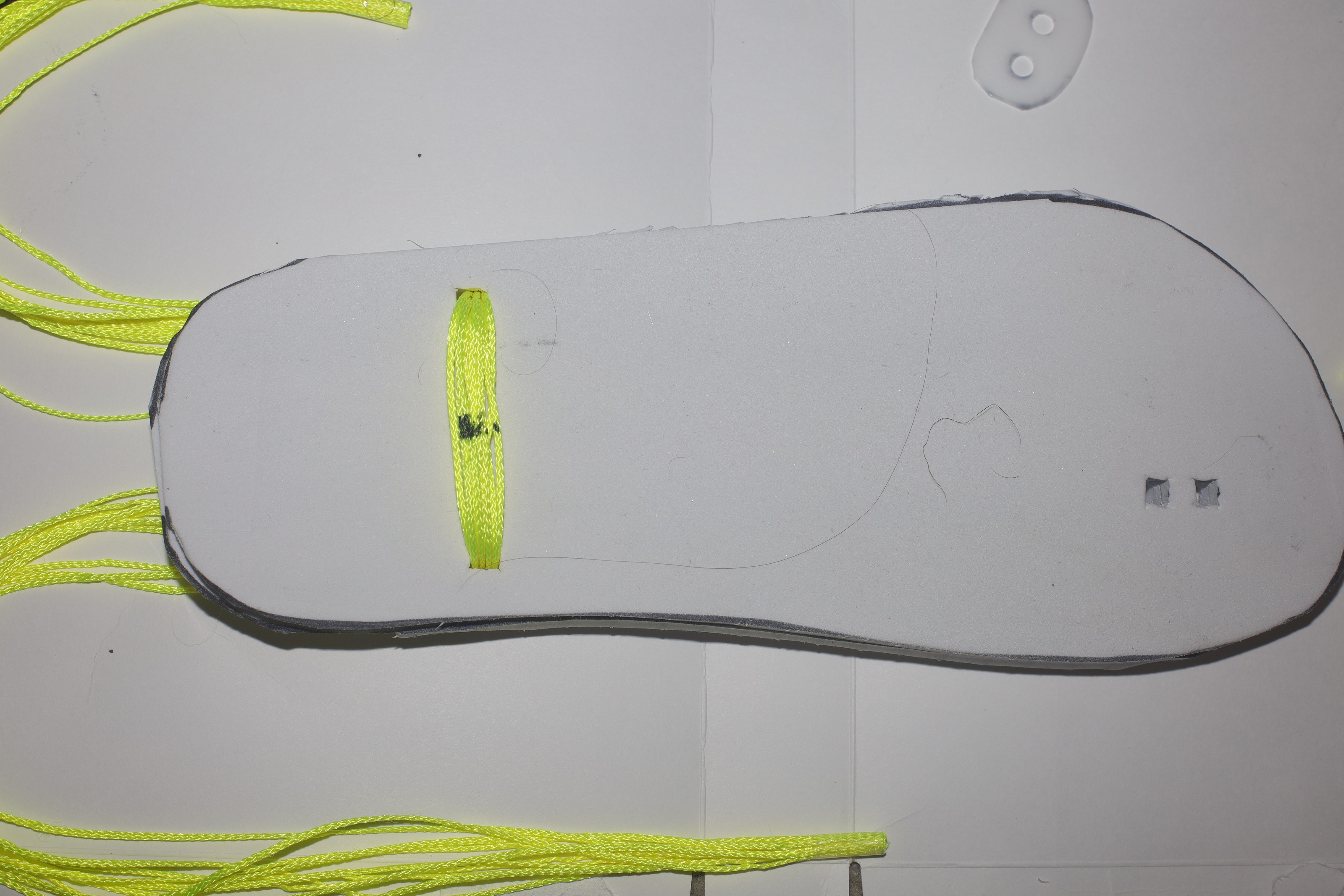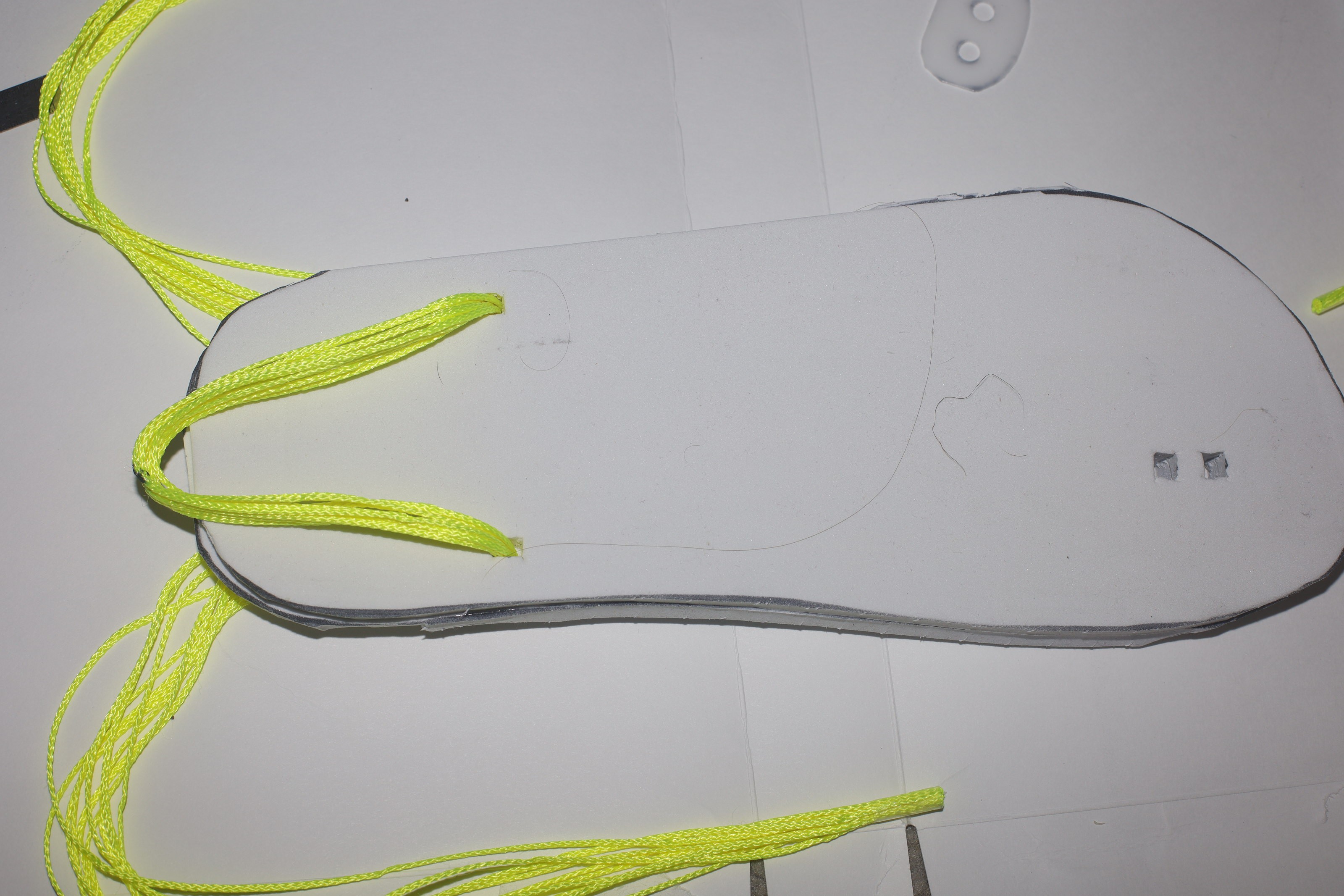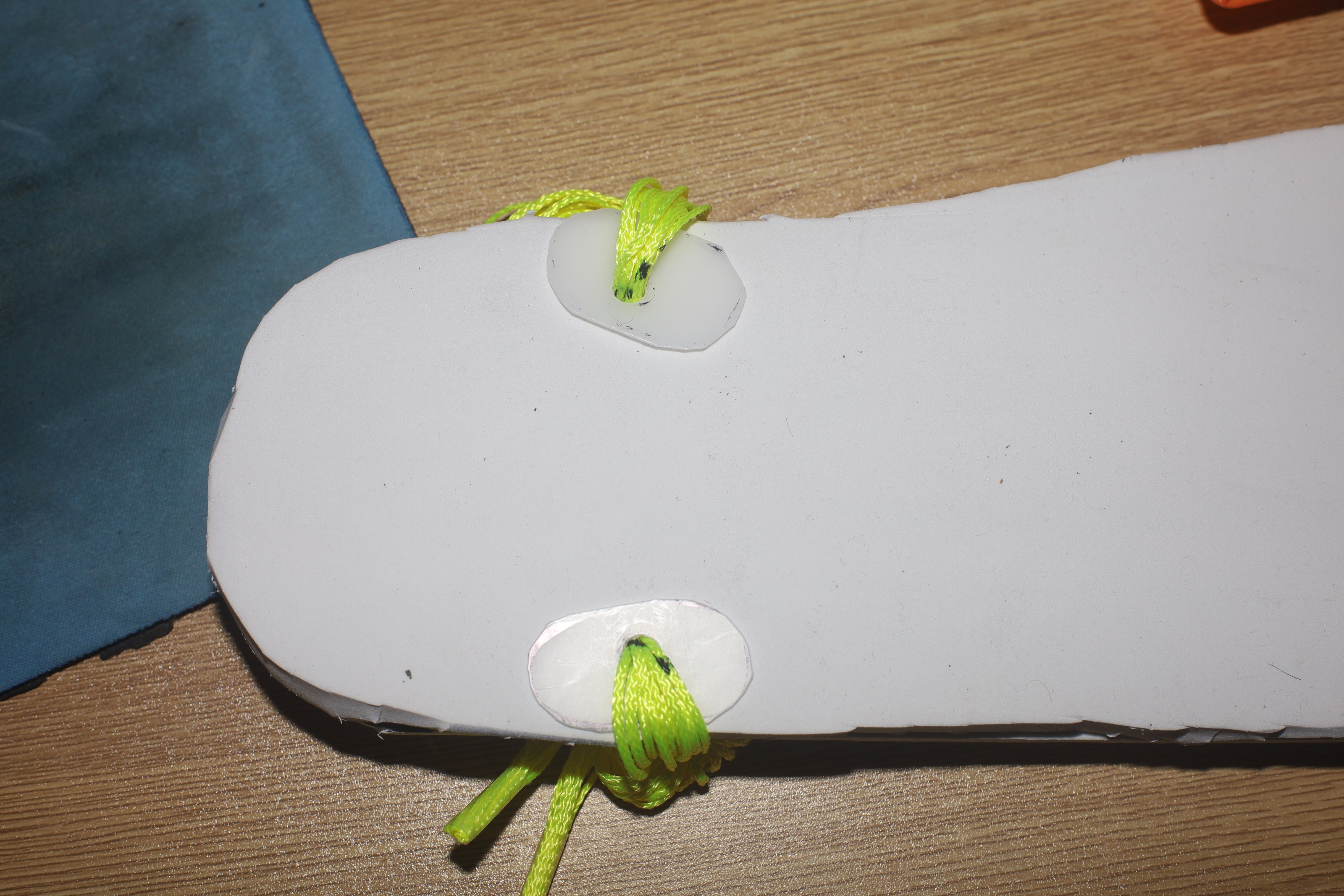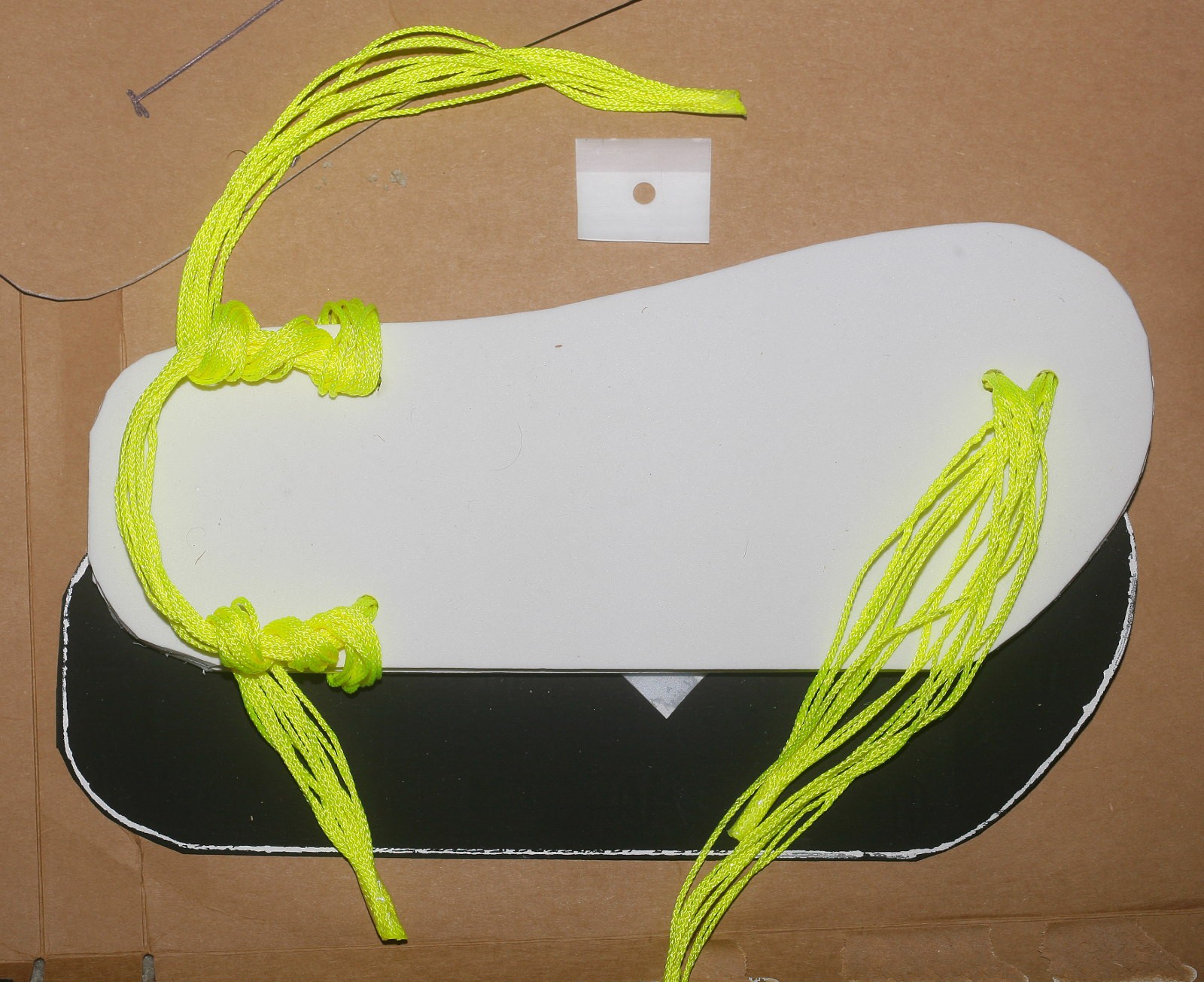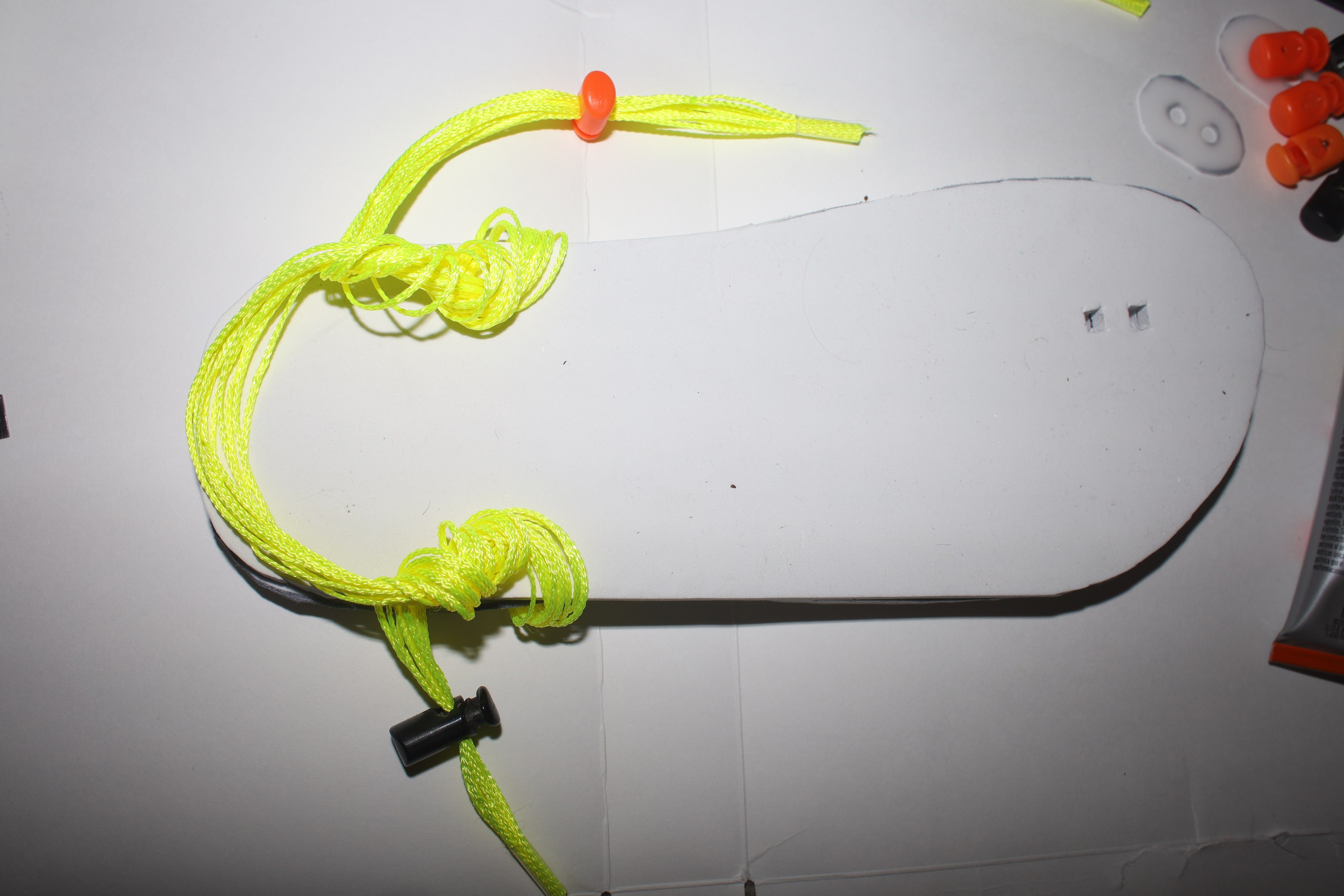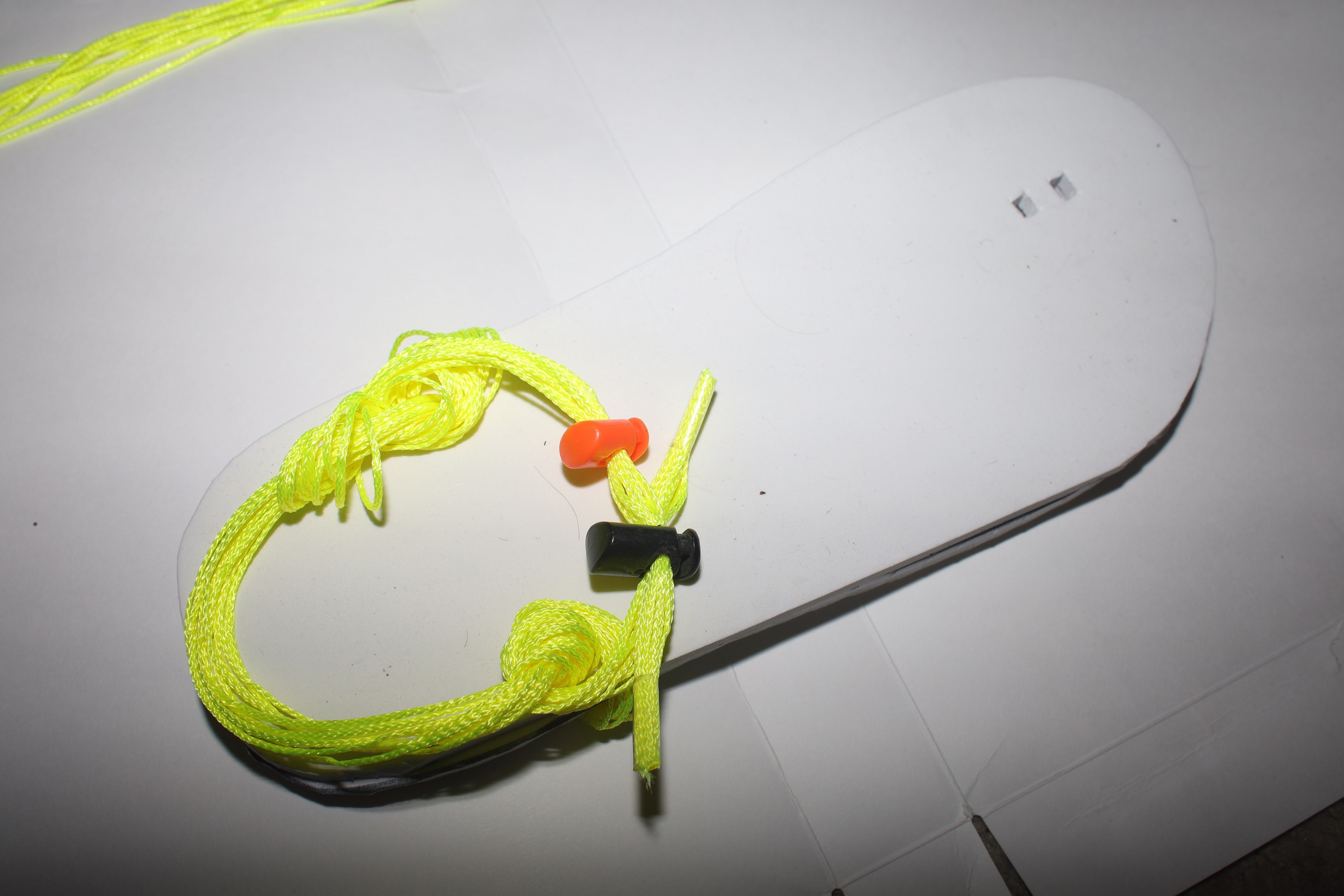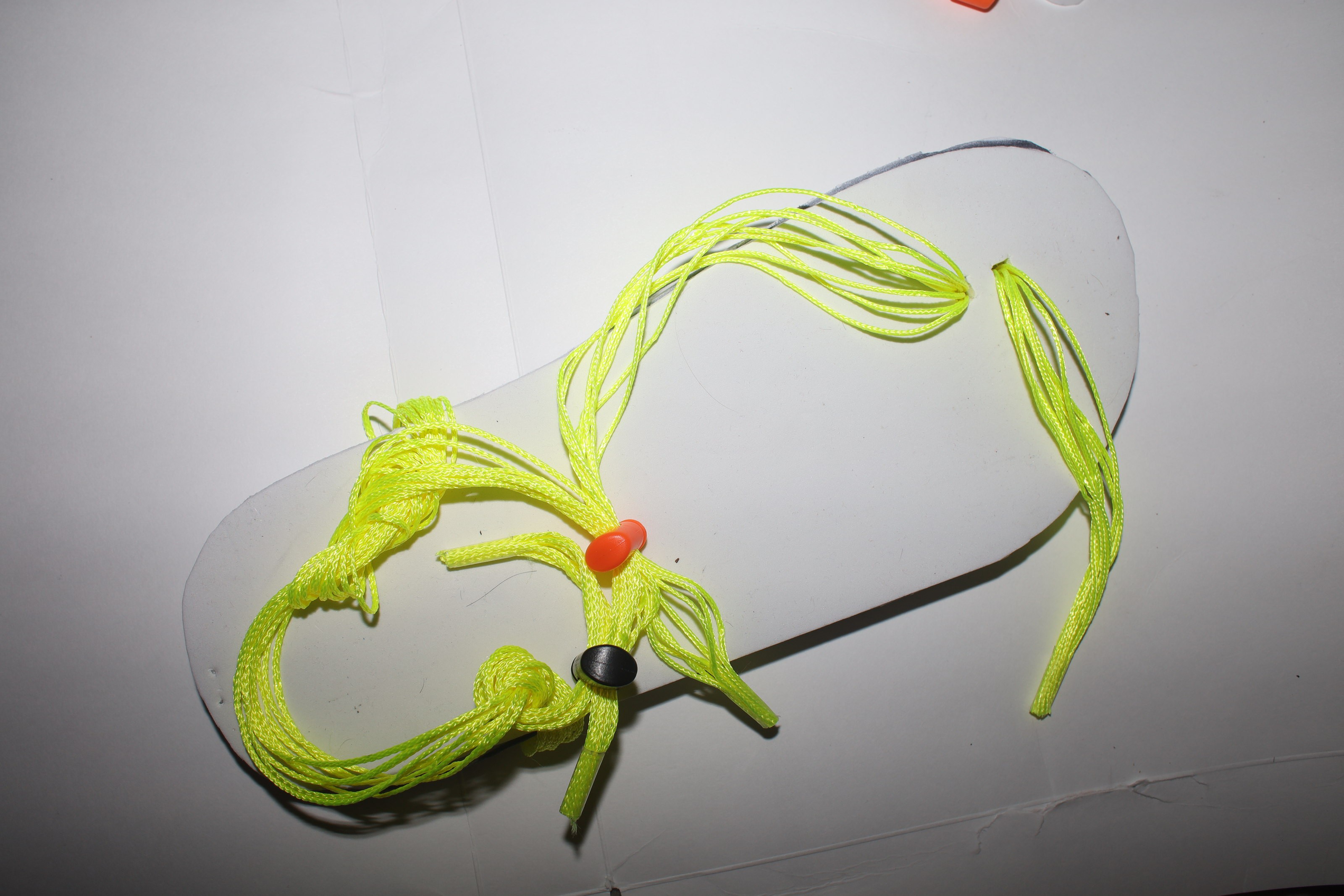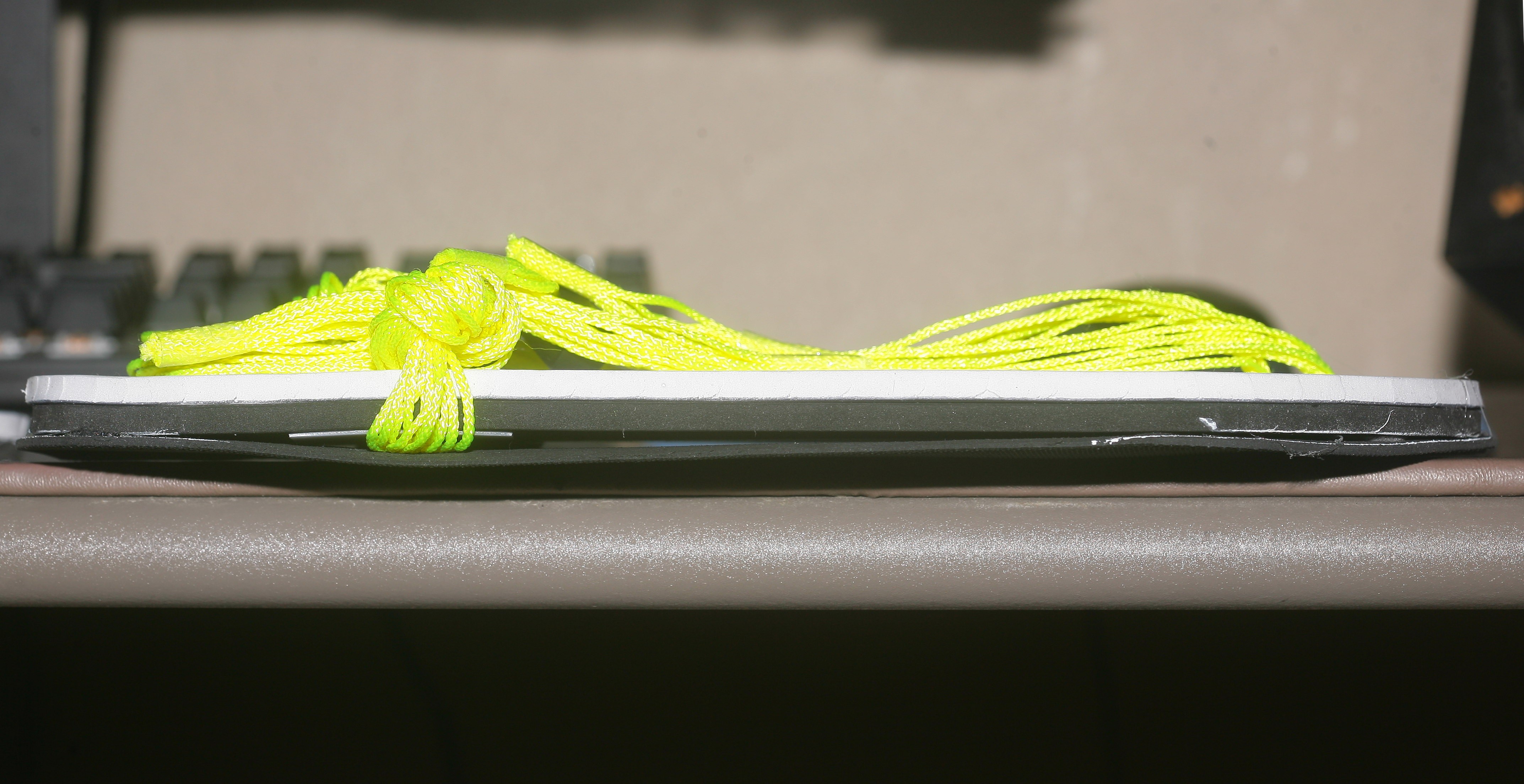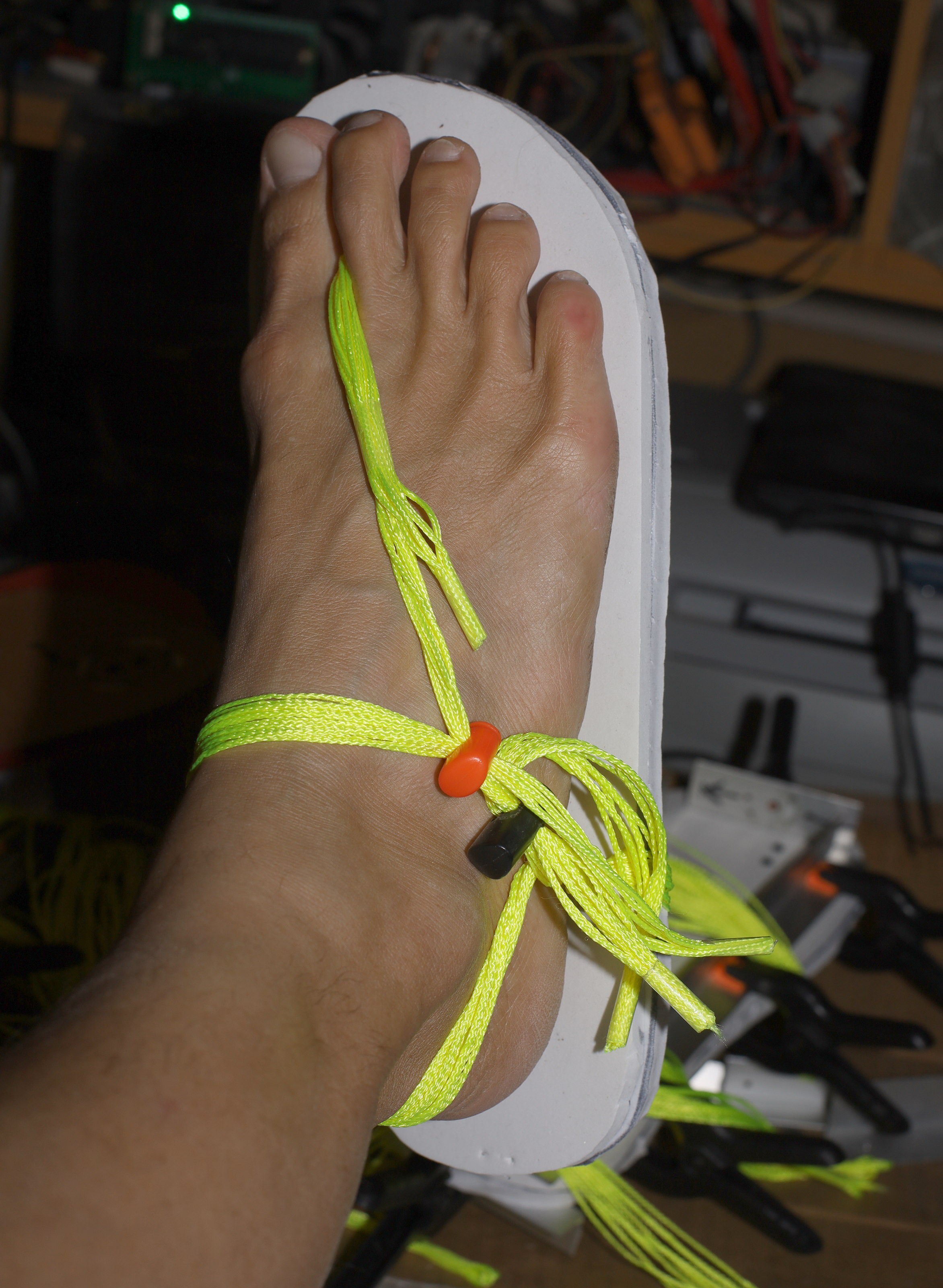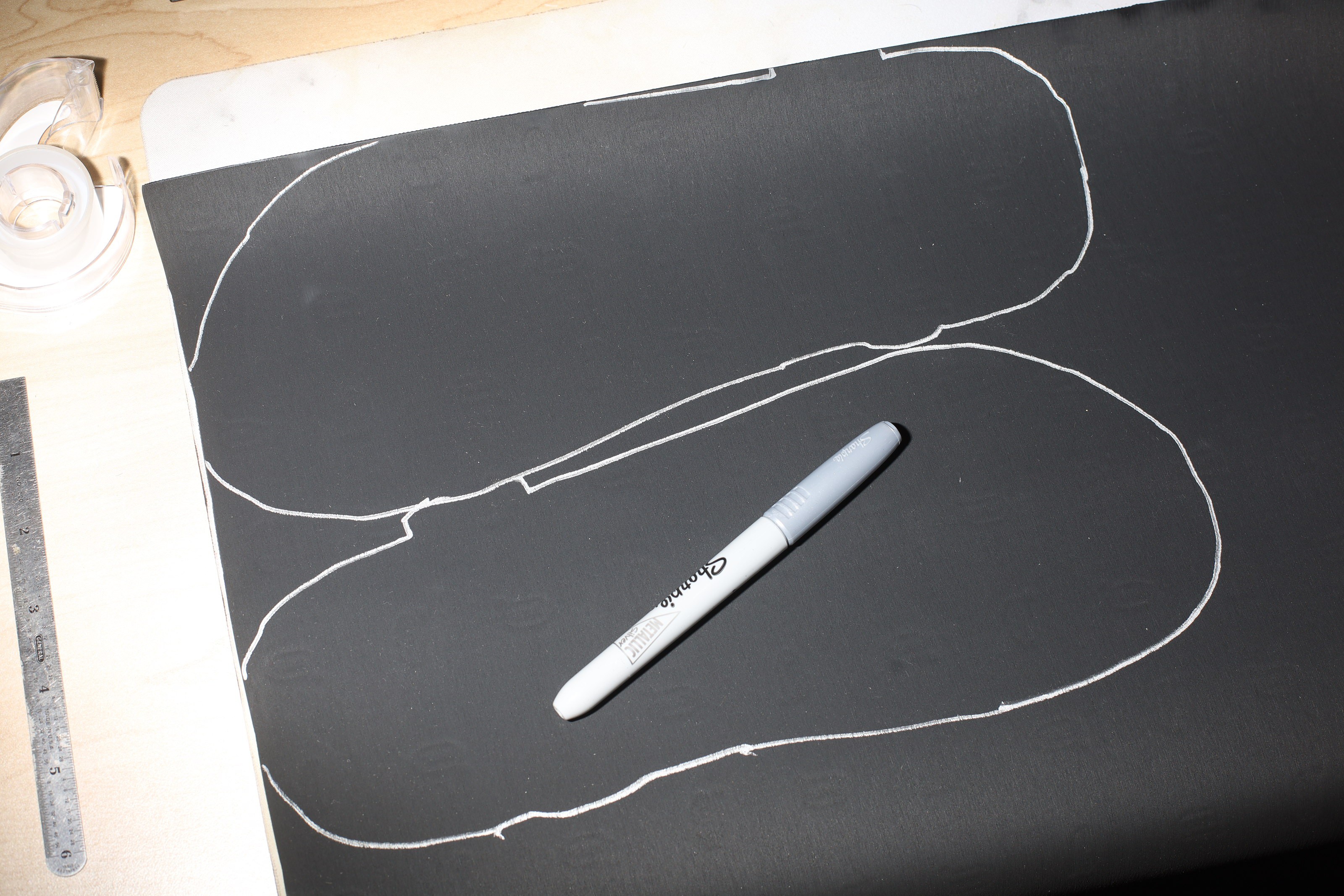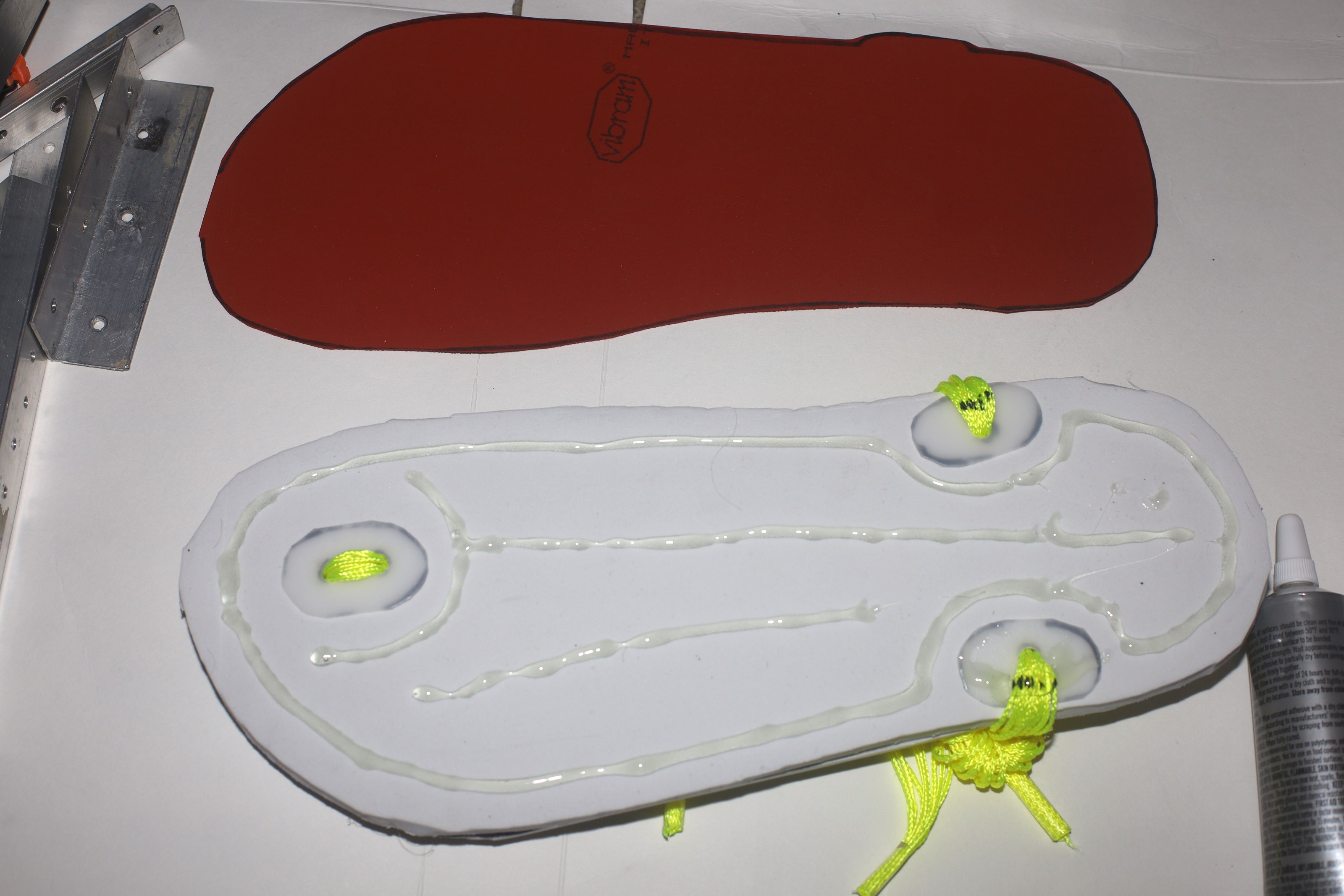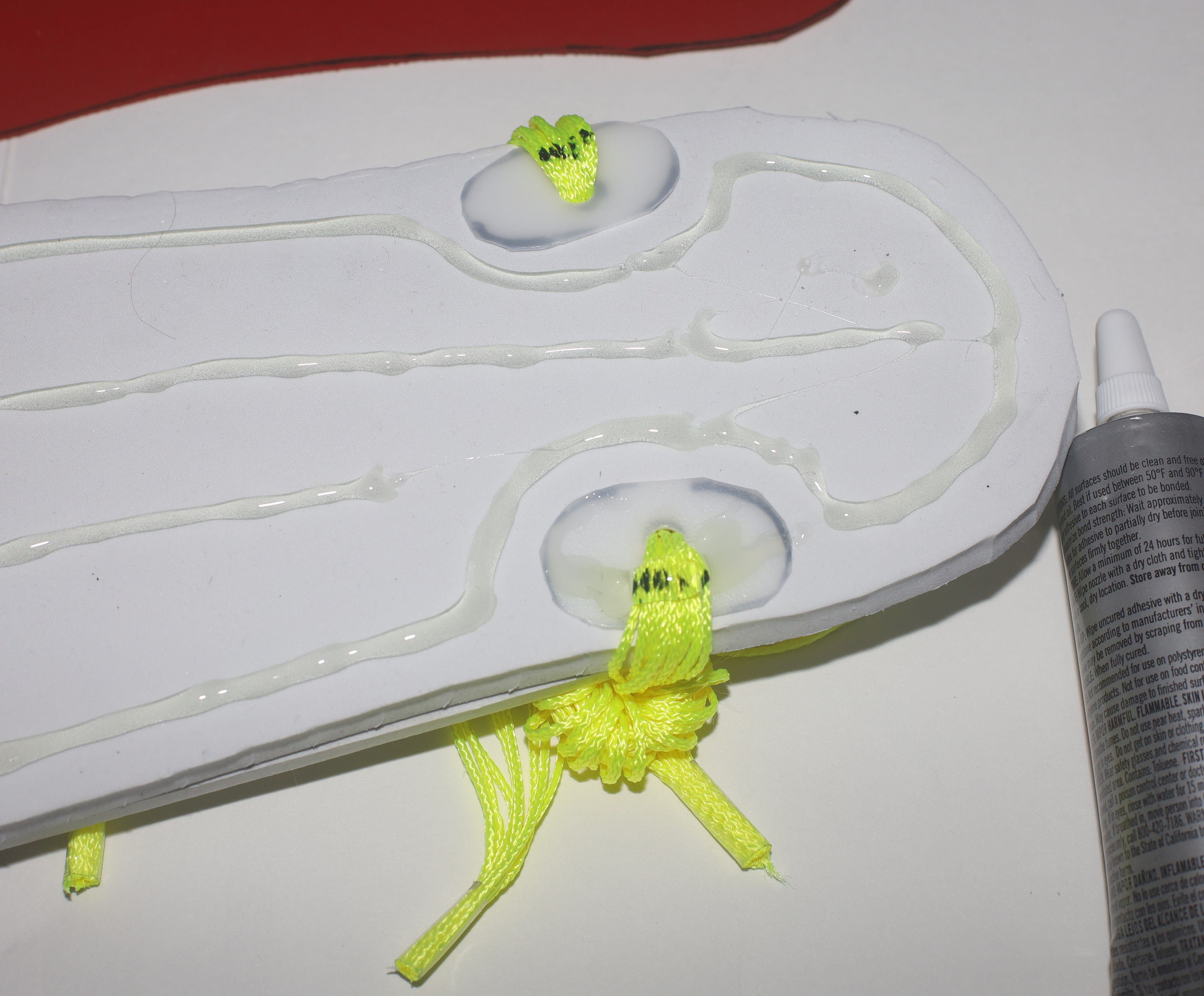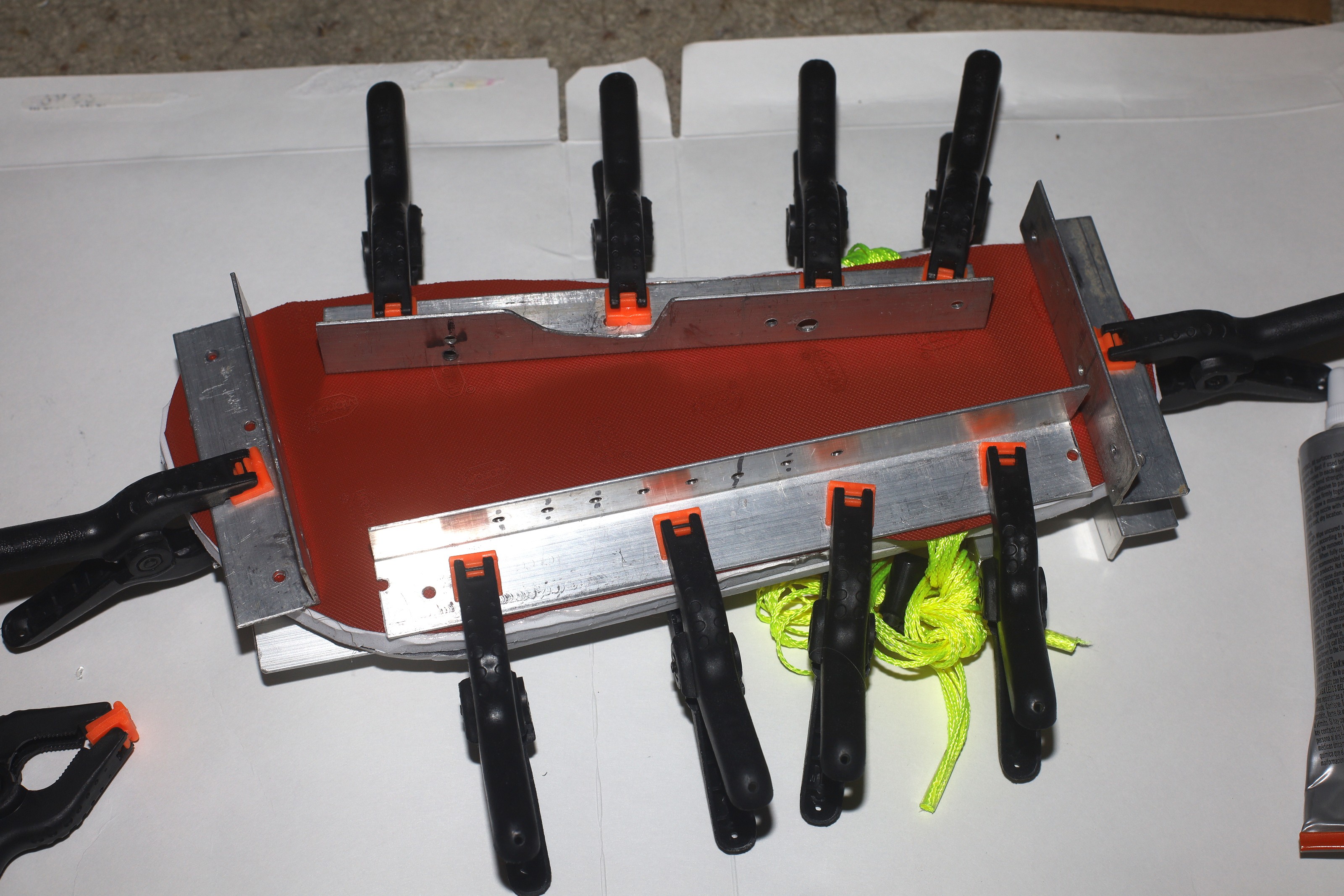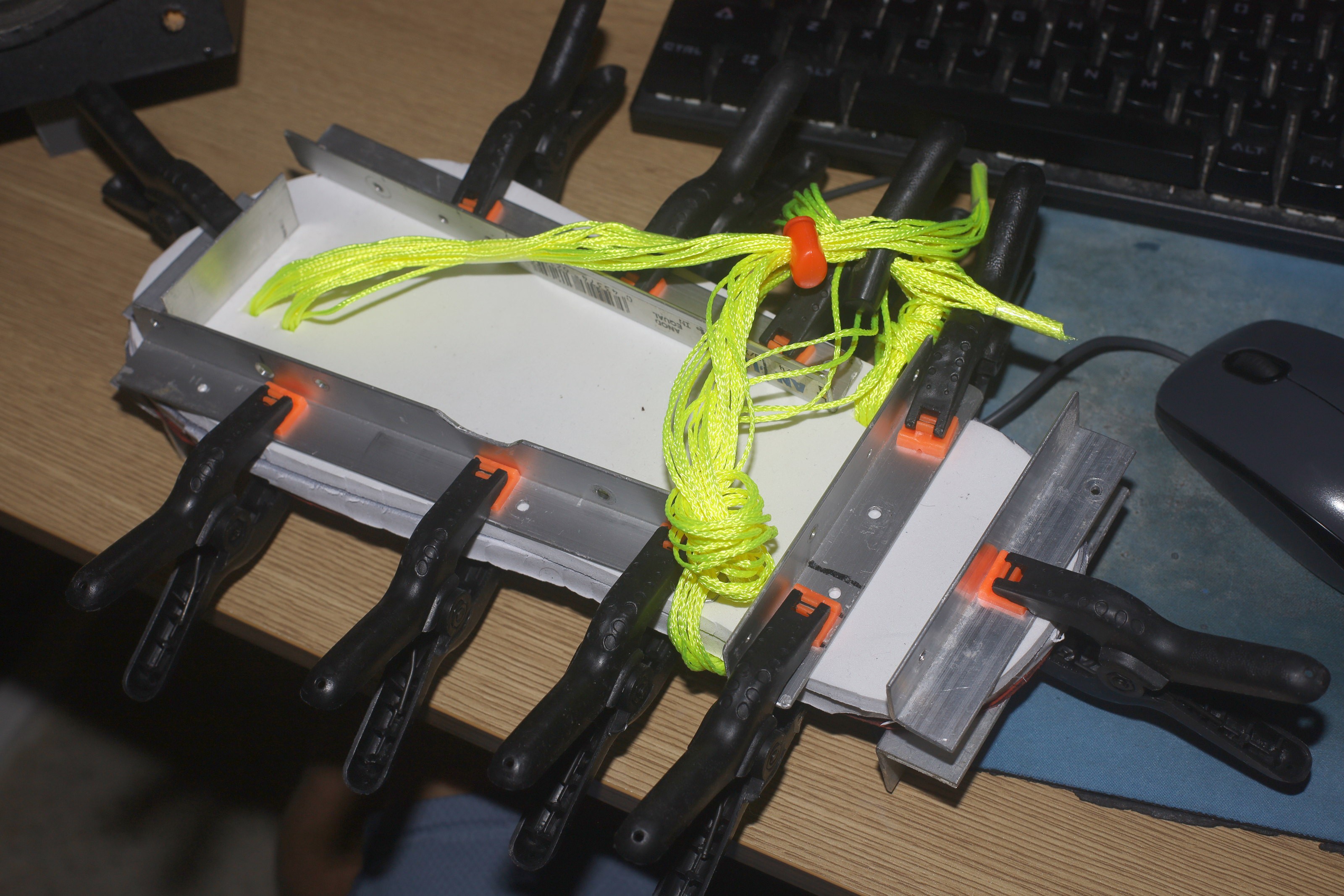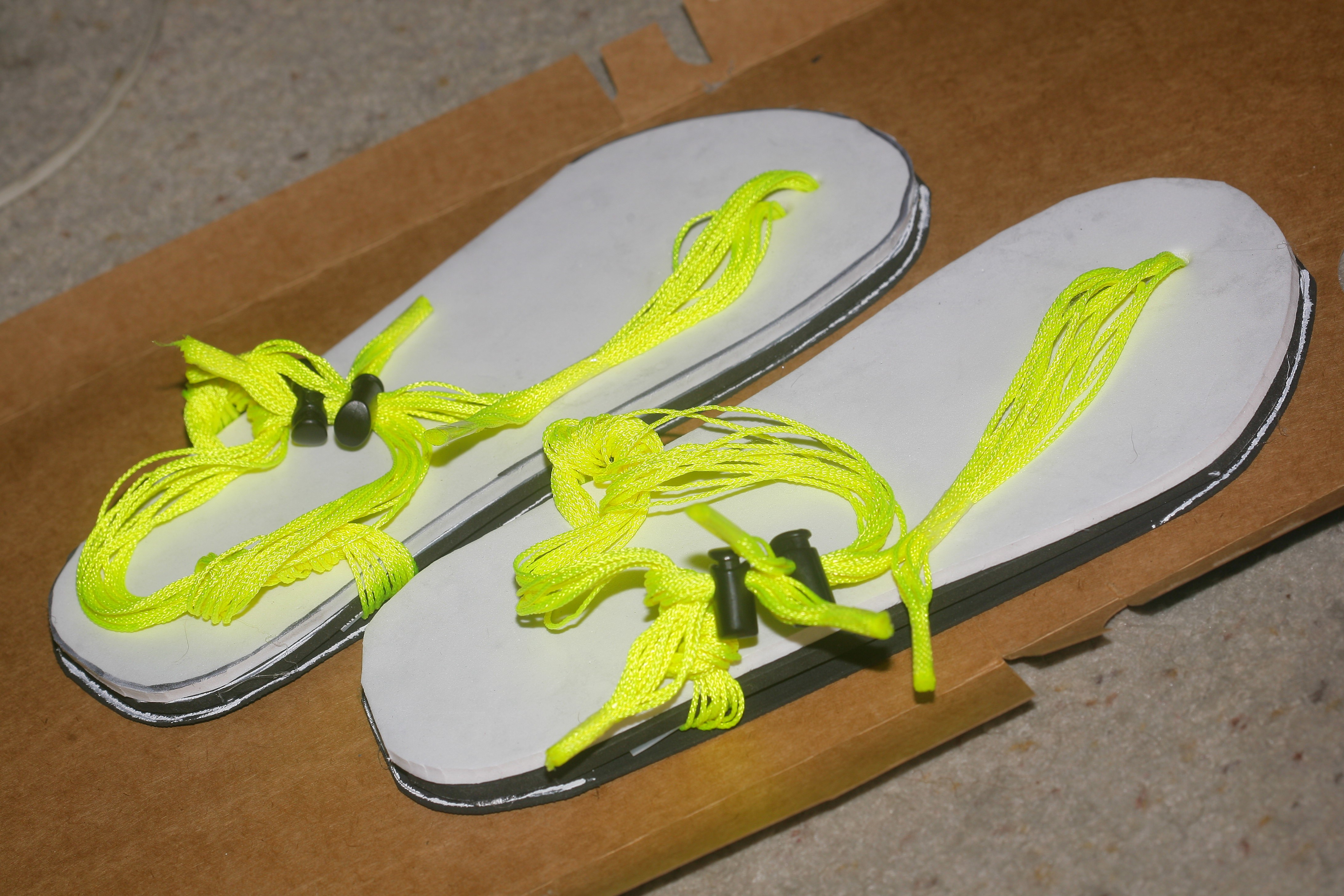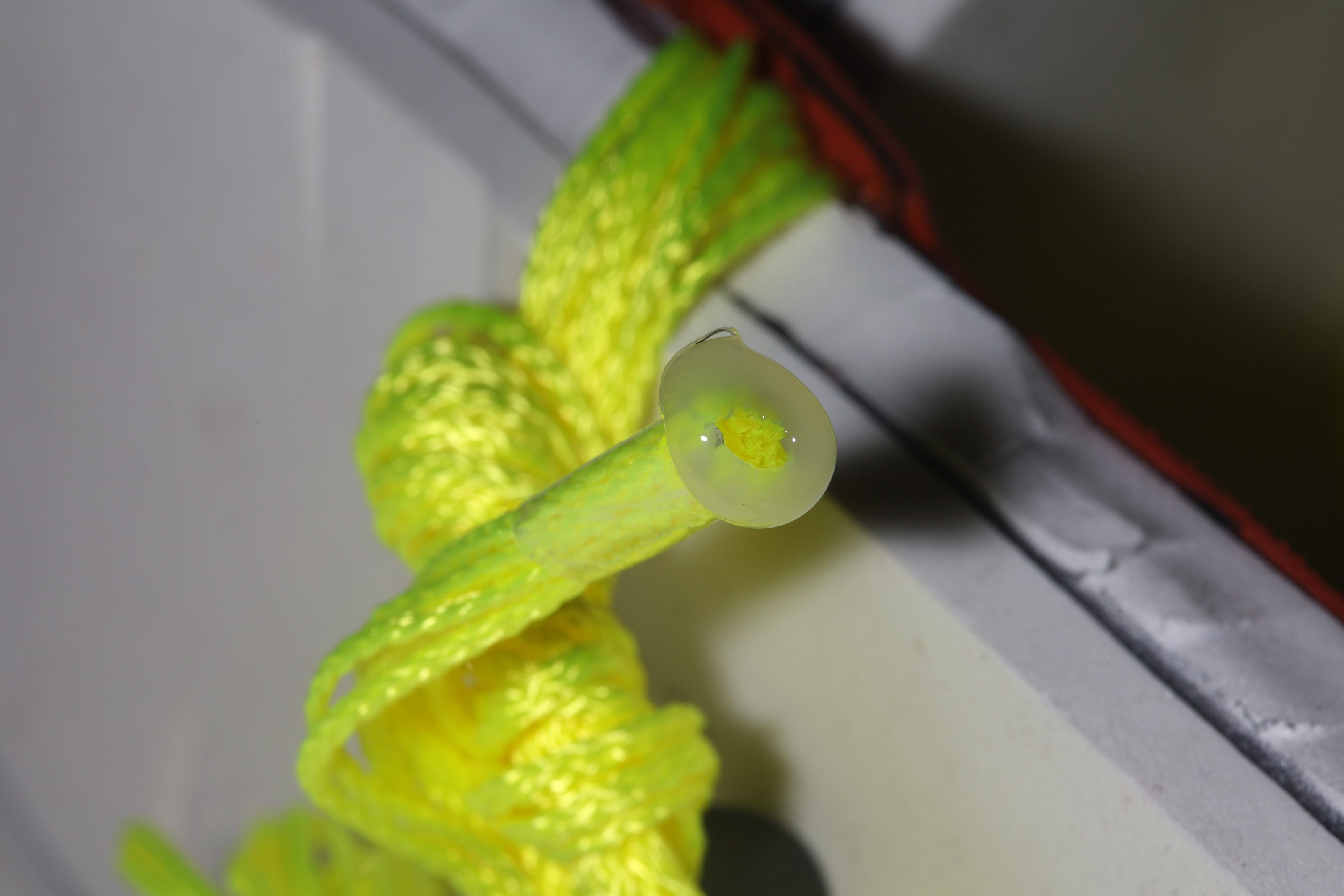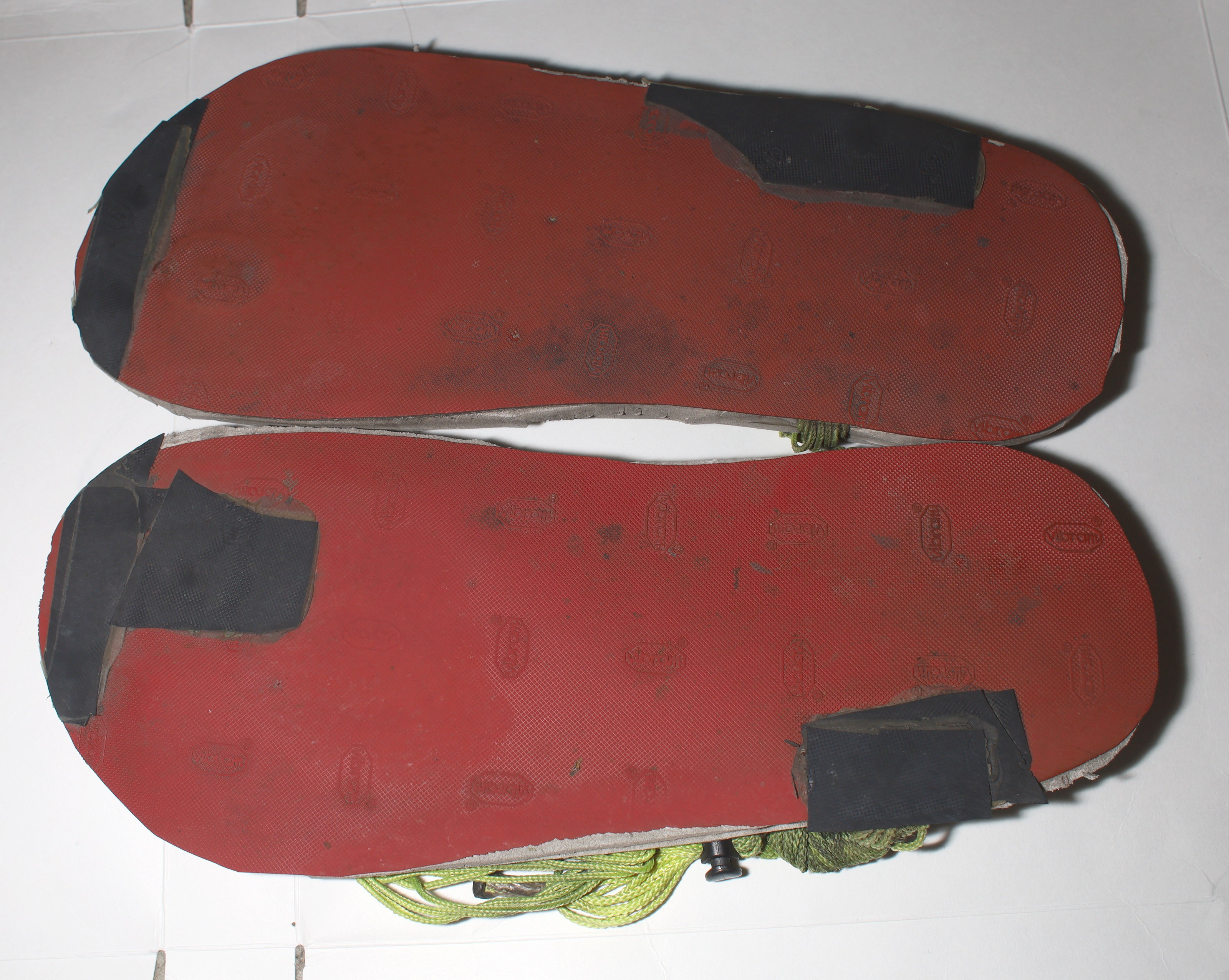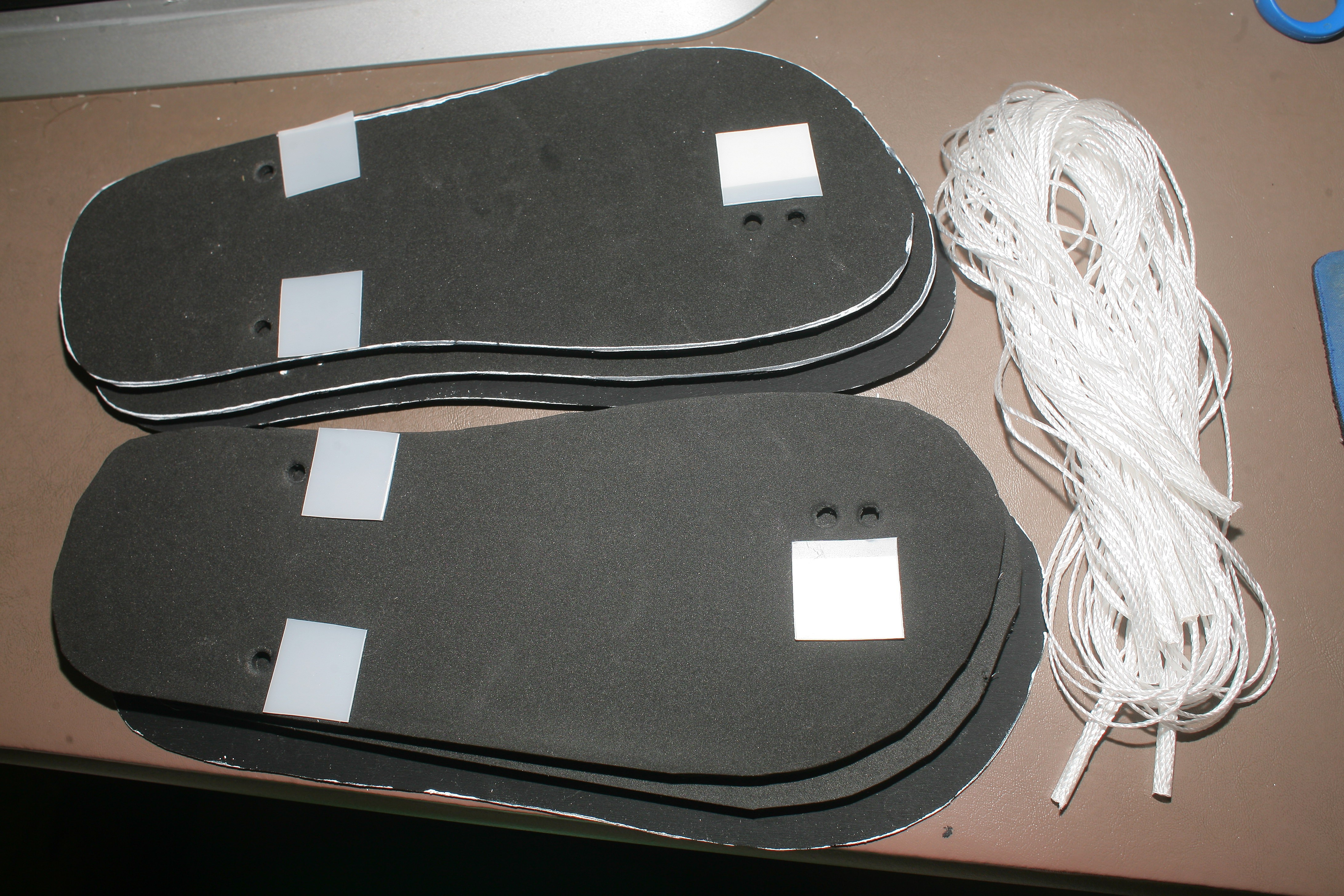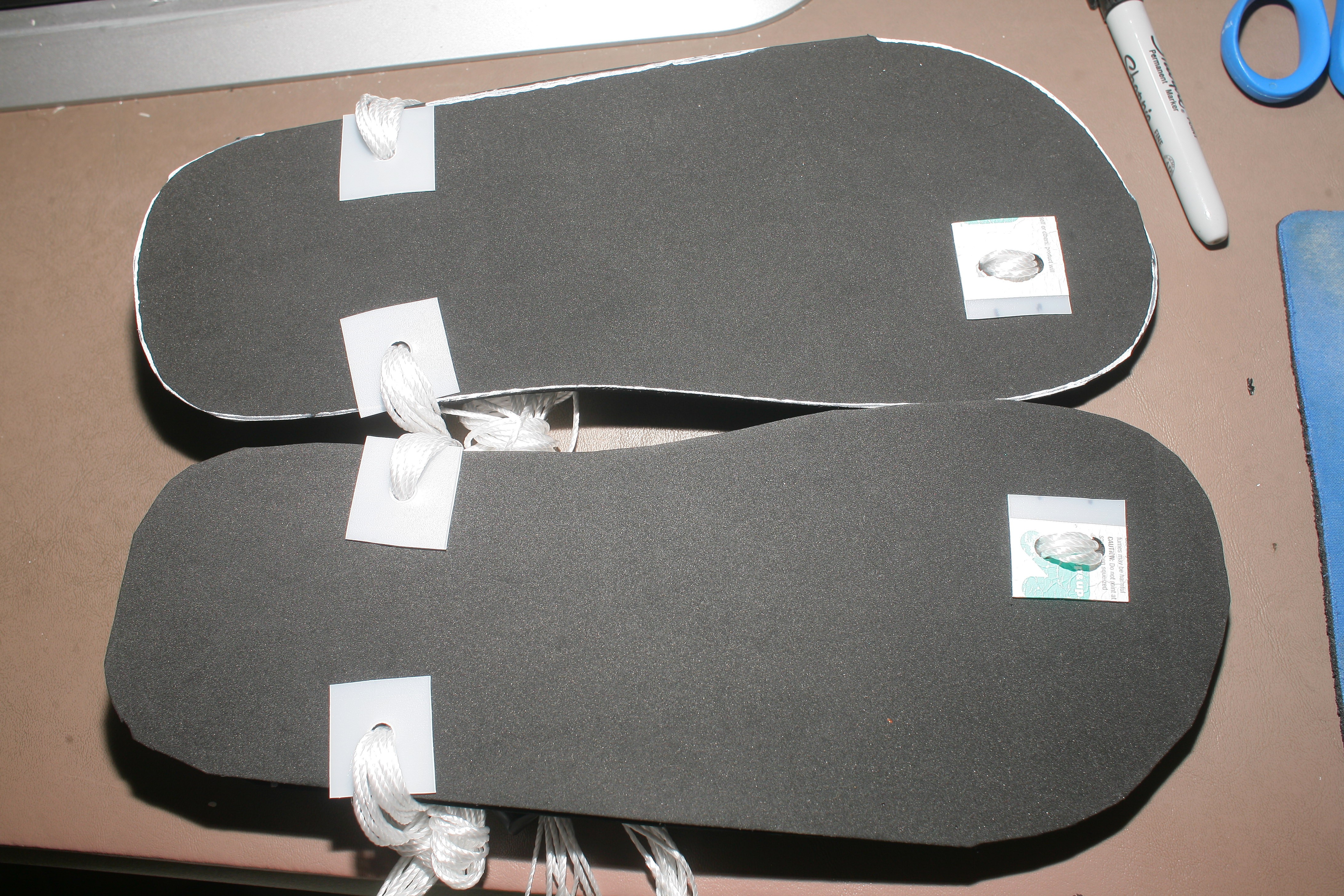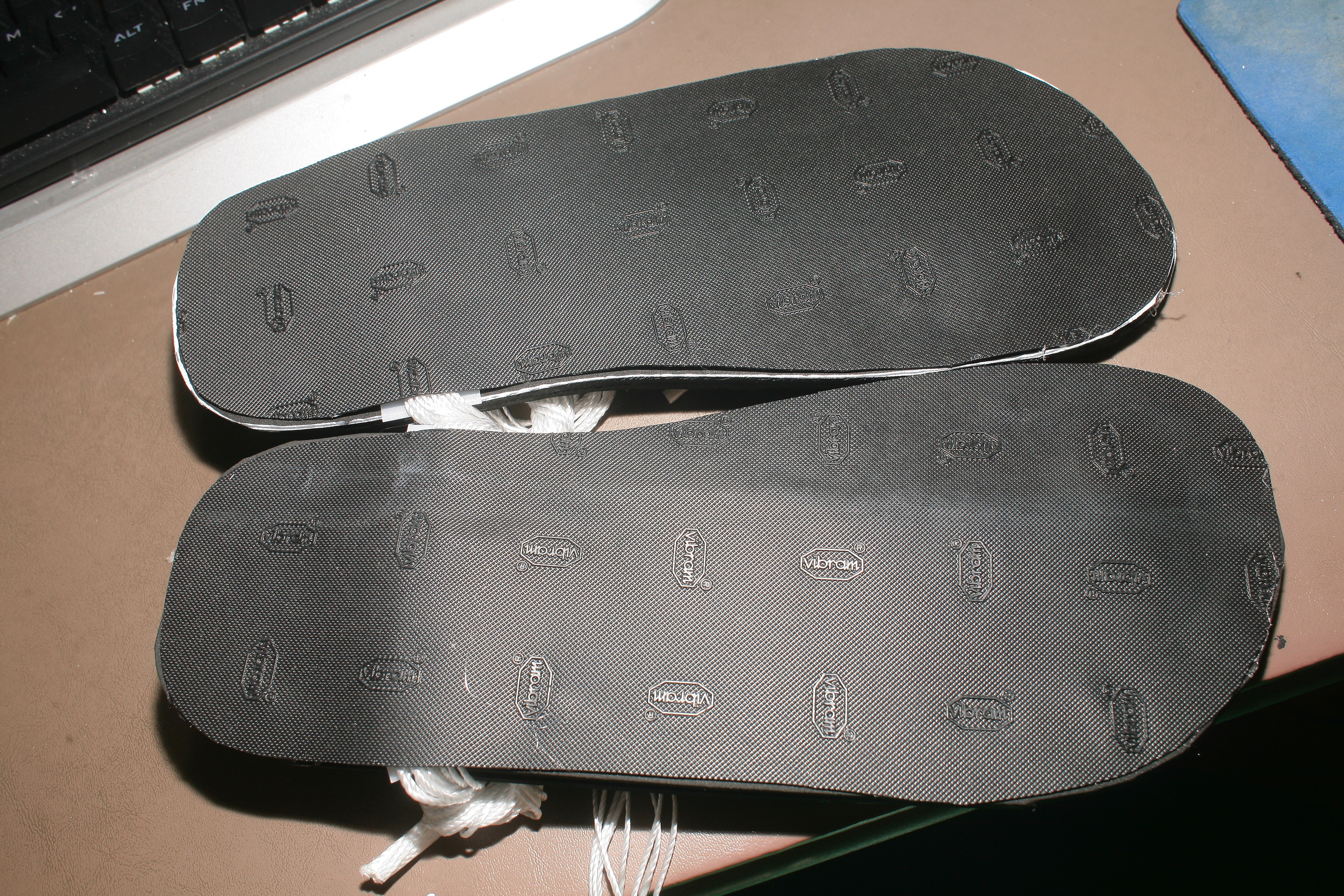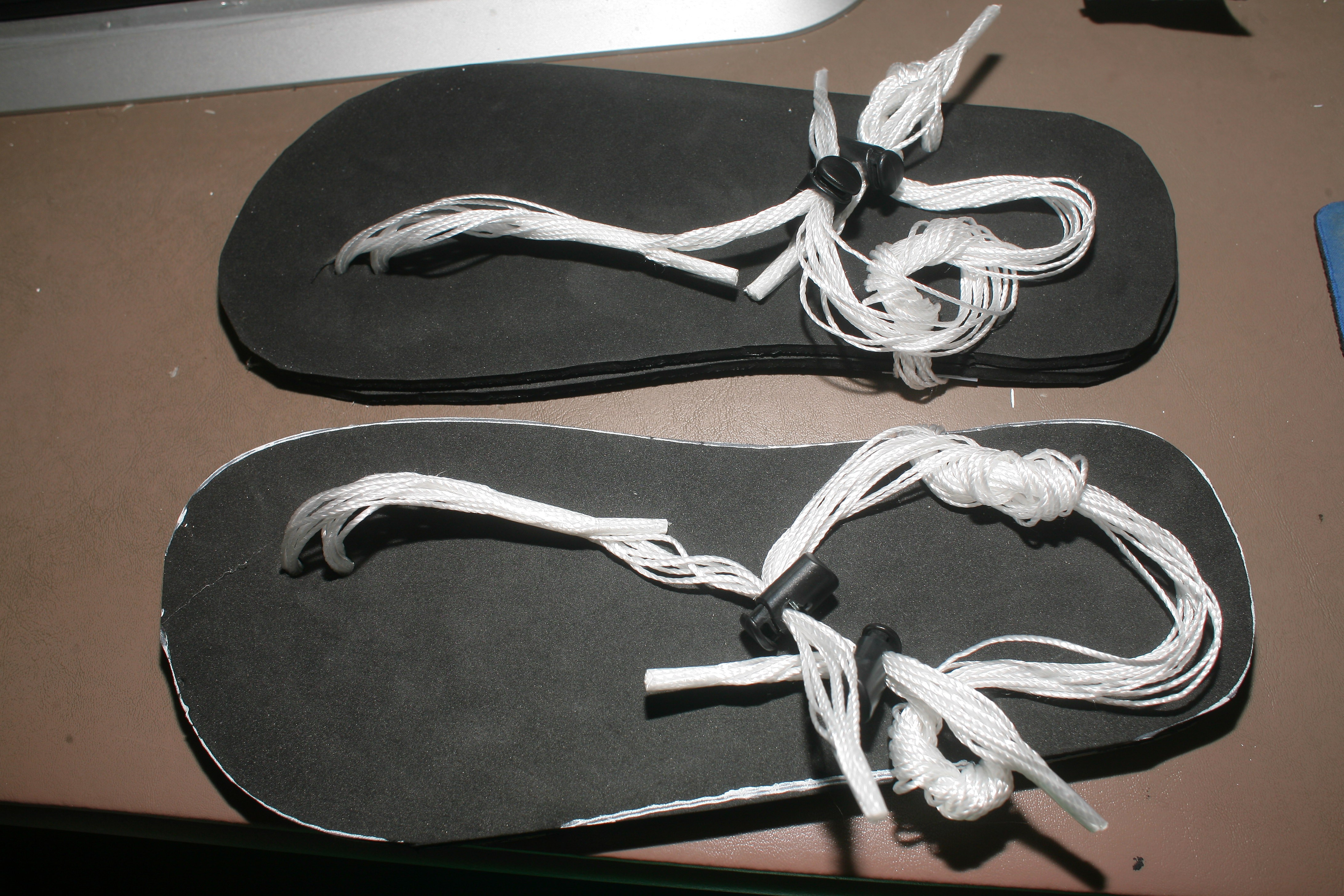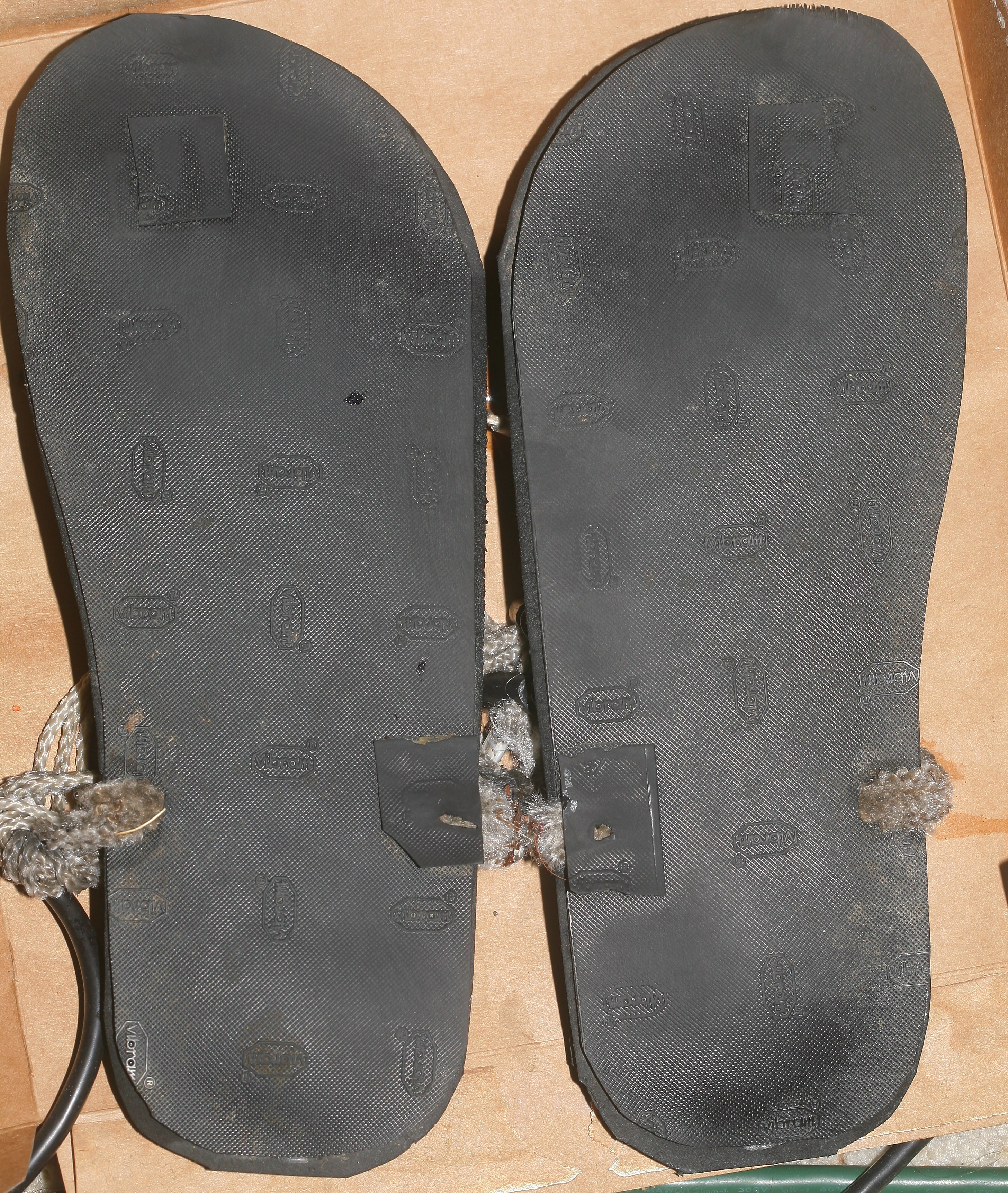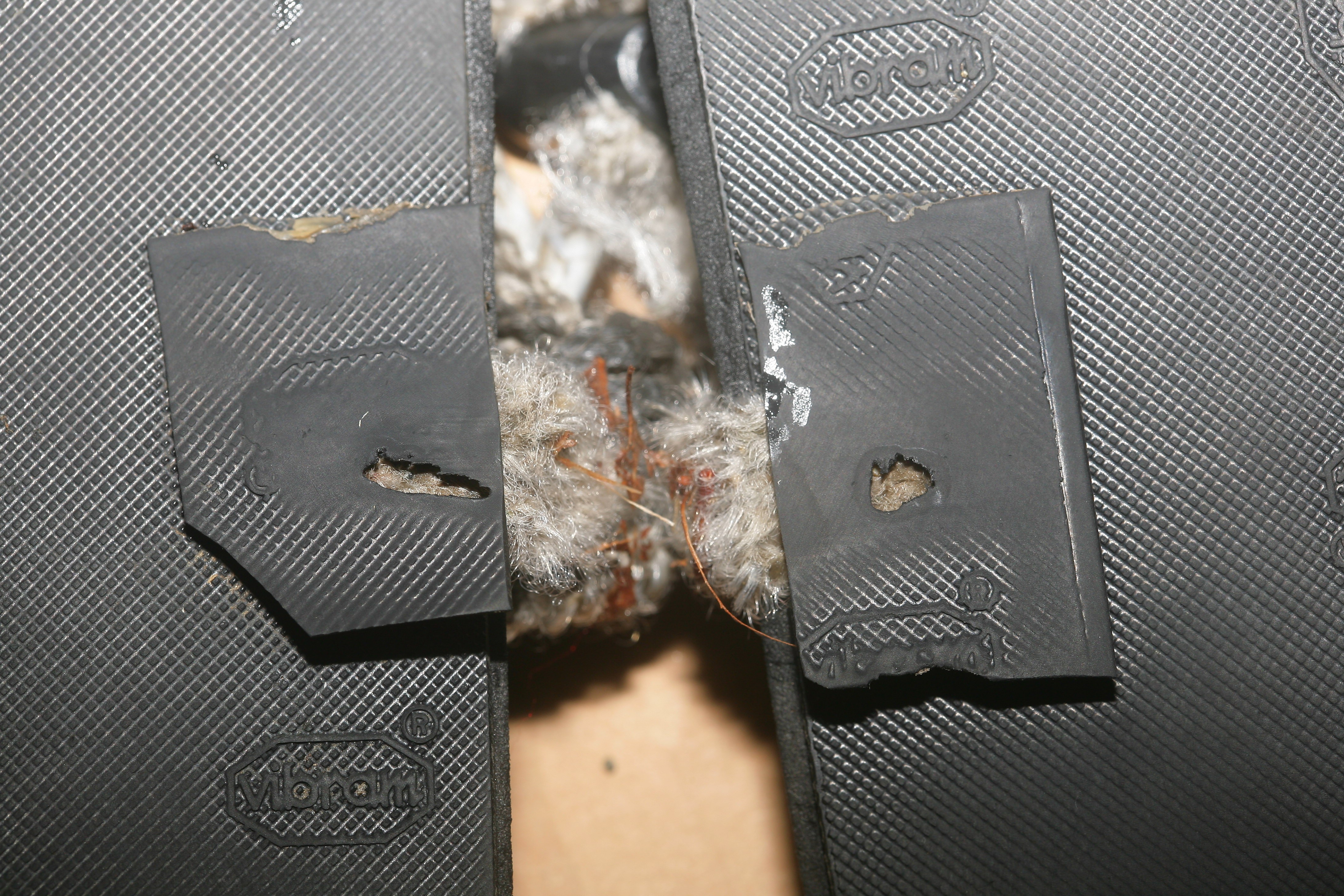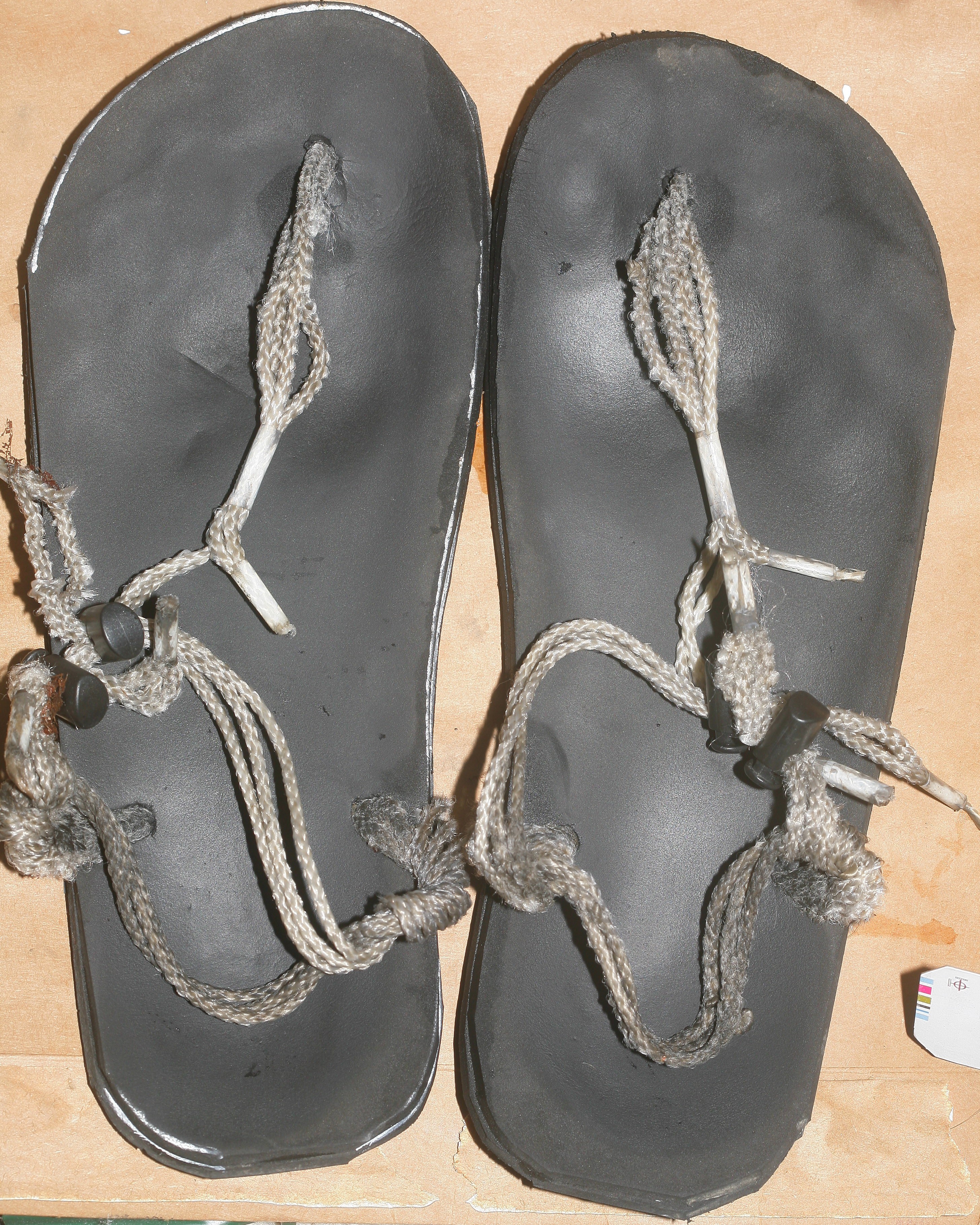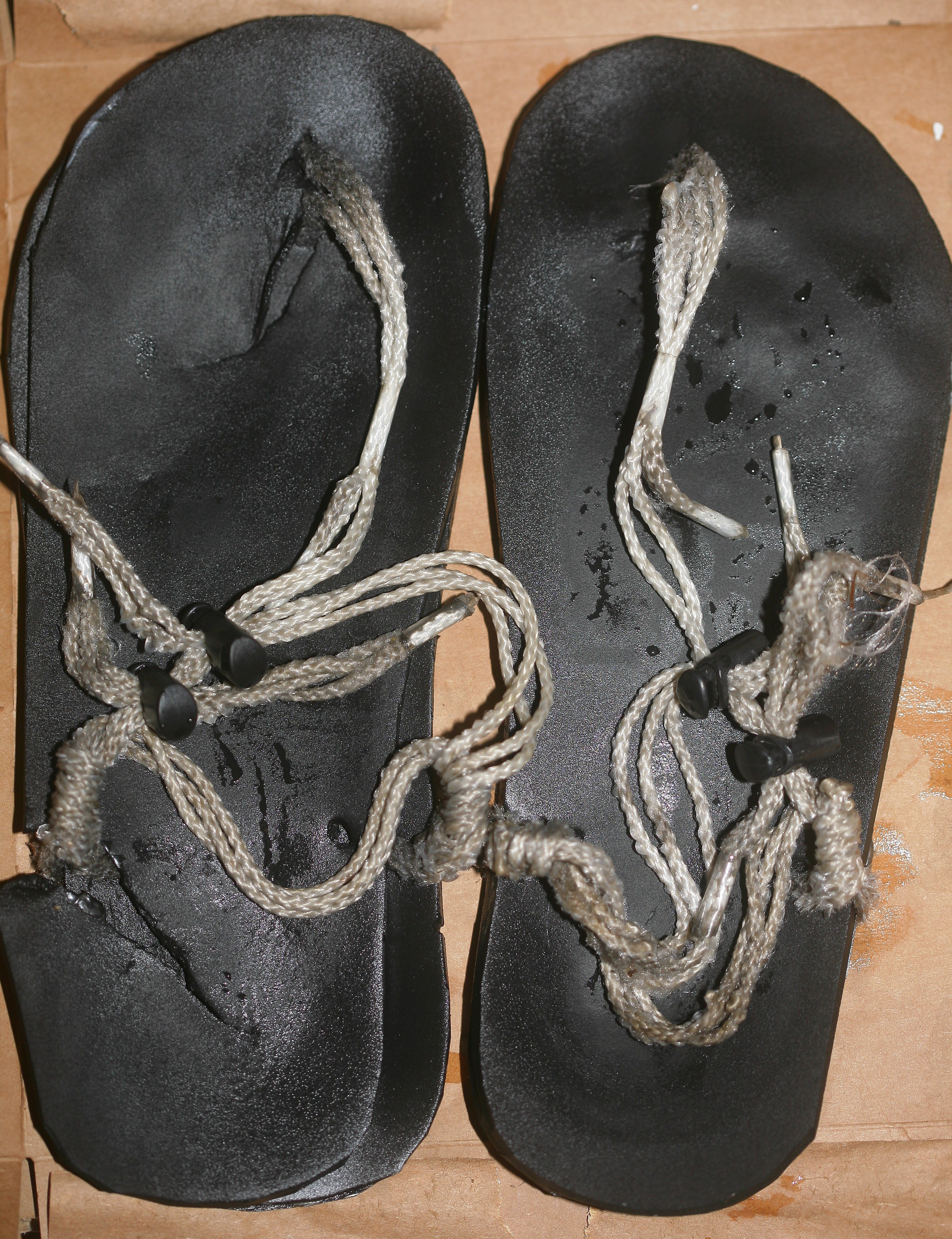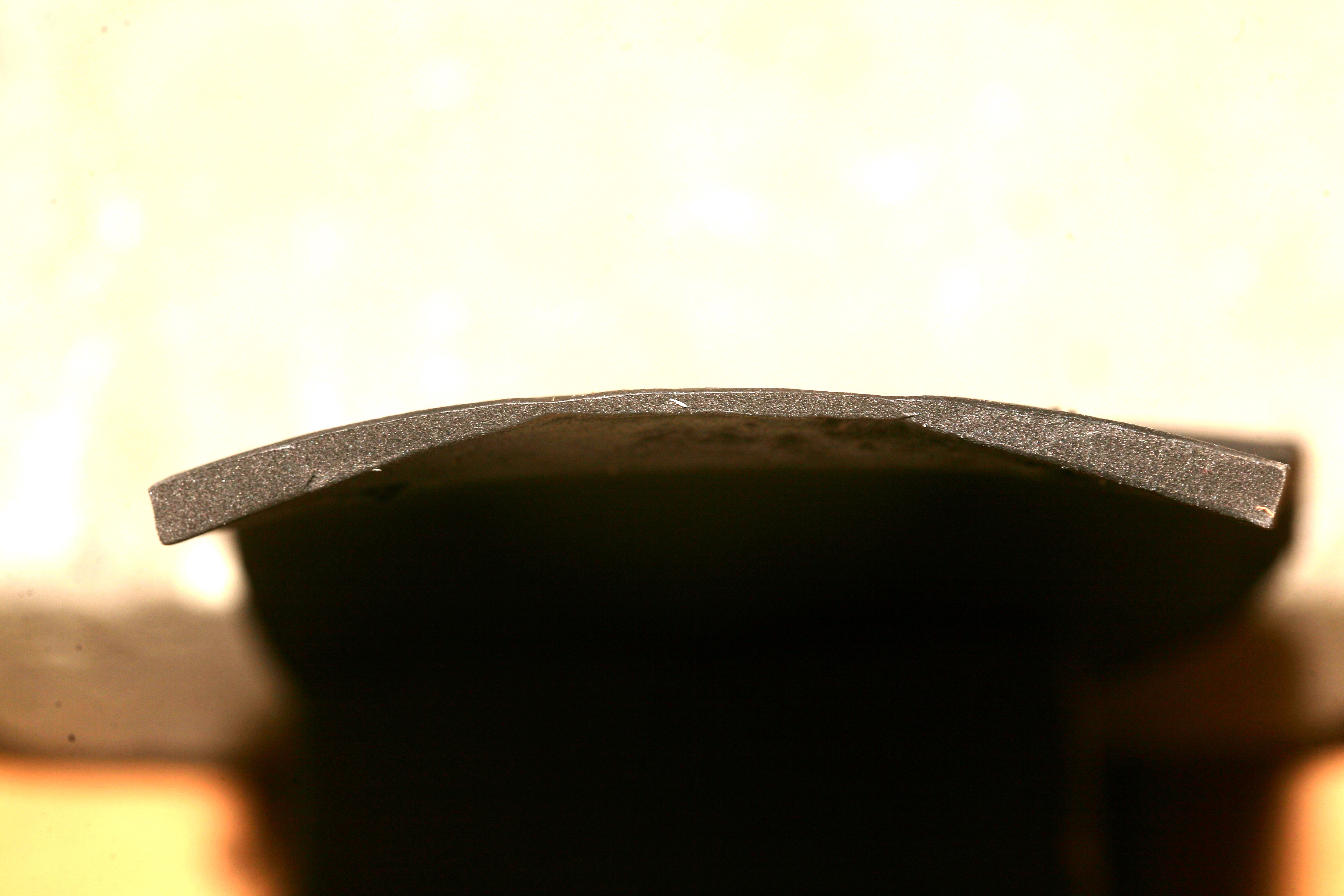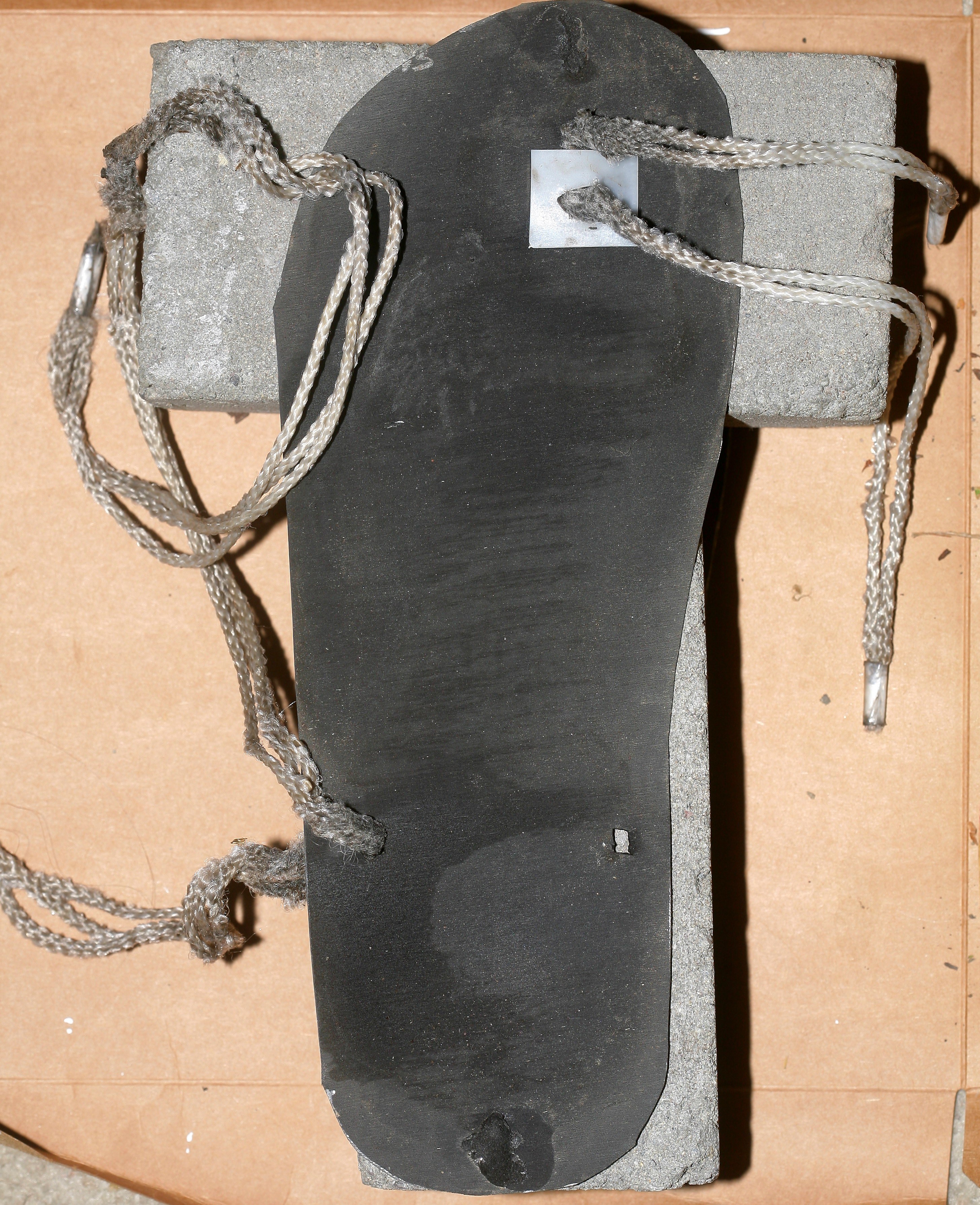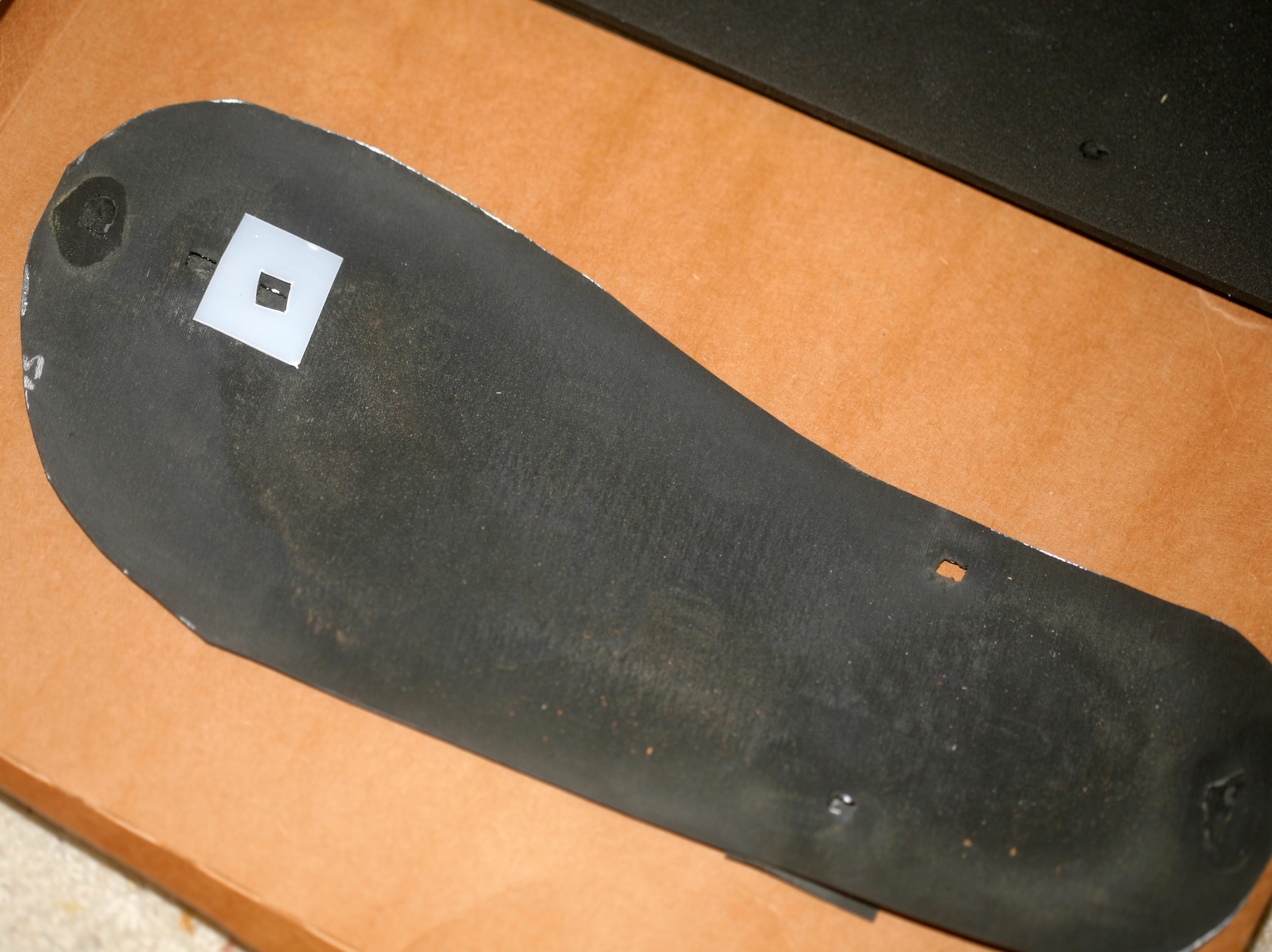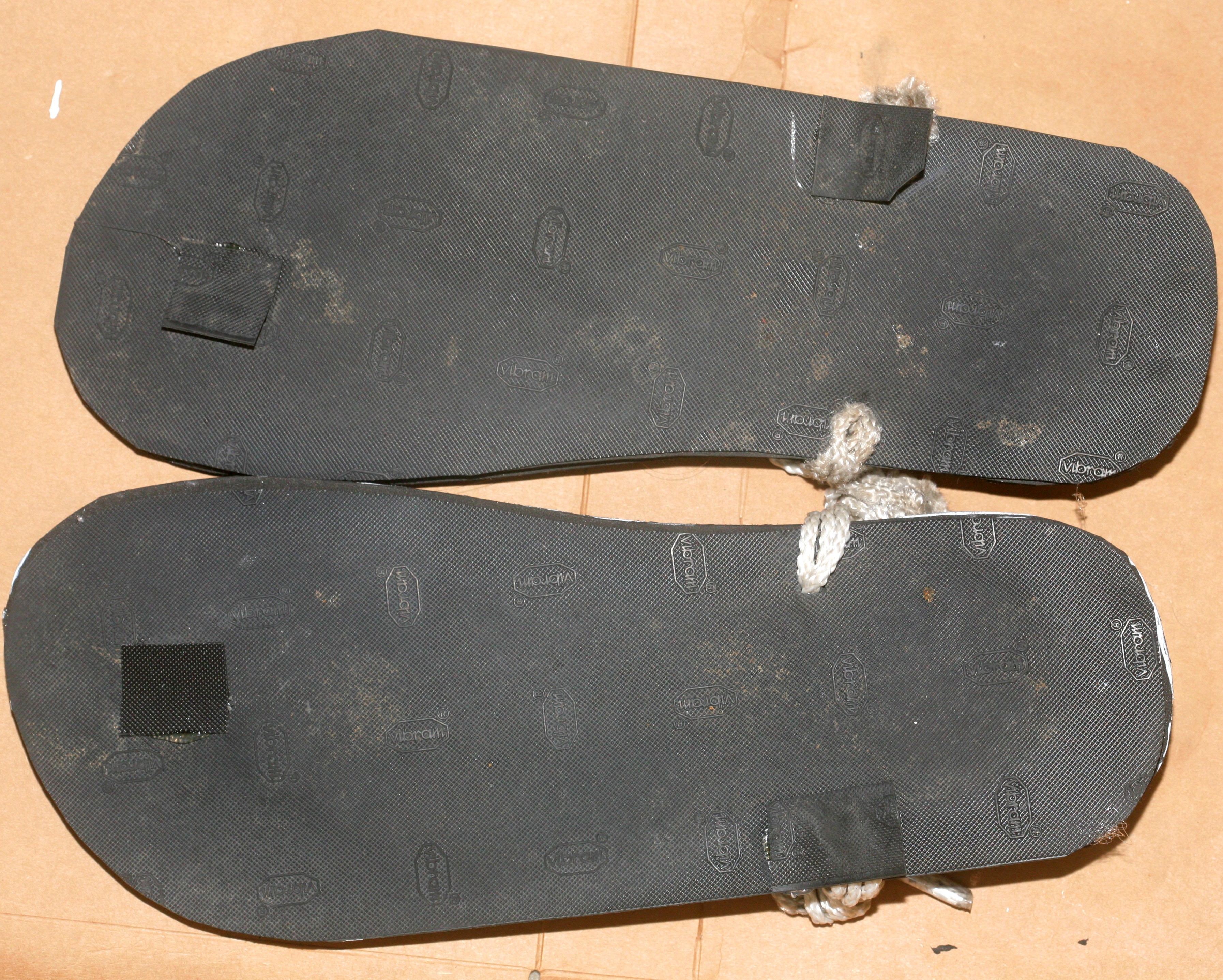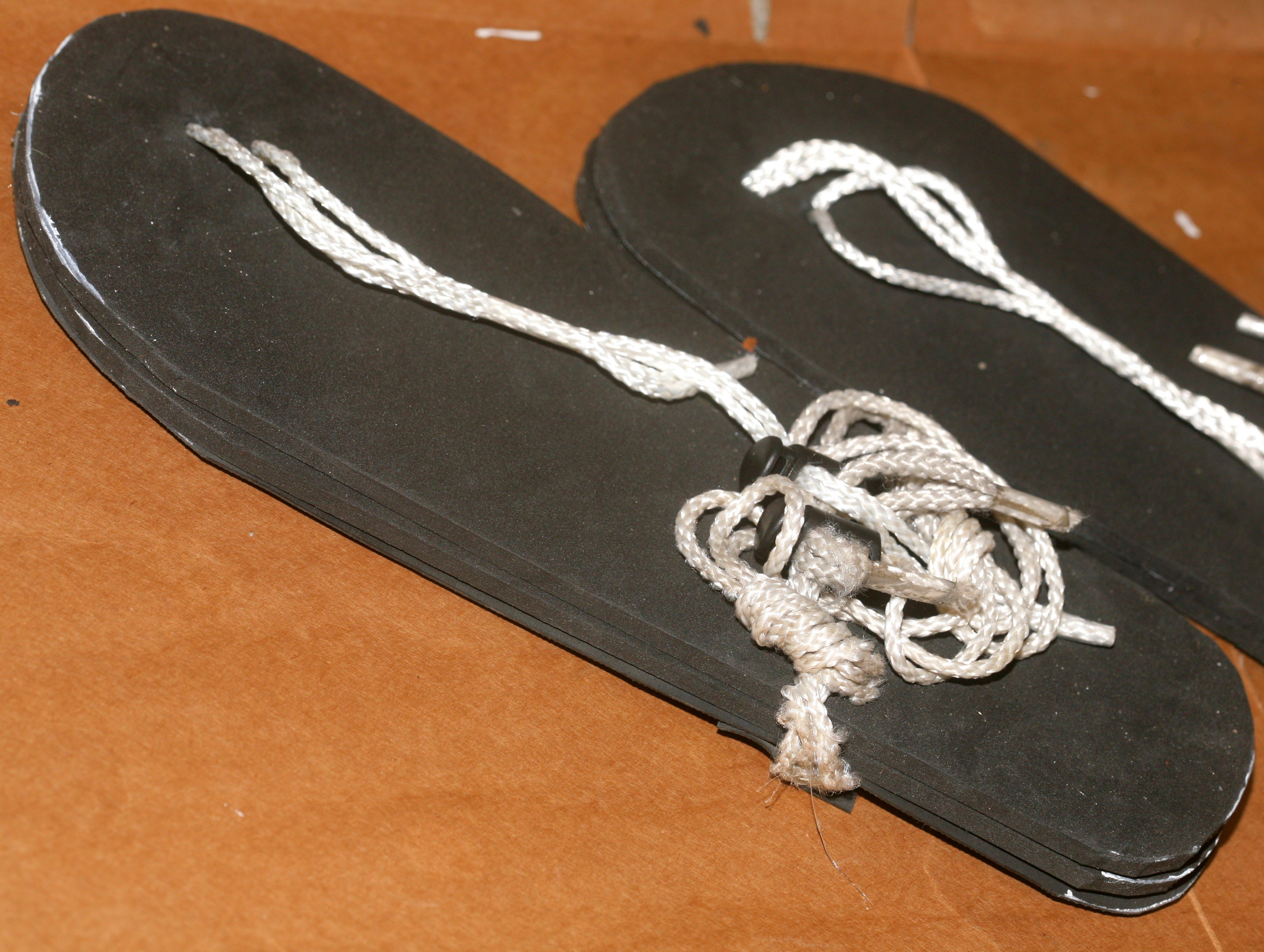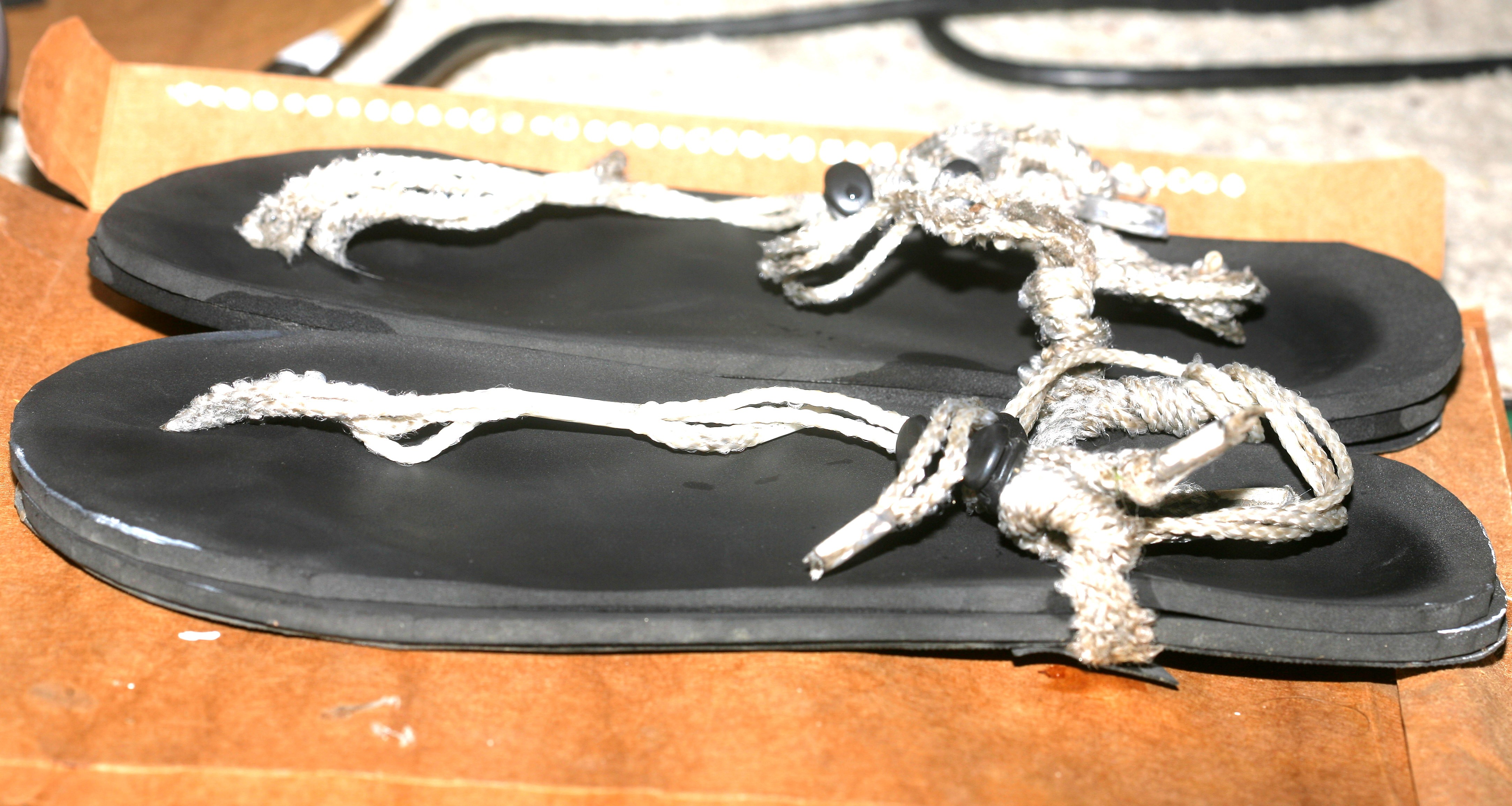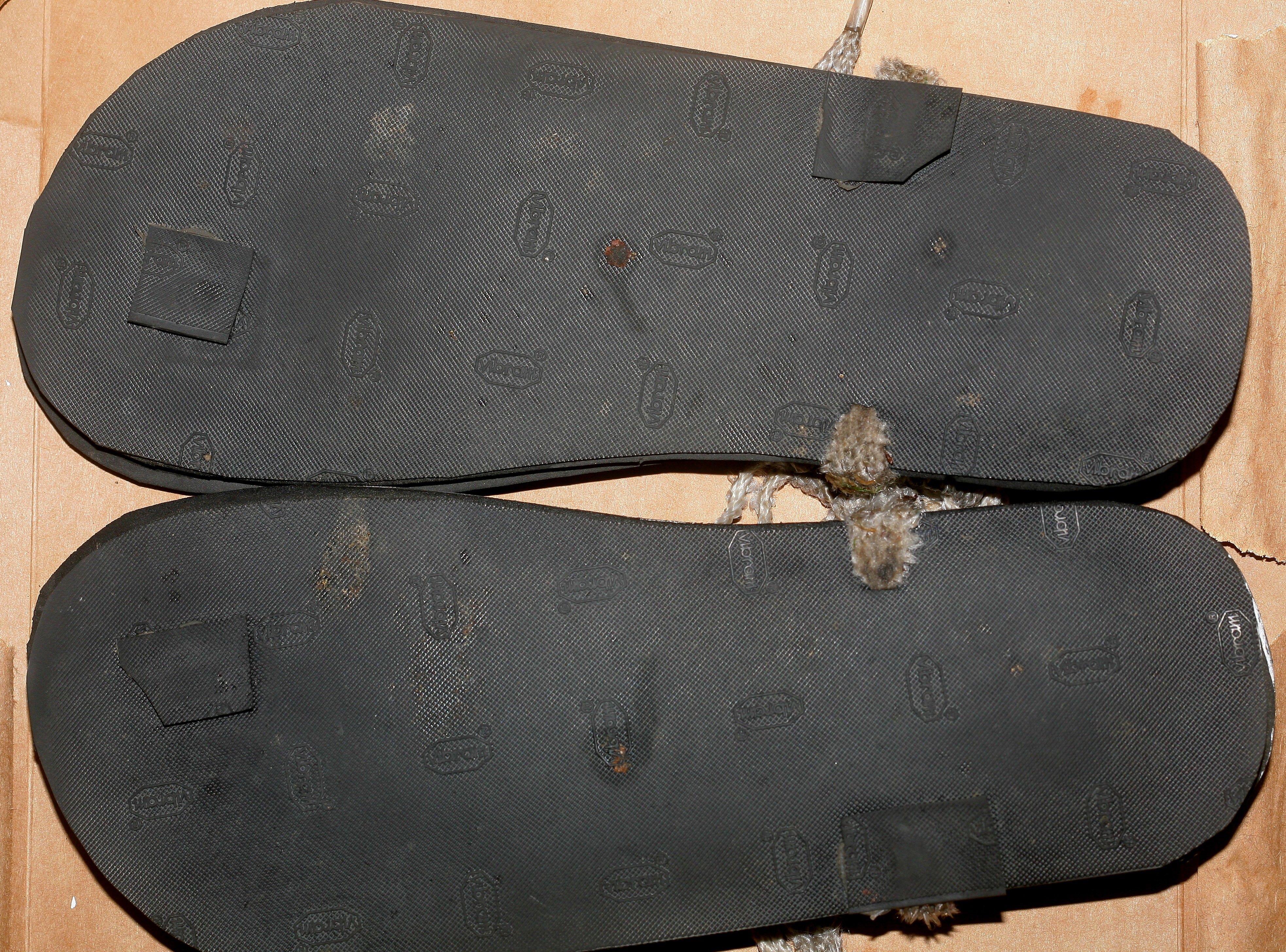-
2 more pairs
05/03/2020 at 06:37 • 0 commentsThe mane addition with these sandals was extra bits of rubber in the highest wear areas.
![]()
![]()
![]()
The lace ends were taped together into loops until they fully stretch. Then, the laces may be cut again & hot glued or left as loops.
The photo record says the last pairs were built in April & Aug 2019. The April pair was only used once per week & went at least 400 miles. The Aug pair was used 5 days per week & went a lot farther. They finally got replaced, today. The mane cause of death is the soles wearing down. While the EVA quickly compresses into cardboard, the compression hasn't been the mane problem. Alternating sandals for every run may undo some of the compression.
-
Cracked rubber
05/02/2020 at 23:04 • 0 commentsThe dream of improving the sandals continues to give way to the need to keep the current fleet alive as it wears out.
It came to pass that a $40 sheet of soling material became cracked from being stored in a folded position. This sheet only yielded 2.5 pairs of intact sandals, but lions have realized soles can be created by gluing smaller pieces.
![]()
![]()
![]()
In the last 2 months, a rise in the need to fabricate face masks from fabric caused a lot of men to start sewing.
![]()
This got the lion kingdom thinking more seriously about sewing straps instead of strings.
Reviewing the Luna sandals offerings, their top line sandals are now $120 instead of $200. That's cheaper than what lions paid for Hokas. Their bottom of the line is $80 & sold through resellers. They're all using a single toe plug instead of a toe strap. The toe plug & heal all use nylon straps. The nylon narrows down before inserting between the toes.
As it was when lions dropped $40 on a zeroshoes pair to get started, the trail sandal begins with dropping a certain amount on a Luna pair.
-
Trail dreams
09/21/2019 at 09:36 • 0 commentsThe current design has worked well on roads, as long as there are very few rocks. It's pretty bad on trails. Making minimal sandals bearable on trails has long been an impossible dream because they would have to be heavier & this would make the toe plugs more painful & cause more chafing from the string.
As long as the weather wasn't humid & the strings weren't too tight, lions have gone 25 miles without any chafing from the latest toe plugs & strings, without any tape, but they do result in scabbing where the toe plug enters the foam. A trail sandal needs to have straps instead of strings to distribute the increased weight & handle sideways forces. The lion kingdom believes suede straps might do the job, but these require a quick fastener for straps instead of cords. Velcro has proven very short lived in sweaty environments.https://www.amazon.com/10-Inch-Lever-Plastic-Buckles/dp/B00GS9L5U6/
Levered buckles are intriguing but bulky. It may be the good old fashioned
https://www.amazon.com/Plastic-Tension-Triglide-Backpack-Suitcase/dp/B07797M878/
backpack tension lock is the best solution. Unlike a backpack, they wouldn't require taking the sandals off or odd contortions to adjust.
For rock resistance, a combination of thicker soles & a hard inner plastic sheet might work.
As much as stock materials have become unavailable anywhere outside China, there's still a place selling 4mm & 6mm vibram sheets to crazy guys who build shoes outside China.
https://www.leathercaresupply.com/collections/soling-sheets/products/vibram-7175-cherry-soling-sheet-shoe-boot-sole-repair-4mm-6mm-35-x-11-black?variant=49408936213
The trick is adhering the inner plastic to the system. The adhesive is permanent & thicker soles are expensive, so it would be a lot more expensive than designing the road sandals.Digging up the 4mm soles from 1 year ago revived the memory of those early days. Many months were spent building the early sandals.
![]()
The polypropylene bonded slightly to foam but not at all to rubber.
1mm acrylic was cheap but immediately shattered when cut. It would never do.
The ideal plastic would be laminated in rubber like most modern gadgets. That's done by having holes in the plastic for the rubber to pour into.
Rather than find a material porous enough to adhere, the leading theory is having a foam layer, polypropylene, foam, & sole, with the sole adhered to foam as it is now. The 2 foams would have to be held together with string separate from the straps going to the paw. It may be a 6mm sole with no rock plate is good enough.
The straps would have to be glued to the bottom foam, via the outside rather than via holes. The trail sandal also needs a suede cover on top of the foam to increase grip when it's wet. If everything is glued, it's real expensive to try again. Perhaps, test articles can have string fasteners around the outside. -
Death of cheap 2mm rubber
04/21/2019 at 17:47 • 0 comments![]()
It wore through a lot faster than the expensive Vibram. The string did well, since these were only worn for 151 miles.
![]()
Other changes would be reverting the length to the original Walmart size, since the lacing was never accurate enough to precisely center the paw. The string can't be trimmed until after some running. Softer adhesive needs to be used to terminate the string.
Finally had a sole fall completely off because of the hot glue becoming disengaged. It could have been hot pavement. The decision was made to use E6000 to adhere the soles from now on.
![]()
The mane problem is E6000 reacts with rubber to cause it to warp. The 1st attempt to deal with the problem was tacking the outside with hot glue after making a bead of E6000 on the inside. This still didn't produce a durable seam & made it heavier.
A new Vibram sheet costing 25% more than the last one arrived. Not sure if it was a tariff or Pandering Powell.
Getting the ideal seam requires a jig. Cut up the last of the flip flops to press the seams together while not pressing the string. It had been a long time since lions wore those flip flops for 13 miles & even longer since they were a radical design. They lasted 50 miles if they were lucky.
![]()
![]()
Glue pattern
![]()
The plastic hardware was rounded to try to reduce the wear on the sole.
![]()
Latest measurements of the plastic bits. They have to be long & narrow to prevent the string from getting under.
![]()
Gravity was not enough to do the job & they still warped. Wood clamps would be required. Chinese are manufacturing magicians.
![]()
Hot gluing over the CA glue areas ended the chafing from those parts. The white string caused less chafing than the yellow string, but frayed more.
-
New pair
02/25/2019 at 17:34 • 0 comments![]()
The journey begins with a template of the original modified Walmart sandal with the holes marked & the plastic pieces all drawn to scale.
![]()
The pattern is drawn on EVA. The EVA is cut with scissors. It can also be cut with a soldering iron or hot wire & lots of ventilation. Sandals have always been made of 2 layers of EVA. For speed, use 2 x 6mm sheets. For immunity to rocks use a 10mm + 6mm sheet.
![]()
E6000 was applied to 1 layer of EVA.
![]()
2 layers of EVA are clamped around the edges until the glue cures.
![]()
Soling has to be cut based on the final EVA size rather than the template. It has to be 1/8" wider around the string holes, to prevent sideways expansion of the foam from pressing the string directly on pavement.
![]()
Square holes are cut in the EVA with an xacto.
![]()
It's much easier to melt the holes with a T-12 soldering iron. The trick is using lots of ventilation & pulling the tip out without it getting stuck. It's easier to melt partway into both sides.
![]()
String & plastic reinforcement pieces are prepared. The ends of the string are scotched, then cut. Plastic pieces have to be round to reduce wear on the sole.
![]()
The plastic pieces are made out of isopropyl alcohol bottles. The plastic is heated, then hole punched when it's soft. The hole punch becomes very hot.
![]()
![]()
String is installed. The ankle string needs to extend different amounts behind the holes. For lions, the piece on the inside of the paw needs to extend 6" & the piece on the outside of the paw needs to extend 1".
![]()
![]()
The rear string is pulled tight, with the relative lengths of the 2 sides kept the same.
![]()
The string should be marked in the middle to keep the 2 sides from changing length.
![]()
Then the marked position is pulled out to 1/2" behind the sandal. This determines how far forward or backward the paw sits. It was determined by trial & error. A more determined animal might be able to adjust it by feeding string through the ankle holes.
![]()
At this point, the string positions in the holes should be marked to keep those constant.
![]()
The rear string is wrapped around itself 3 times. The inner string is now longer than the outer string, allowing them to be fastened on the outside of the paw.![]()
Fasteners are installed. A small orange farstener will attach to the thong. A large black farstener will attach to the ankle strap. The orange farstener is stock. The black farstener has been ground out for 2 laces to fit inside.
![]()
Rear laces fastened.
![]()
Front lace is installed.
![]()
The front lace is scotched into a loop. Important to keep the scotch tape as far from the toes as possible, so it doesn't chafe.
![]()
![]()
The laces are tightened against a lion paw. The trick is keeping the heal section the same length. The farsteners should all be on the outside, where they won't press on any body part. It might be easier to wait until the soles are glued on before tightening against the lion paw, but this requires keeping the glue away from all but 1 of the string holes.
![]()
Only after fitting the laces can the outline be traced on the sole. A silver sharpie is essential for black rubber.
![]()
Finally, E6000 is applied for the sole.
![]()
The latest trick is to glue the outer ankle string to the sole. The ankle string is pulled sideways by the thong, so this tries to keep it in position.
![]()
The sole is clamped around the edges. 2 more clamps are required than the EVA, in order to bond around the ankle string.
![]()
The curing process takes another 12 hours. The soles cover over all the foam, laces, & plastic reinforcements, revealing a solid rubber underside. The sandals are now permanent. The thong can be tentatively replaced with great effort & luck but the rest can't be changed without making a new sandal.
E6000 could be replaced by hot glue for temporary replacement of some parts. This causes the sole to fall off in hot weather.
![]()
CA glue is applied to the string ends before wearing. Then the ends receive a hot glue coating to prevent the CA glue from chafing. The laces can't be removed once they're CA glued.
![]()
![]()
The lace shrinks over time, but in the rare cases the measured lengths are excessive, it can be trimmed or taped to itself.
![]()
Extra soling material is later glued on the sole, where it experiences the most wear.
-
New design
01/18/2019 at 07:27 • 0 comments![]()
A proper hole punch provided much more accurate holes than the drill. The rear holes were 1/2" farther back than the Walmart template.
Polypropylene squares for foam reinforcement returned. Should definitely make the rear squares wider. Considered using a single sheet of tough plastic over the entire sandal, to protect from rocks. Such a variant is a must for trails. Titanium would actually now be practical in place of all the plastic, if only lions had the money. This would give the toughness of 4mm Vibram soles without the weight. It's still hard to believe lions once ran on bare 4mm soles without any foam.
The 2 layers of foam were tacked with E-6000. 1/16" string was painstakingly bundled for another attempt.
![]()
Now the string would be completely above the soles instead of extending below the soles, hopefully providing enough protection for the 1/16" string.
![]()
The soles were hot glue tacked to the foam, to allow the string to be replaced.
The soles will need extra patches, when the most heavily worn areas are determined.
![]()
After lacing, the laces were trimmed again. Getting the right lengths of rear lace is still a bit of trickery. Fortunately, a bit of effort can still shift the rear lace around without removing it.
-
400 miles on 1mm soles
01/13/2019 at 08:07 • 0 comments400 miles since the introduction of 1mm rubber
![]()
It manely wore in front. The problem is the front has to be tacked to prevent it from flopping down. When the material over the tacks wears through, it'll flop down.
![]()
The protective flaps wore through. Nothing to do but glue new flaps on top of the old ones.
![]()
The string was indistinguishable from random fibers. Blog posts since 8/26/18 show the string gradually fraying. The frayed sections could now no longer be pulled through the holes. The string was replaced on Aug 26, at least 700 miles ago. It's amazing it was ever as pristine as it once was. Not sure what causes the fraying or why it hasn't disintegrated.
With OSH closed, the smooth Lehigh 1/8" string is no longer sold locally.
-
24 miles in EVA sandals
12/26/2018 at 18:20 • 0 commentsIt was the fastest 24 miles a lion ever ran, manely because of the pawwear. It was 2 days after a speed workout. The toe plug tape wore through & a hot spot still developed on the toe. Need to double the tape. Cushioning from 12mm of EVA was adequate. Foot pain was about equal to the Hokas.
Got 2 blisters. This was not from socks or a toe box but the toes rubbing against each other & the EVA. There is going to be a lot of taping.
The multiple plies of EVA definitely have to be tacked to each other & the sole to prevent them from sliding around. Allowing the EVA to slide around causes it to tear.
Hot glue has been effective at tacking.
-
EVA lifespan
11/29/2018 at 05:27 • 0 comments![]()
100 miles seemed to be the limit of dual 6mm EVA sheets. Only 1 sheet fully disintegrated.
![]()
The compression after 100 miles was less than a flip flop.
![]()
A way was revealed to swap the EVA without completely undoing the string. Getting the lengths right continues to be a problem, since the lengths change as the foam compresses. Toe taping & careful placement of the cable farsteners has allowed the string to be tied at any tightness without chafing. It might someday be practical to use knots.
Definitely time to invest in a 1/4" hole punch. The only ones big enough are the hammer & chisel type. Drilling holes with the drill bit & exacto knife was terribly inaccurate, whether or not it weakened the material.
With OSH joining the retail closures, the Lehigh NML48 string which was so easy on lion paws is a lot more expensive.
-
12mm EVA + 1mm Vibram
11/07/2018 at 23:45 • 0 commentsAfter 28 miles, the 6mm EVA was crushed down to 2mm & the metatarsal started acting up again, so the decision was made to double up the EVA.
![]()
A small plate was sandwiched inside to aid the toe plug.
![]()
Another flap was hot glued outside protect the toe plug.
![]()
70 miles later, the metatarsal had no problems, the 12mm EVA was crushed, but it was still easier on the metatarsal than 6mm alone. The mane problem was the EVA becoming very slippery when wet. The 2 sheets also tended to slip on each other.
![]()
![]()
The soles after 100 miles were on track to last maybe 500 miles.
 lion mclionhead
lion mclionhead